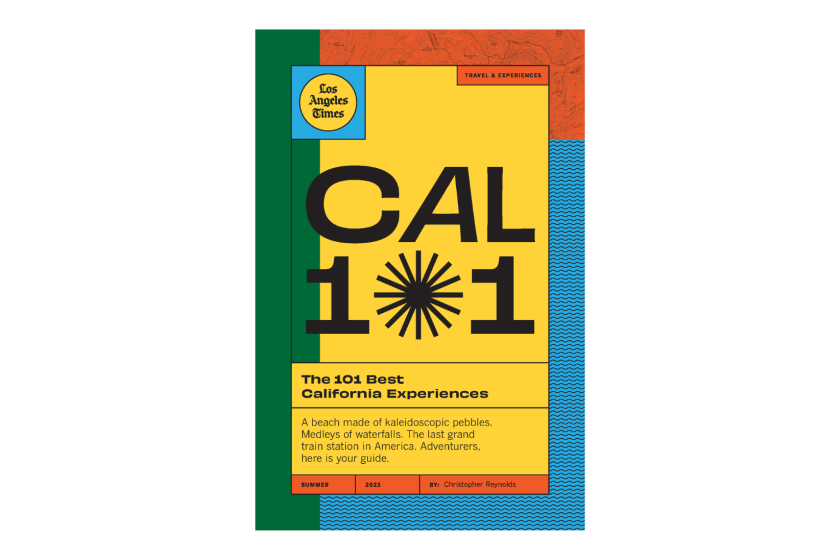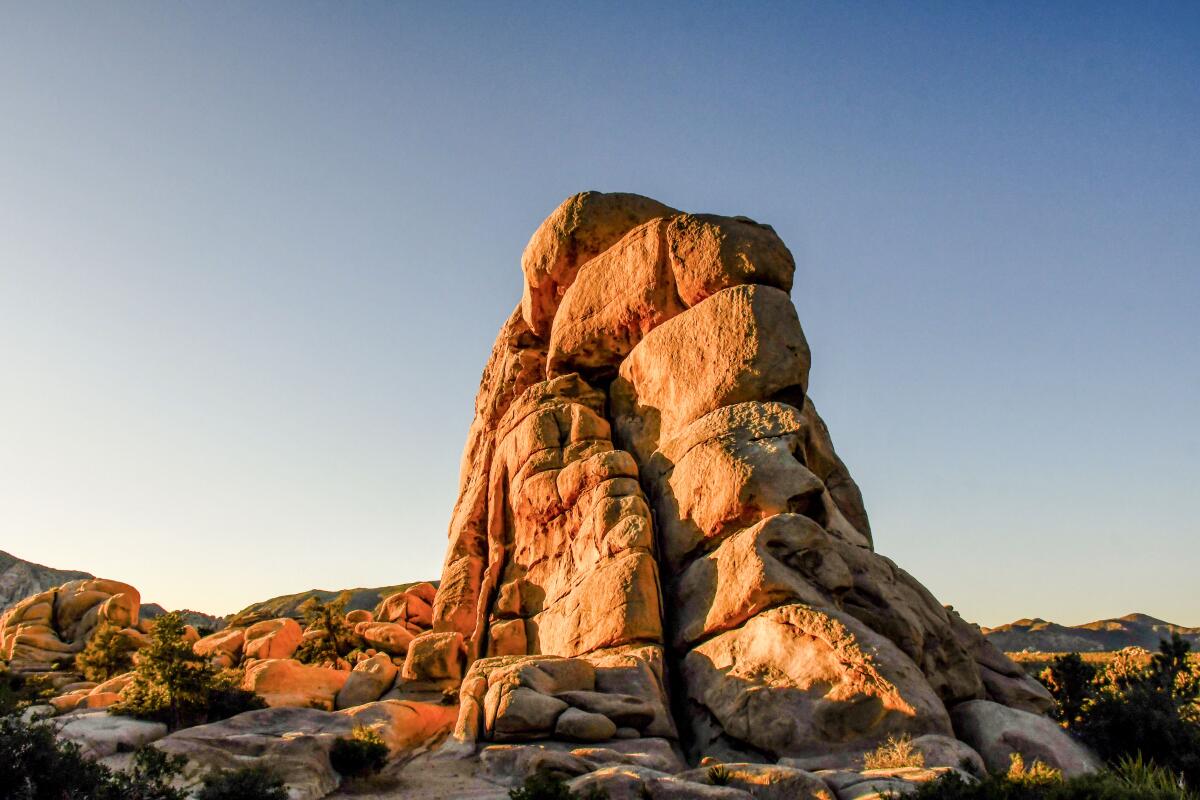The Los Angeles Times; Storyblocks
The 101 best California experiences
- Share via
Look at us. Our mountains are snowier, our hills greener, our waterfalls wetter, rivers fuller and blooms bolder than they’ve been in years.
In this drought-paused, pandemic-restriction-lifted, spring-awakening moment, California needs a good head-to-toe inspection. I know we have plenty of worries, but in four decades of traveling the state, I’ve never seen the landscape looking quite like this.
That’s why I’m here with this year’s 101 best California experiences, your guide to what’s great and what’s different across the state as summer draws near.
For instance, downtown San Diego has a sleek waterfront music venue (No. 85). Cheech Marin has made Riverside (No. 16) a vital destination for Chicano art. And if you can manage a spring road trip between ever-livelier downtown Paso Robles (No. 23) and Cambria’s cool Moonstone Beach (No. 63), you’ll be cruising through Highway 46 hillscapes (No. 40) so verdant your jaw may drop.
In this list, which is in alphabetical order, you won’t find pop-up selfie spots, the Hollywood Walk of Fame or any theme parks (though we have plenty of fresh Disneyland tips over here). Instead, these are all places that speak loudly and deeply to me about what California is, has been and can be. They’re also places that left me wanting more — another visit at a different hour, a little more backstory, a longer conversation with the people involved. Though the big list is in alphabetical order, you’ll see that I’ve earmarked a top 10 among the 101 — couldn’t resist.
Many are gorgeous. Some seem thuddingly obvious yet hold secrets you never suspected. Who knew that California’s biggest sequoia (No. 30) was named after Karl Marx by a doomed group of communist lumberjacks? Or that Cary Grant gave the Norton Simon Museum (No. 70) its best-loved Diego Rivera painting? Or that the Hollywood sign is a year younger than the Hollywood Bowl (No. 41)?
Of course, some of our history is painful, but it’s vital to face up to that too, whether it’s in the barracks at Manzanar (No. 57), under the Coronado Bridge (No. 17) or at the mission cemetery in Sonoma (No. 91).
You may also notice that inflation is at work here. The cost of an Integratron sound bath near Joshua Tree (No. 48) is up. So is the fee at my favorite drive-through tree (No. 15) and dozens of other places. Still, if they’re here, I think they’re worth it. And I’ve tried to add budget options when possible. A few destinations are subject to spring and summer detours in the wake of landslides and floods, including Nepenthe in Big Sur (No. 67) and Yosemite Valley (No. 101).
So here’s to this vast, odd, flawed, spectacular, mutable, seismically unsound piece of real estate that we call California. Like those shiny pebbles slowly becoming sand at Glass Beach in Fort Bragg (No. 32), this state is nearly infinite, forever in transition and ours to explore.
Use our checklist to tick off the things you’ve done and let us know what treasures I missed. In the months ahead, I’ll be following your suggestions.
Now, away we go.
1. Go with the flow on the American River's South Fork

The capital of river rafting in the state is California’s Gold Country and guides say the American River’s South Fork is a perfect spot for first-timers and a solid option for return customers, thanks to its evocative scenery and relatively mild Class II and III rapids. (I’ve done it at ages 11 and 57.) Whether you’re a rookie or not, it makes sense to sign on with a licensed, experienced company; there are more than a dozen, many based in the Coloma-Lotus area.
Family-friendly river floats typically begin north of Placerville, below the Chili Bar Reservoir. One-day floats usually cover 10 miles. Two-day trips, 20 miles. This year, it probably makes sense to let the seasoned river people book the spring trips, when the water will be at its most fierce, with the rest of us following in summer and fall as the flow eases.
Statewide, you’ll find plenty of rafting companies and thrills along the middle and north forks of the American (both more challenging than the south fork) and the Merced, Tuolumne, Stanislaus, Lower Klamath, Kern, Kaweah and Truckee rivers. On the American River’s South Fork, half-day and all-day rafting trips typically cost $125 to $175 per person. This year’s season is likely to run April through September or October.
Bonus tip: Less than 10 miles from the South Fork’s Chili Bar put-in, you’ll find Marshall Gold Discovery State Historic Park, where the Gold Rush began. Placerville, the nearest town to the rafting, has a pleasant selection of restaurants and shops along its historically outfitted Main Street.
2. Hike to the outpost where immigrants waited on Angel Island
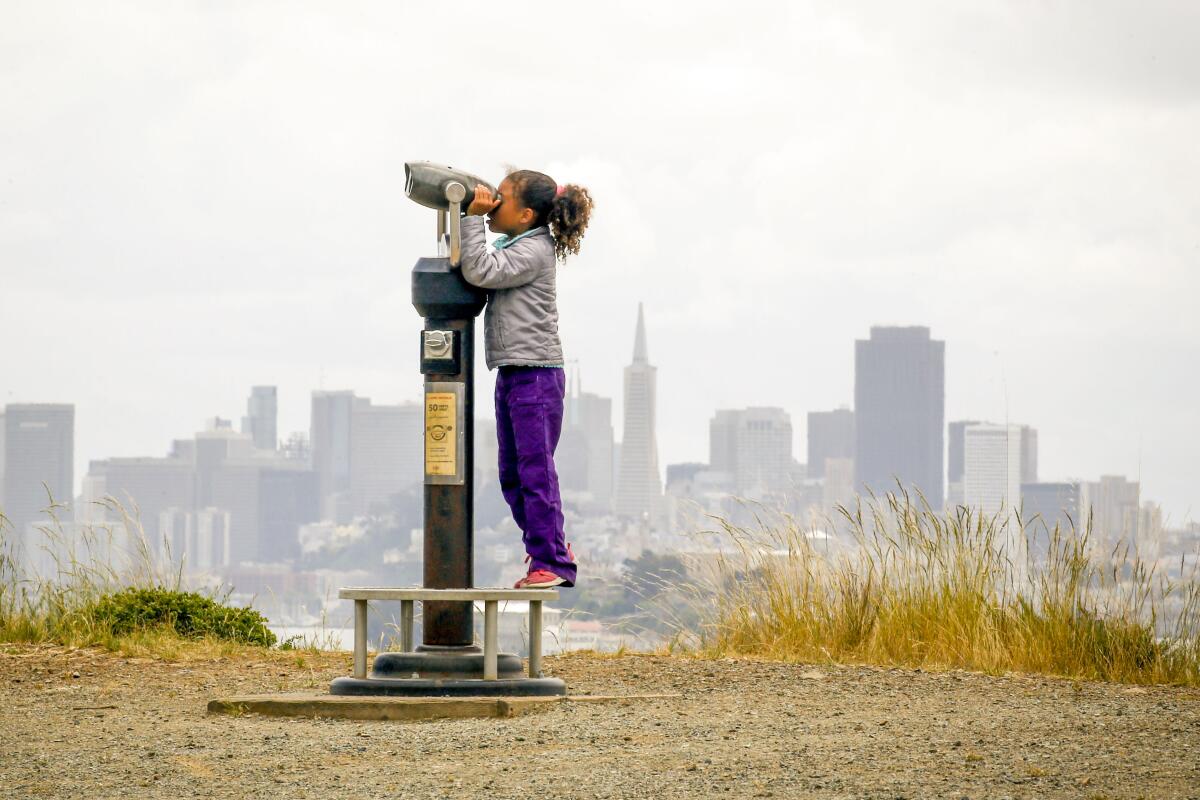
To get to this 740-acre island, make your way to Tiburon — a handsome, upscale, waterfront Marin County town of about 9,000 — and catch a 10-minute Angel Island Ferry ride to the island’s Ayala Cove. (Be sure to check the schedule in advance. The ferries, $17.40 for adults round-trip, run four to five days a week in warmer months.)
Near the dock you’ll have a chance to rent a mountain bike and you’ll see the Angel Island Cafe, which usually serves lunch Thursday through Sunday in warmer months but has been reduced by winter storm damage to selling prepackaged snacks and drinks. (The Angel Island Cantina is closed indefinitely.)
To reach the history, start walking. From 1910 to 1940, this island was the U.S. entry point for about half a million Asian immigrants, including 175,000 from China, who typically spent weeks or months locked in barracks before being allowed to enter. Some etched poetry on walls. To see it and learn more at the Immigration Station and barracks, it’s a 1.5-mile walk from the Ayala Cove ferry landing.
You can enter the barracks, which are part of the Detention Barracks Museum, open Wednesday through Sunday ($5 per adult). In the same compound, you can also visit the fledgling (and free) Angel Island Immigration Museum in the island’s old hospital, open Wednesday through Sunday. Hours for both museums are 11 a.m. to 2:30 p.m. Wednesday through Friday, 11 a.m. to 3:30 p.m. Saturday and Sunday.
Bonus tip: There are boats from the San Francisco Ferry Building too. The Golden Gate Ferry offers service daily, $14 each way; the ride takes 30-50 minutes.
3. Stop among poppies in Antelope Valley
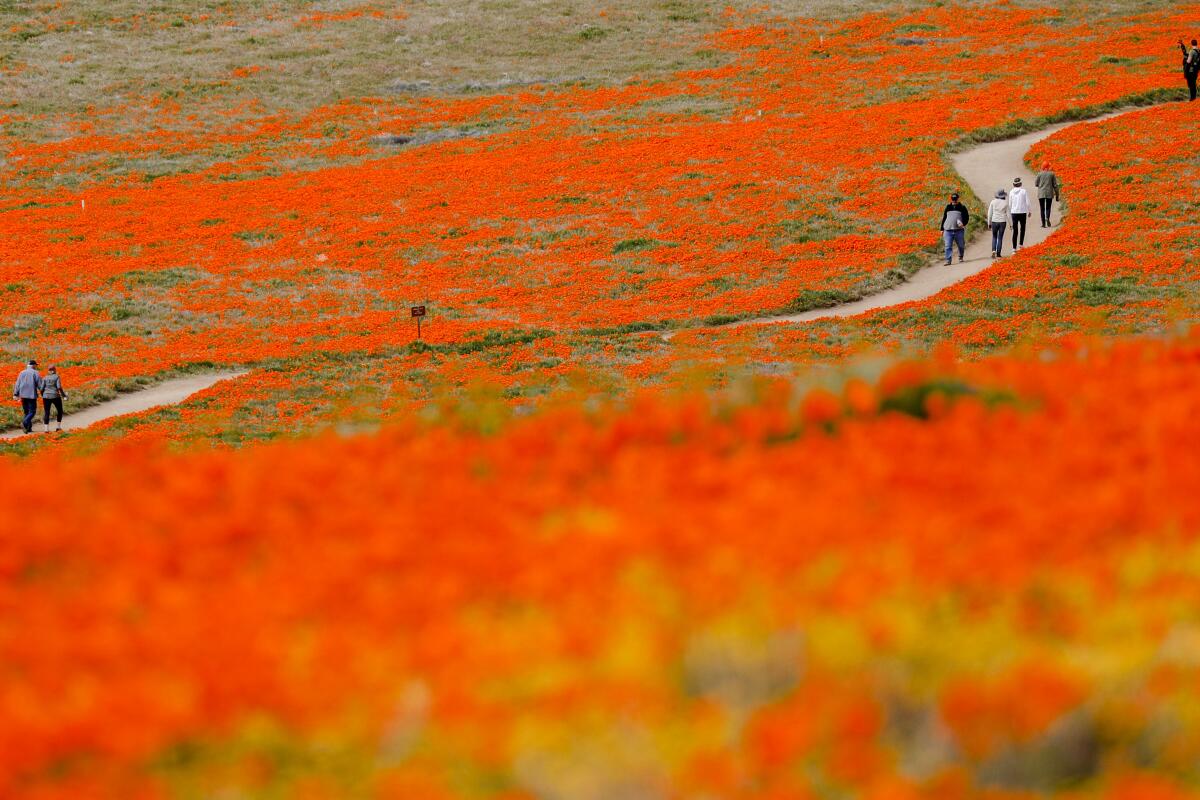
This 1,781-acre preserve ($10 per car to enter) includes seven miles of broad, smooth paths for walking among the flowers. (A portion, just west of the visitor center, is wheelchair-accessible.) No dogs, no drones, no poppy picking or off-trail tromping. But you can channel your inner flower child: Lead your friends to a high spot, such as Antelope Butte Vista Point to the east or Tehachapi Vista Point to the west, then casually mention that Eschscholzia californica has been the state flower since 1903.
Bonus tip: In years like 2019, when a superbloom attracted thousands of visitors, the reserve’s parking lot isn’t nearly big enough. In milder years like 2022, it’s not so bad. Bear in mind that many poppies bloom on roadside slopes outside the reserve. If you can do so safely, legally park on a shoulder along or near Lancaster Road and you might save $10.
4. Tiptoe across the dry bed of Badwater Basin in Death Valley

Badwater Basin, a crusty old lake bed between forbidding mountains, is the lowest, driest and often hottest point in North America. It’s especially vivid and perplexing just after sunset when there’s a prominent moon — because how can there be a moon above and another lunar surface underfoot? Listen to the crystals crunch as you walk. Also, get up early for at least one sunrise, maybe at Mesquite Flat Sand Dunes, maybe Zabriskie Point. (Scotty’s Castle, once a favorite stop, is closed indefinitely after flooding and a fire.) If you’re ready to splurge, the Oasis at Death Valley resort’s Inn at Death Valley has 88 rooms and casitas and a spring-fed swimming pool that’s always 87 degrees.
Bonus tip: The road will rattle your bones, but if you take a four-wheel-drive vehicle with high clearance on the 26-mile journey to the Racetrack, the rewards are great and strange. It’s another dry lake bed, but in this one, wind and low temperatures occasionally combine to mysteriously scoot rocks across the vast, white plain. The resulting tracks look like skid marks of the gods.
5. Inspect the nooks and crannies of Balboa Park
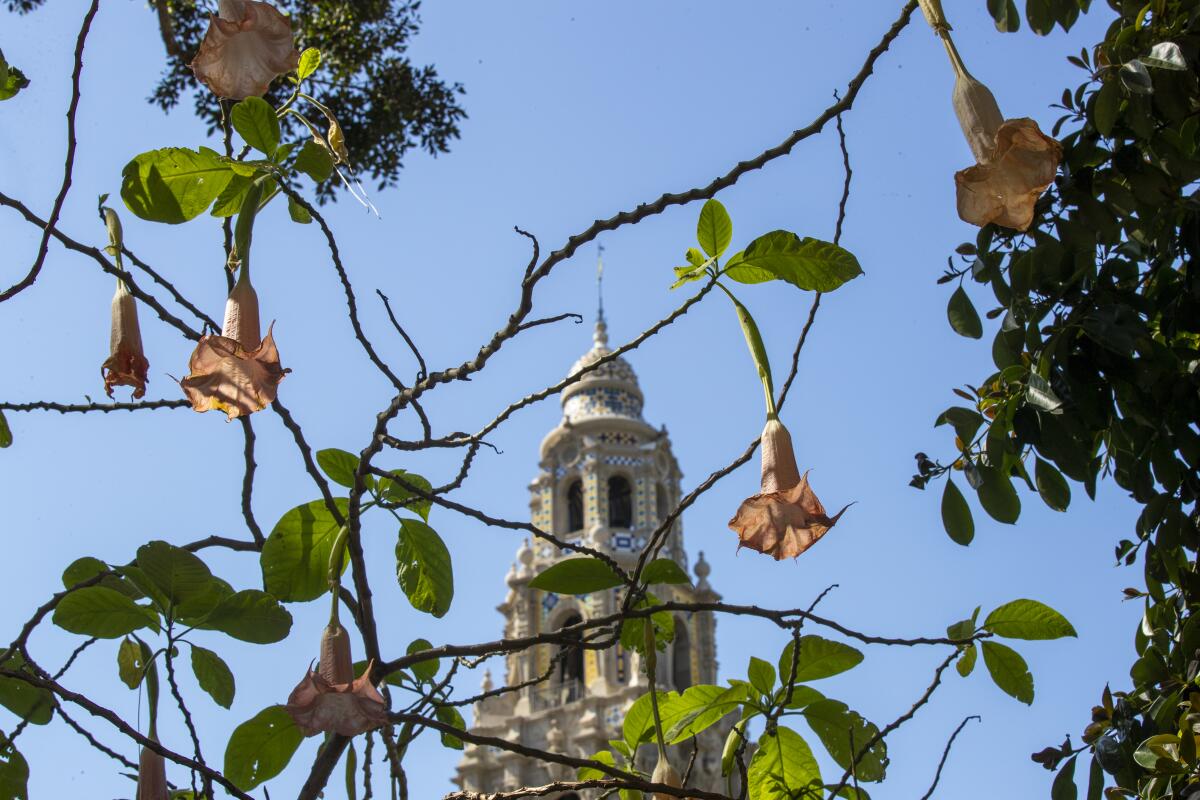
The park also is home to about 20 museums and cultural organizations featuring fine art, folk art, photography, natural history, anthropology, flight and all the imagined worlds that come with Comic-Con (which opened a museum here in 2021). The Old Globe theater complex includes three venues. Yet to feel the park’s full embrace, you don’t even need to go inside. Flop on the lawn at the big lily pond by the Botanical Building (which is due to reopen after renovation this year). Sip tea and linger in the Japanese Friendship Garden. Try lunch al fresco at the Prado restaurant. Chase butterflies in the Zoro Garden and try to imagine the “nudist colony” that boosters staged to lure more visitors into the park’s 1935 exposition.
Bonus tip: When you’re ready to go back inside, check out the miniature landscapes in the San Diego Model Railroad Museum — an underexamined treasure for decades — and the global reach of the Mingei International Museum, which focuses on global folk art and completed a $55-million renovation in 2021.
6. Forage for masterpieces at Bart's Books

Books lost in the wet winter of 2022-’23? “None,” said manager Matt Henriksen. “We’re set up to deal with all of that.” The indoor portion of Bart’s is a converted house, with cookbooks in the kitchen and art and design books in the former garage. (There’s a rare book section too.) The shop is open daily from 10 a.m. to 6 p.m., but you can browse anytime: Since long before the advent of the little free library, Bart’s has stocked hundreds of used books on shelves along its exterior walls, available for purchase on the honor system. The shop’s full inventory, currently about 130,000 books, once was all used, but now Bart’s stocks many new titles as well. The store also hosts occasional readings in its courtyard and sells cold beverages.
Bonus tip: On the used books, prices are marked in pencil on the upper right corner of the first blank page. Average price: about $8.
7. Live well on Bell Street, Los Alamos
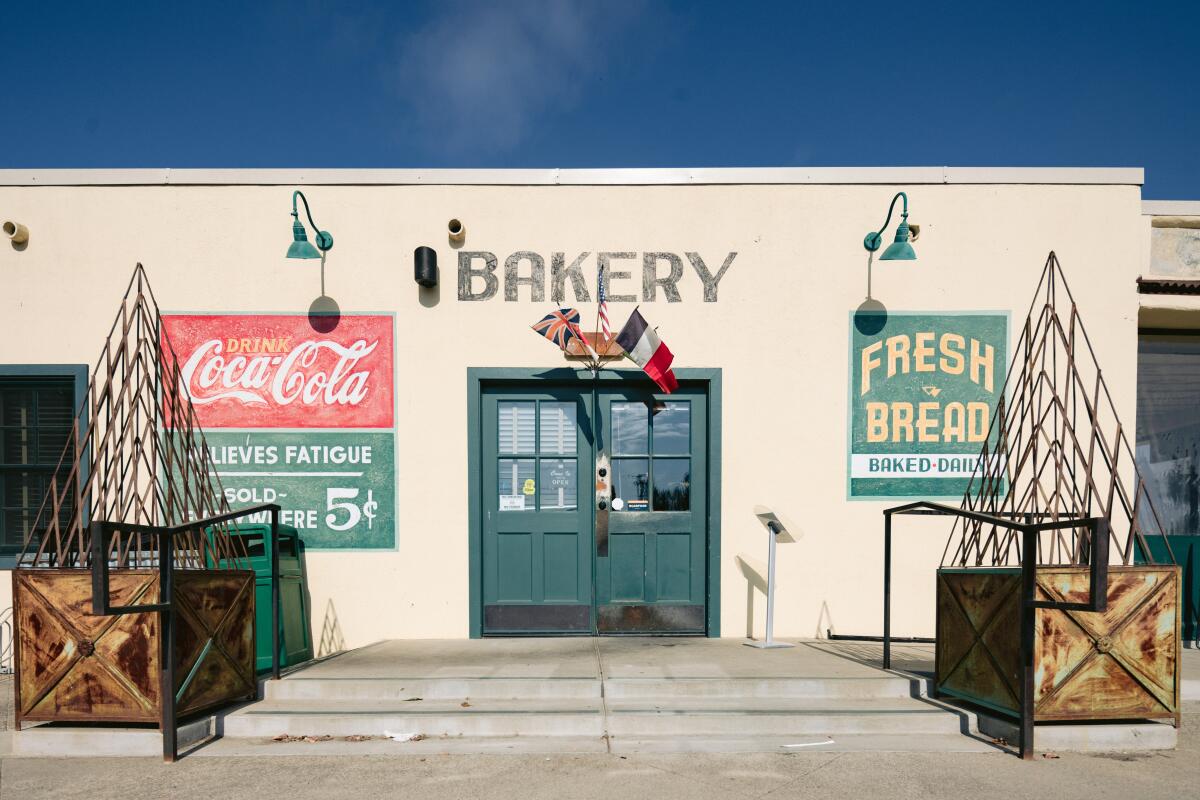
Be warned that much of the town is closed Tuesday and Wednesday. But Bell Street, the main drag, has an Old West feel, several stylish restaurants, a handful of tasting rooms and a few antique shops. Bell’s Restaurant, whose bistro fare has won a Michelin star, offers wild snails and a $90 prix fixe dinner menu Thursday through Monday. (It also does lunch on those days.) Want to take a wine-tasting tour by motorcycle sidecar? Yes, somebody offers that.
Bob’s Well Bread Bakery and Plenty on Bell are popular for breakfast and lunch; Full of Life Flatbread does big dinner business. The menu at Pico (that’s the building with the “GENERAL STORE” sign out front) includes salmon tartare with seaweed and hanger steak with house chimichurri.
You could stay at a trendy motel (Alamo Motel) or a Victorian bed-and-breakfast with elaborately themed rooms (Victorian Mansion). If you’re splurging, the hilltop Skyview Los Alamos may be the answer. Several restaurants in town also rent cottages through Airbnb, including Bob’s Well Bread Bakery, Bodega Wine and Beer Garden and Pico.
Bonus tip: If it’s exclusivity you’re aiming for (or a destination wedding you’re planning), the 1880 Union hotel is a historic property that no longer rents out individual rooms. If you want in, you have to book all nine rooms for your group.
8. Greet the end of everything at Bombay Beach
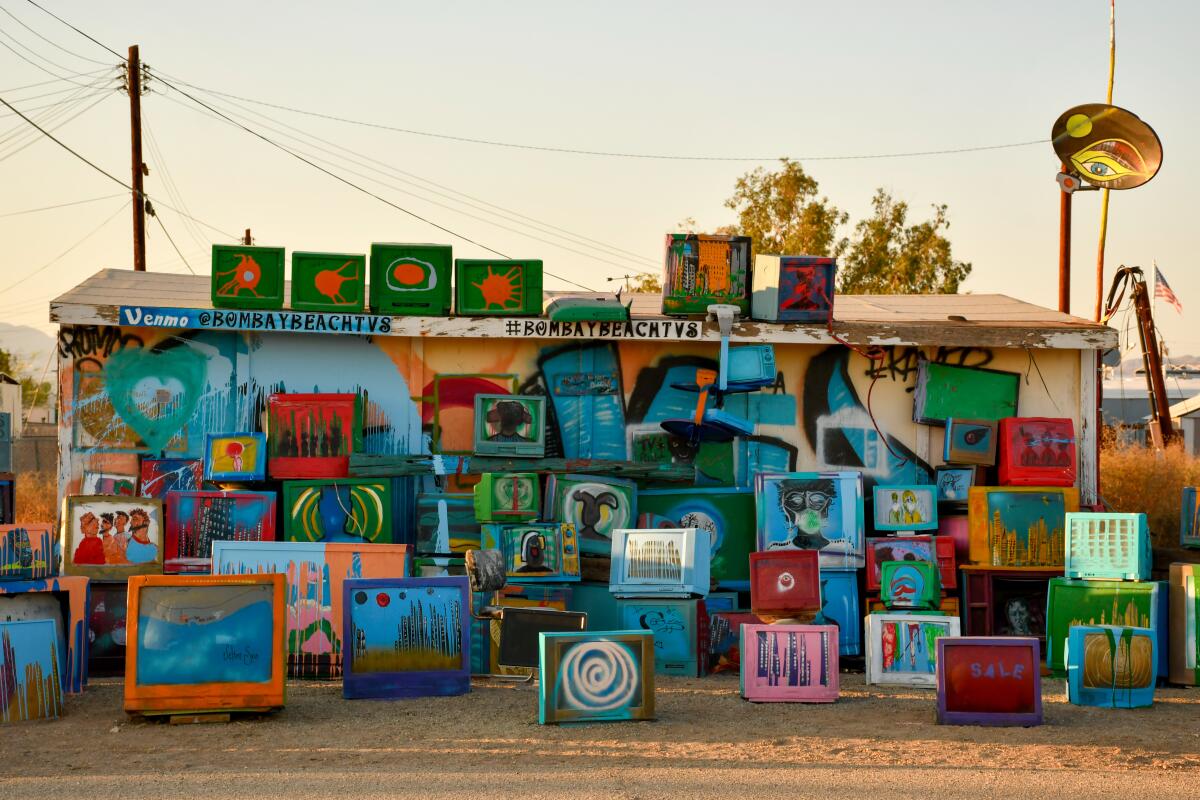
This was a mainstream vacation destination 70 years ago, when the sea (created by an irrigation canal mishap in 1905) was healthier. Now Bombay Beach is a grid of 32 square blocks with perhaps 300 residents. It has a single bar/restaurant, the Ski Inn (usually open 10 a.m. to 2 a.m.), a market and more than 20 Airbnb units, but not everyone will want to spend the night.
Anyone intrigued by the rebel spirit and raw creativity at nearby Salvation Mountain, East Jesus and Slab City will be right at home among the art and artists of Bombay Beach.
There’s a Bombay Beach Biennale every year (yes, that’s on purpose), which is really fancy talk for the January-March spell when artists and other part-time residents converge to make things and stage events. Don’t miss the plane standing on its nose at 1st and H (“Lodestar” by Randy Polumbo) or the painted televisions at 4th and H. Near sunset, cross the five-foot berm between the community and the seashore (5th and E) to behold the most dramatically sited sculptures and installations, baking and crumbling under that big desert sky.
Bonus tip: Several installations are lighted after dark.
9. Stare down a serpent in Borrego Springs
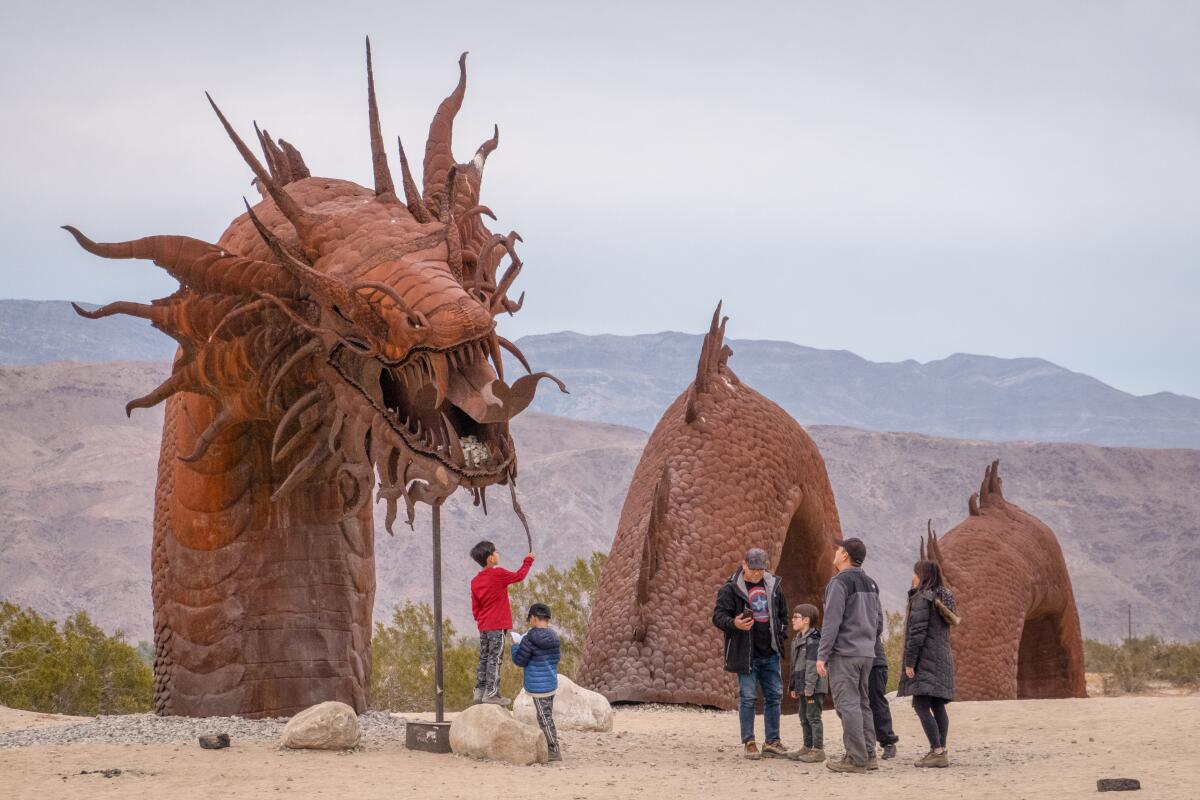
Breceda, a Southern California sheet-metal sculptor commissioned by local philanthropist Dennis Avery, has since 2008 placed about 130 metal works in the flatlands around the hamlet of Borrego Springs, a getaway for desert lovers who think Palm Springs and Joshua Tree are way too busy. Breceda’s works include dinosaurs, a scorpion the size of a Subaru and the artist’s magnum opus, a fearsome, whiskered, half-submerged serpent of the sand.
That 350-foot-long serpent — actually a medley of five segments rising from the sand — lies along Borrego Springs Road, 2.3 miles north of Christmas Circle. For a sculpture map, stop by the Anza-Borrego Desert Natural History Assn. store near Christmas Circle.
Before or after beast-hunting, lie low at Casa del Zorro, cruise along Palm Canyon Drive (Borrego Springs’ main drag), get a cool beverage at Carlee’s or see what’s on the walls at the Borrego Art Institute. Then take a hike.
Anza-Borrego Desert State Park, California’s largest, surrounds Borrego Springs. Most hikers head first for the Borrego Palm Canyon Nature Trail (three miles round-trip), whose palm grove is handsome, though recovering from an arson fire in early 2020. There are campgrounds for tent people and RV people. Nonhikers browse the park visitor center and check out the desert pupfish in the pond at the Palm Canyon trailhead. Photographers rise early and take their four-wheel-drive vehicles up a four-mile dirt road to catch the sunrise badlands panorama from Font’s Point.
Bonus tip: The stars after dark may amaze you. Borrego is one of about 40 locales globally to be designated an International Dark Sky Community, a prime place for stargazing and night-sky photography.
10. Bathe in spray from Burney Falls
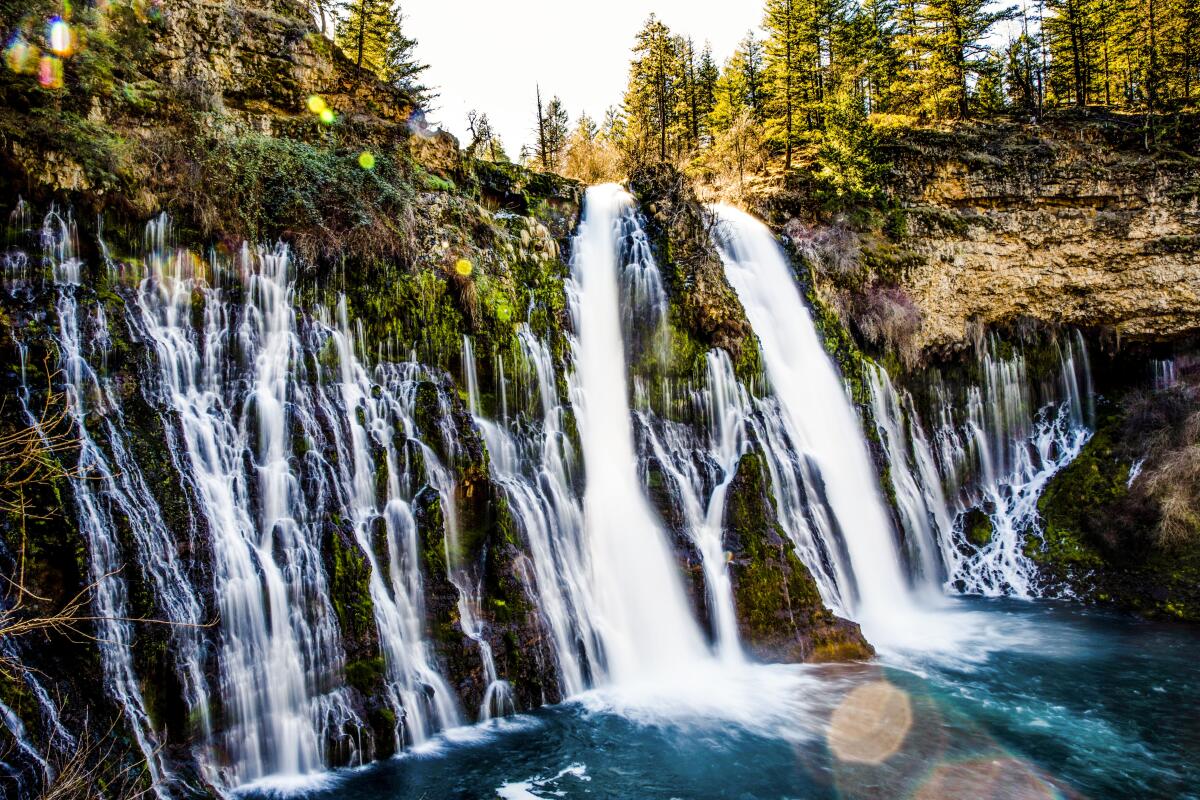
The falls are 129 feet high, with a wide, thundering cascade. You find them at McArthur-Burney Falls Memorial State Park, about 65 miles northeast of Redding ($10 to enter). First you confront the water from across a gorge, then descend by trail to feel the roar and mist from closer quarters.
The park includes several miles of trails (including a segment of the Pacific Crest Trail) — but after so much snow and rain this winter, some are likely to be closed by erosion.
Bonus tip: If you’re still wondering about the three other cascades in the area, continue to McCloud Falls. It’s a series of three cascades, all within easy hiking distance, about 45 miles northwest of Burney Falls along California 89.
11. Ride standing on a San Francisco cable car
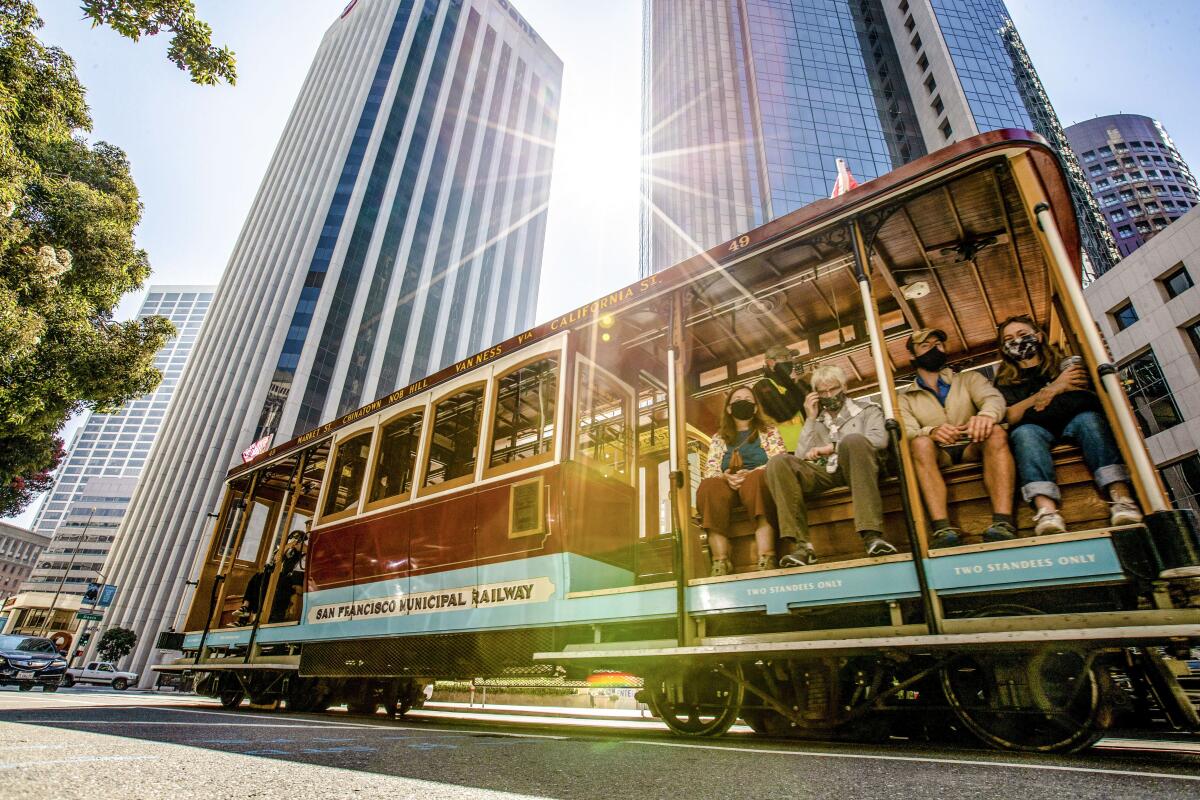
For maximum thrills, you want pole position, standing on a running board with a hand-hold on the pole at the right front of the car. Unless, of course, you have the opportunity to give that spot to a bright-eyed kid.
The cable cars cover three routes: Powell-Hyde, Powell-Mason and California Street. As a newbie, you’d want Powell-Hyde, beginning at Powell and Market streets (where there’s often a queue, along with buskers and panhandlers). Over hills and around corners you’ll ride to Fisherman’s Wharf. The brakes will squeal. Somebody over 60 will make a Rice-A-Roni joke. From the top, spy twisting Lombard Street and Coit Tower to the east, Alcatraz in the bay ahead.
On arrival, grab Irish coffee at the Buena Vista on Beach Street or venture into the tourist extravaganza that is Fisherman’s Wharf. Fare is $8 one-way in advance (which is a poor value) or $13 for a one-day Muni Visitor Passport through the MuniMobile app. Alas, that passport won’t work on BART. But it will give you a day of travel on cable cars, historic streetcars and other Muni and Muni Metro transit.
For the story on how your ride traces back to 1873 and a man named Andrew Hallidie, head to the free Cable Car Museum in the old Washington-Mason powerhouse and car barn on Nob Hill.
Bonus tip: For a mellower ride with fewer tourists and great views down to the Bay Bridge, try the California Street line. And if you get hungry, the Tadich Grill (240 California St.) calls itself the oldest continuously operating restaurant in California. It began as a coffee stand run by Croatian immigrants in 1849. Now it specializes in seafood, especially cioppino. Lunch and dinner on weekdays. Dinner on Saturdays. Closed on Sundays.
12. See how California Christianity and colonization got started in Carmel
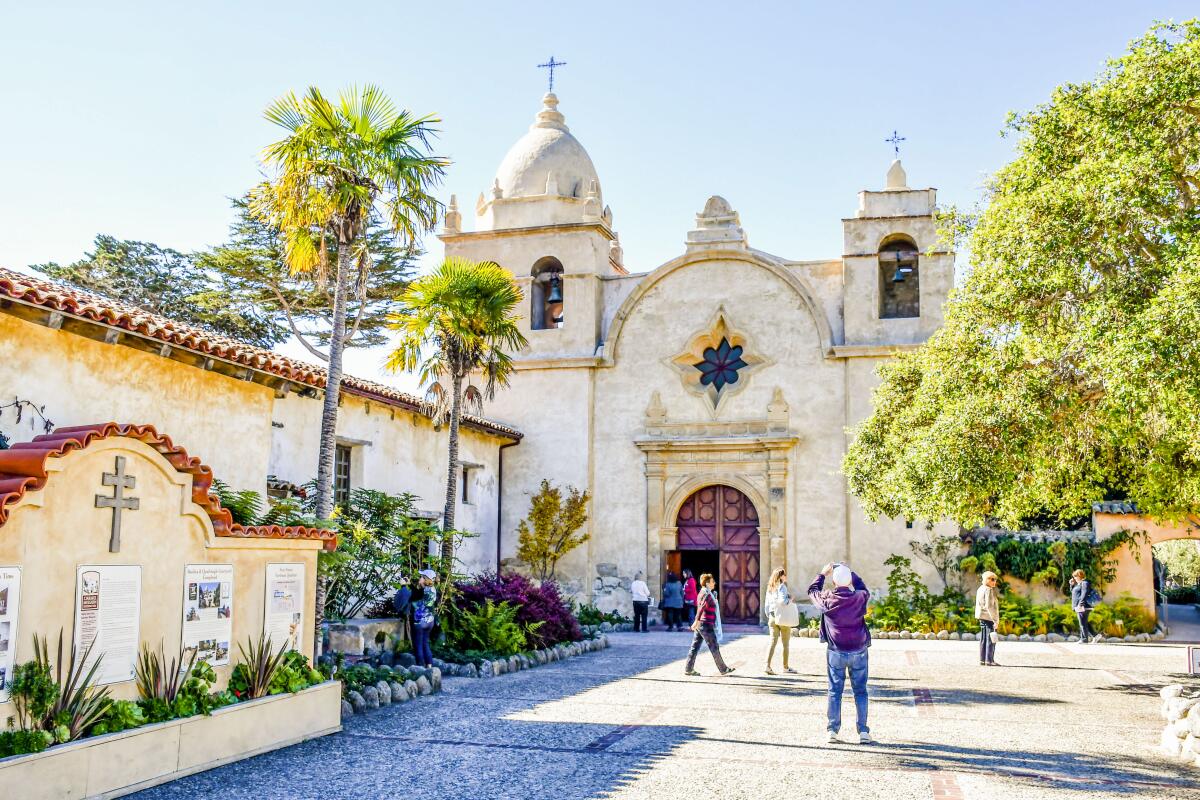
The Carmel Mission, officially San Carlos Borromeo de Carmel Mission, includes a basilica, museums and a courtyard, and it’s still home to an active parish. The rooms include a reconstruction of the cell where Serra is said to have died in 1784. The Spanish missionaries brought Christianity, literacy, Mediterranean architecture and a new economy, but at great cost. Many historians now focus on how Indigenous Californians were exploited and violently repressed throughout the system’s rise and fall under Spain, Mexico and then the U.S. Many of these Indigenous people are buried in the mission cemetery.
Bonus tip: The first of the Alta California missions (founded 1769) still functions in San Diego; the last (1823) is part of a state historic park in Sonoma. The most-visited one might be Orange County’s Mission San Juan Capistrano, which has ruins, gardens and its own Amtrak stop. The one at La Purísima State Historic Park near Lompoc includes horses, steers and sheep.
13. Cross the sea to Catalina
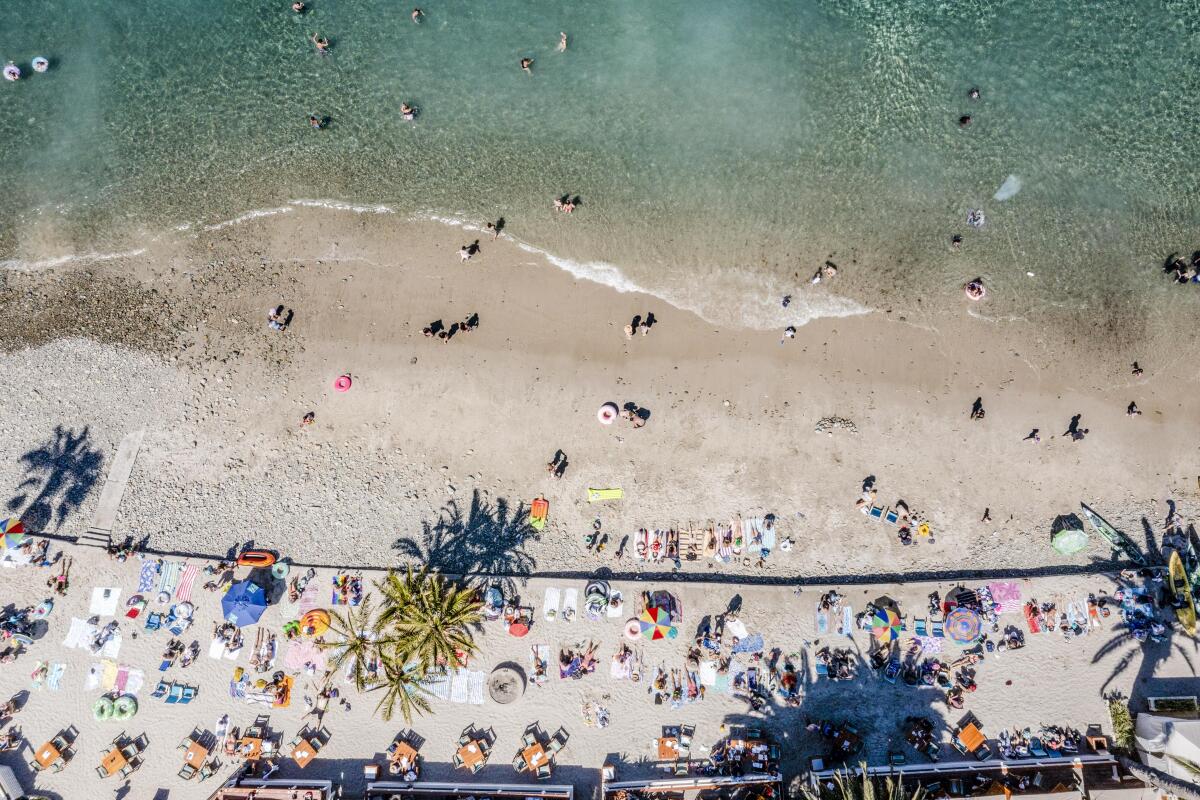
Back in the day, author Zane Grey wrote westerns here and chewing gum potentate William Wrigley Jr. built a mansion (Mt. Ada, with room rates at potentate prices). Nowadays there are just enough options in Avalon to fill a weekend, including hiking, biking and eco-tours through the nonprofit Catalina Conservancy. The Catalina Island Co., which dominates the island tourist trade, can point you to glass-bottom boat rides, submarine tours, snorkeling, miniature golf, cycling, the Descanso Beach Club, a ropes course and the Catalina Zipline Eco Tour, which will set you zinging above eucalyptus trees. Round-trip ferry rides with Catalina Express to Avalon from Long Beach, San Pedro or Dana Point cost $83.50 to $87.50 for adults.
Bonus tip: There’s more hiking and camping near Two Harbors, including a 38.5-mile, four-day adventure known as the Trans-Catalina Trail. You begin in Avalon and end at Two Harbors, the island’s second port. On your way, beware of bison.
14. Study César Chávez’s story in the Tehachapis
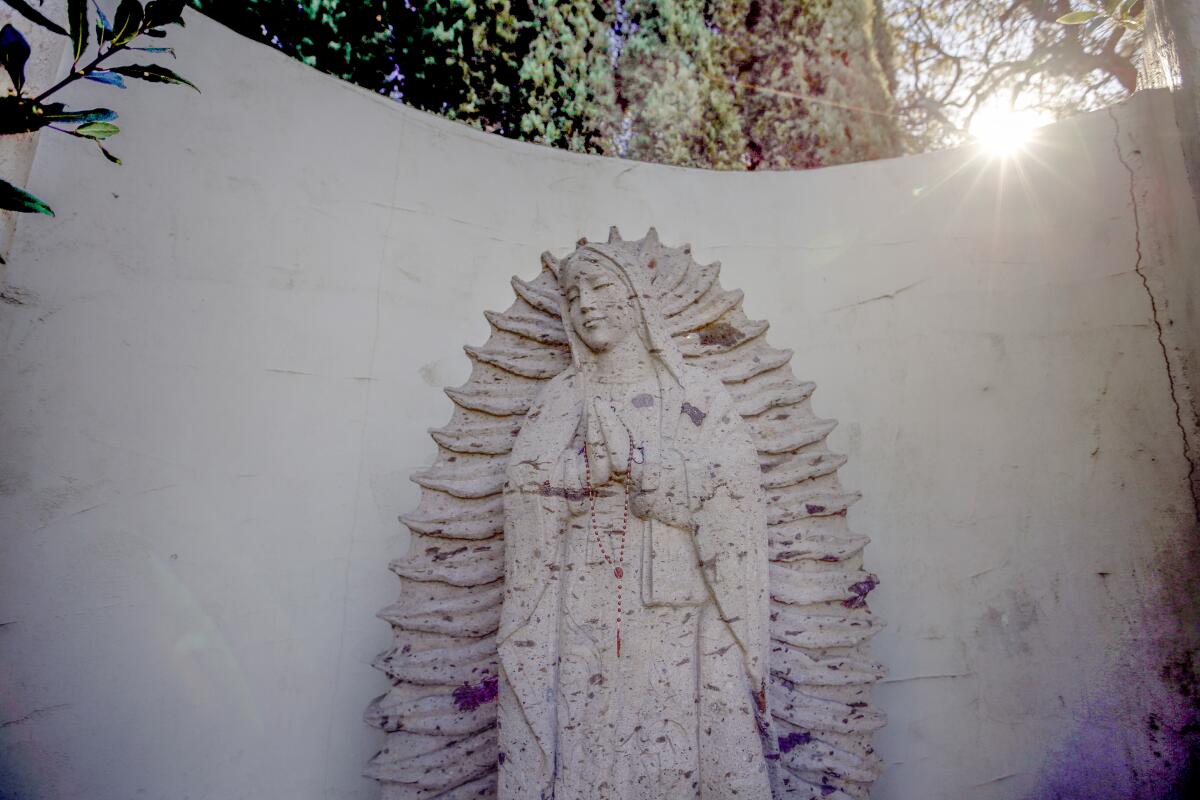
Chávez, born in Yuma, Ariz., might be the most influential labor leader in California history. The national monument’s visitor center — set in a hillscape that gets luminously green after substantial rains — is managed by the National Park Service and the Chávez Foundation, which runs the 187-acre compound that includes the center.
The visitor center offers biographical videos, a re-creation of the labor leader’s office, a memorial garden and exhibits detailing the many causes Chávez pursued. Admission is free.
For breakfast or lunch, try the Keene Cafe half a mile west of the monument on Woodford-Tehachapi Road. Or pause in the town of Tehachapi, about 11 miles southeast of the monument, for a stroll and a snack at Kohnen’s Country Bakery.
Bonus tip: Just 3.2 miles east of Keene, you can see a marvel of railway engineering that draws fans from around the world. From an overlook on Woodford-Tehachapi Road, you can see the Tehachapi Loop, a 3,800-foot section of railroad track built by Southern Pacific engineers and Chinese immigrant laborers in the 1870s and still used by freight trains daily. Employing bridges and tunnels, the route makes a spiral as it climbs a 2.2% grade. Any train 4,000 feet or longer will briefly pass over its own rear cars in the tunnel 77 feet below.
15. Steer carefully at California’s foremost drive-through redwood
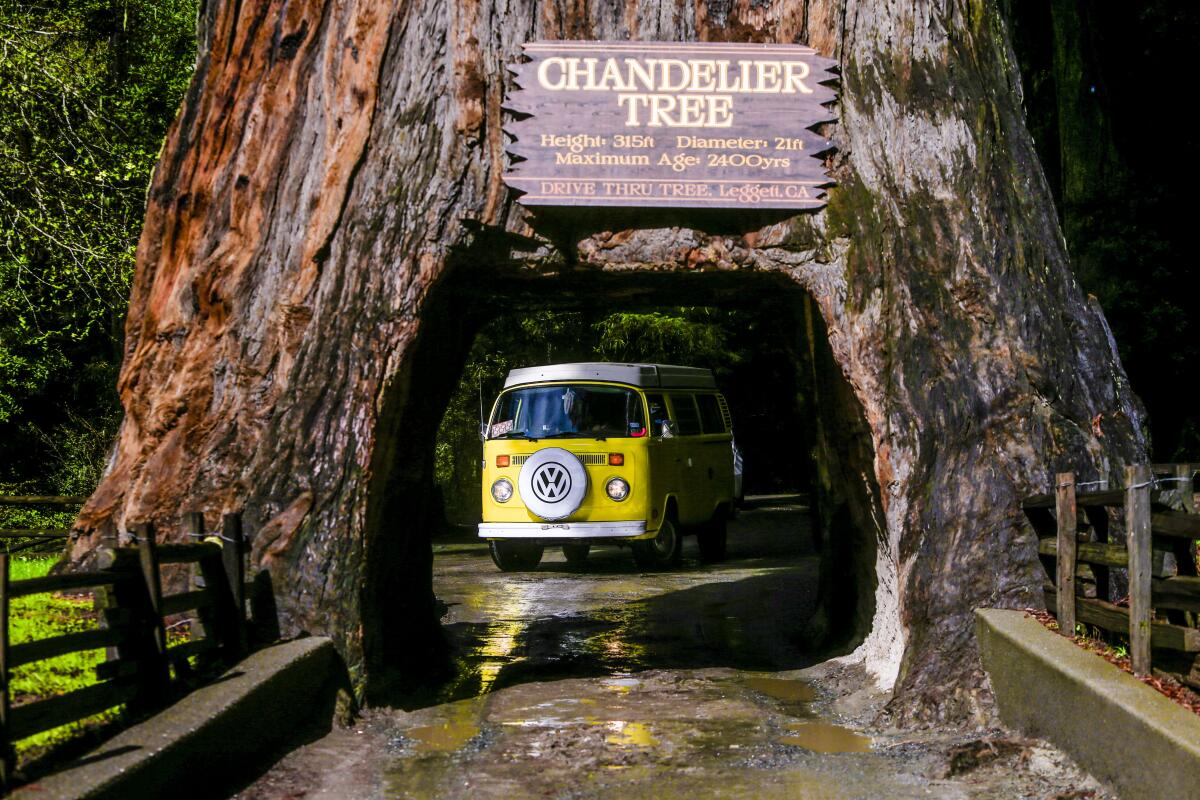
Then go deeper. About 30 miles farther north on U.S. 101, you’ll reach the 31-mile-long Avenue of the Giants, a corridor of natural wonder and roadside kitsch that includes Humboldt Redwoods State Park. There, you can inspect the magnificent 370-foot-long corpse of the Dyerville Giant, once thought to be the world’s tallest tree.
Bonus tip: Before you drive through the tree, tuck in your mirrors.
16. See the Cheech
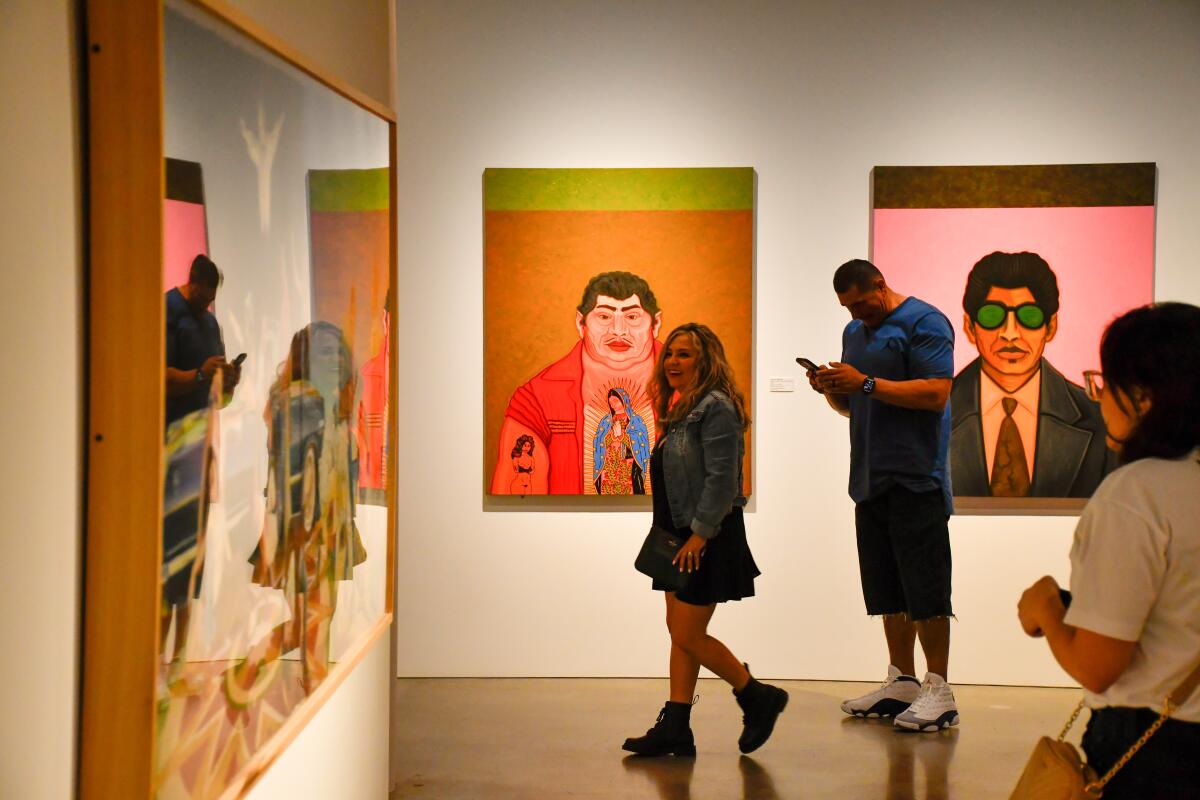
Other artists here include Carlos Almaraz, Margaret Garcia, Wayne Alaniz Healy, Judithe Hernández, Gilbert “Magú” Luján and Patssi Valdez. Just about every piece was made since 1965, and scores were collected by actor-comedian Cheech Marin, who has lent and donated them to make the center possible. Many works address simmering social issues. And with their saturated colors and thick brushstrokes, many look like they’re still wet. Adult admission is $15.95, which also gets you into the Riverside Art Museum building across the street.
Bonus tip: Riverside has no original Franciscan missions, but it has the Mission Inn, a gargantuan Mission Revival hotel that dates to the 1870s and fills a city block, with 238 guest rooms, a spa, several restaurants, all manner of European architectural flourishes and an immensely popular winter Festival of Lights. Richard and Pat Nixon married here in 1940. Overnight stays start at $229.
17. Gaze at the murals of a movement — beneath a bridge
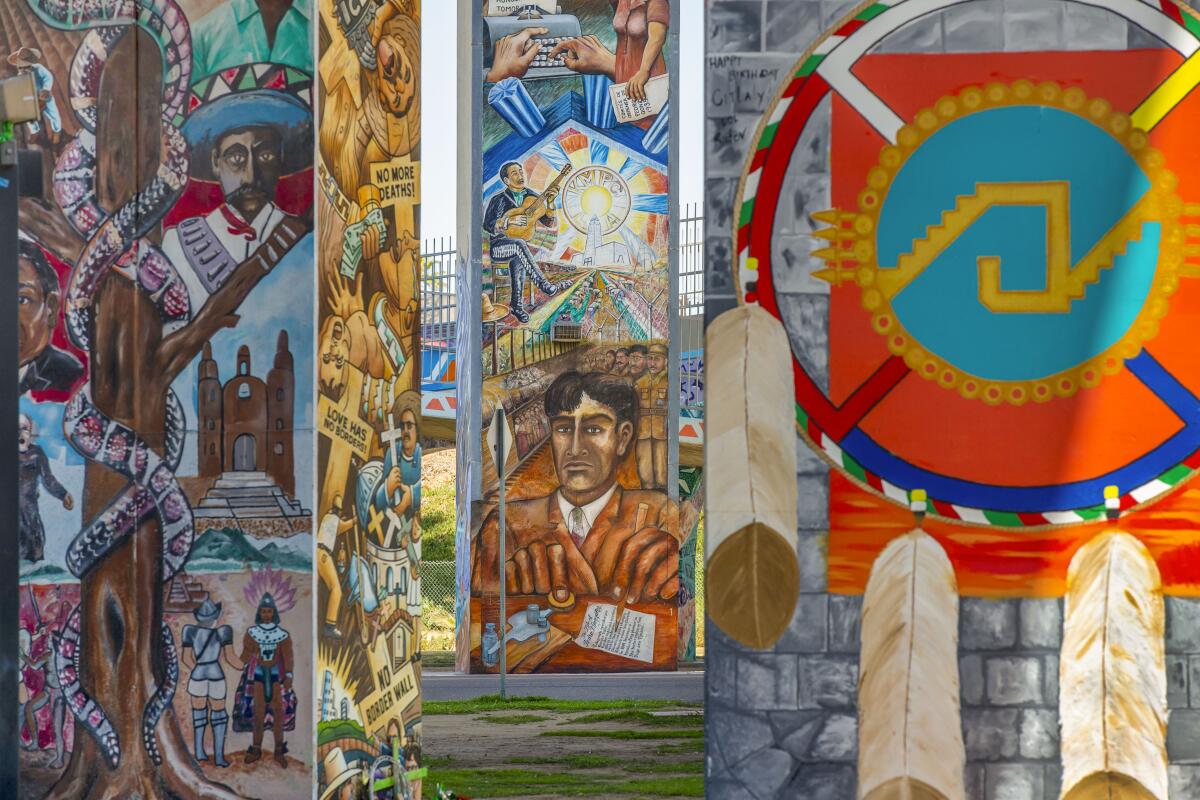
When state and local officials expanded Interstate 5 through San Diego and built the Coronado Bridge in the 1960s, they split the blue-collar neighborhood of Barrio Logan. Then in 1970, when the California Highway Patrol started building an office where a park was expected, the neighbors rose up, occupied the site for 12 days and at last got a 7-acre park set aside. Soon after came the murals, followed by restaurants, galleries and the barrio’s designation as a cultural district. Now there are more than 80 murals, some celebrating Mexican icons such as Pancho Villa and Frida Kahlo. In 2016, federal officials added the park to the National Register of Historic Places, crediting artists Salvador Torres, Mario Torero, Victor Ochoa and others. In October, the Chicano Park Museum debuted next door. It’s open Friday-Sunday, 11 a.m. to 5 p.m.
Bonus tip: Within two blocks along Logan Avenue, you can get flautas at Las 4 Milpas, tacos at Salud! and beer at Border X Brewing.
18. Roam among blooms in Chino Hills State Park
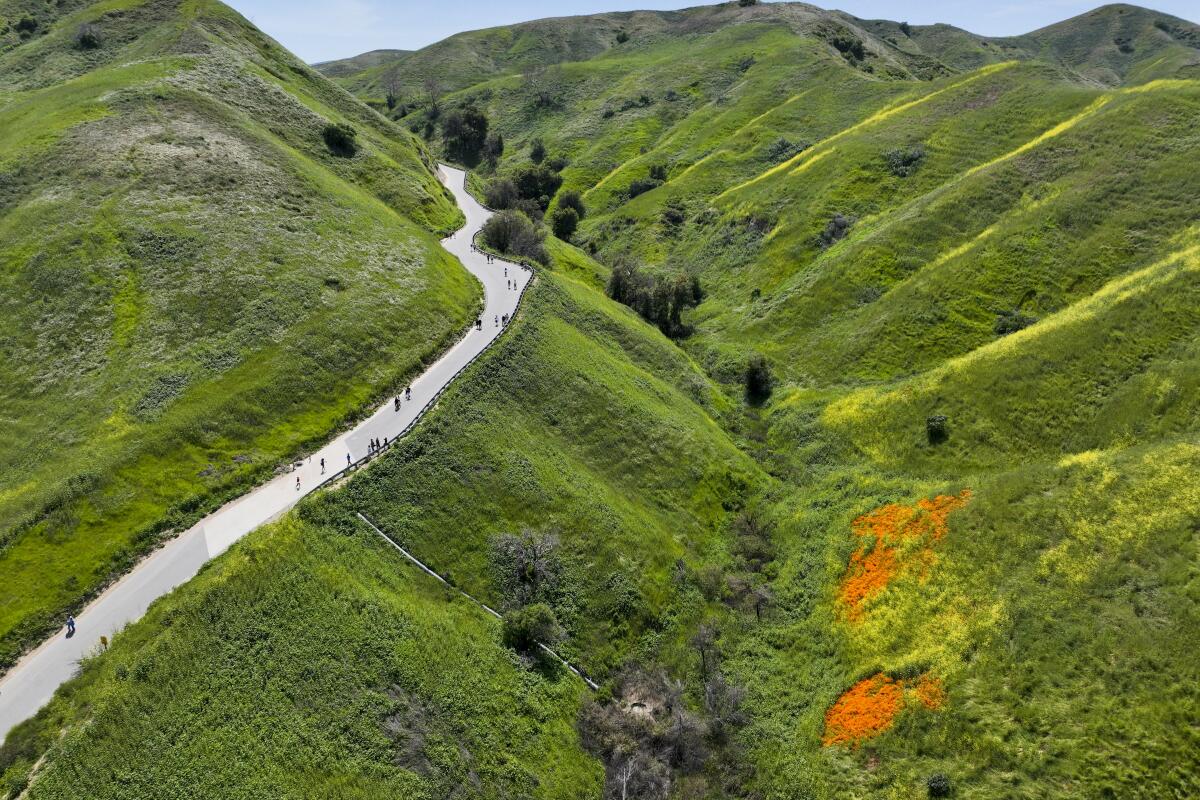
Stay alert as you’re hiking — the park’s 90-some miles of trails are also open to equestrians and cyclists. We took Bane Canyon Road into the park, left our car in the lot at the day-use equestrian area and hiked about two miles out and back on the Bane Ridge Trail. Wide views, abundant flowers and grasses. The park opens at 8 a.m., closing at 7 p.m. from the first Sunday in April through Sept. 30, 5 p.m. from October through the first Saturday in April. Admission is $10 per car. There’s no flower-picking allowed. (And if that’s not enough discouragement, consider this before you reach down: There are rattlesnakes.)
Bonus tip: Barely two miles north of the park entrance, just off Highway 71, you may glimpse the towers and domes of a striking Hindu temple, known as the BAPS Shri Swaminarayan Mandir. The building complex combines Italian marble and Indian pink sandstone. It welcomes visitors and has a tasty restaurant. Also, its shop sells all sorts of Indian spices and other ingredients.
19. Get your fill of country blues and hot chili at the Cold Spring Tavern

OK, no one is making stagecoach stops at all. Which is all the more reason to stop at the Cold Spring Tavern. It’s tucked along the roadside on San Marcos Pass above Santa Barbara, and for decades it has been uniting bikers and dressed-down upper-crusters. Built in the 1880s, it’s heated in part by four stone fireplaces. Lunch options include three distinct flavors of chili, all time-tested. Yes, you can order a sampler.
The fanciest part of the property is its dimly lit restaurant interior, where buffalo, venison, duck and boar often turn up on the menu for Friday and Saturday dinners (served 5-8 p.m., reservations required). Lunch is served Monday, Thursday, Friday and Saturday. The tavern’s Log Cabin Bar, a rustic indoor-outdoor operation, features live music and tri-tip sandwiches on Saturday and Sunday afternoons.
Bonus tip: Acoustic blues specialists Tom Ball and Kenny Sultan, who have the Sunday music slot most weeks, have been playing the Cold Spring for more than three decades.
20. Join the gold rush in a town out of time

It’s the state park system’s largest collection of Gold Rush-era buildings, with restaurants, saloons (heavy on the sarsaparilla), retailers, a museum, hotels and cottages, a gold-panning operation (Wednesday through Sunday in winter, daily in summer) and stagecoach rides (Friday through Sunday in winter, daily in summer). There’s also a skating rink (synthetic ice) just outside town.
The town was born in 1850 when prospectors found gold. Its best days were over by 1860 as discoveries dwindled. By the 1930s, it was on the brink of collapse. The state acquired the land and made Columbia a park in 1945. It’s off California 49, the main thoroughfare of Gold Country.
Bonus tip: The towns of Murphys and Angels Camp are each within 15 miles of Columbia. Murphys is a lively wine-country village whose main street has a hotel dating to the 1850s. Angels Camp is where Samuel Clemens heard a story in a bar that he spun into “The Celebrated Jumping Frog of Calaveras County,” his first literary success under the name Mark Twain.
21. Line up at Dad's Luncheonette
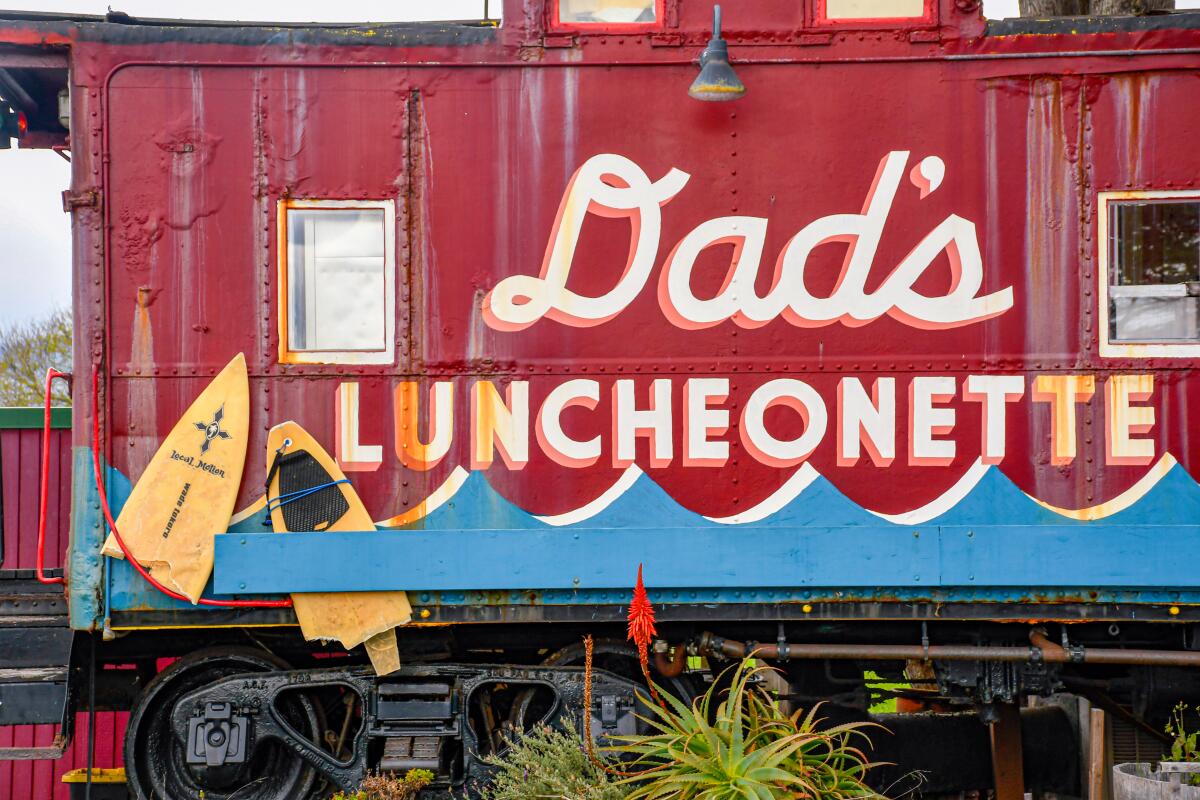
The backstory is that chef and co-owner Scott Clark used to work in fancy restaurant kitchens (including San Francisco’s Saison, which has two Michelin stars), but chucked that after becoming, yes, a dad. He and his partner, Alexis Liu, opened Dad’s in 2017.
Bonus tip: While you’re in Half Moon Bay, take a stroll on its inviting Main Street or a longer hike on the 7.5-mile Half Moon Bay Coastside Trail (which includes four miles in Half Moon Bay State Beach) and top it off with a drink or dinner at Sam’s Chowder House, which has a big deck overlooking the ocean.
22. Travel from '20s to '30s at Deetjen's in Big Sur

Before Highway 1 was completed in 1937, this was where the pavement stopped in Big Sur — the end of civilization if you were southbound. It still feels tenuously civilized (perhaps because mudslides to the south so often close Highway 1, forcing northbound L.A. drivers to delay travel or take a long detour via 101). The old Deetjen barn is now the dining room. Though Deetjen died in 1972, he bequeathed the place to a nonprofit entity designed to keep things as is. That’s why the five units in the Hayloft Hostel building share two bathrooms and there are no televisions, phones or Wi-Fi in guest rooms. Reservations, $100 to $435 per night, are taken by phone only.
But Highway 1 is a problem right now. Early this year, landslides forced closure of the road south of Deetjen’s and north of Ragged Point, forcing travelers from Southern California to take a long inland detour via Highway 101. Caltrans has been reopening portions of the road, but as of early May northbound traffic stopped at Ragged Point, and Caltrans was predicting a reopening no sooner than July 14.
Bonus tip: The restaurant serves breakfast daily, dinner Friday through Tuesday. If you have breakfast in the dining room, Mr. Deetjen’s favorite classical music will be playing, and the old man himself, sporting a beret and a skeptical expression, will be looking down at you from a portrait on the wall.
23. Savor the shade in Downtown City Park, Paso Robles
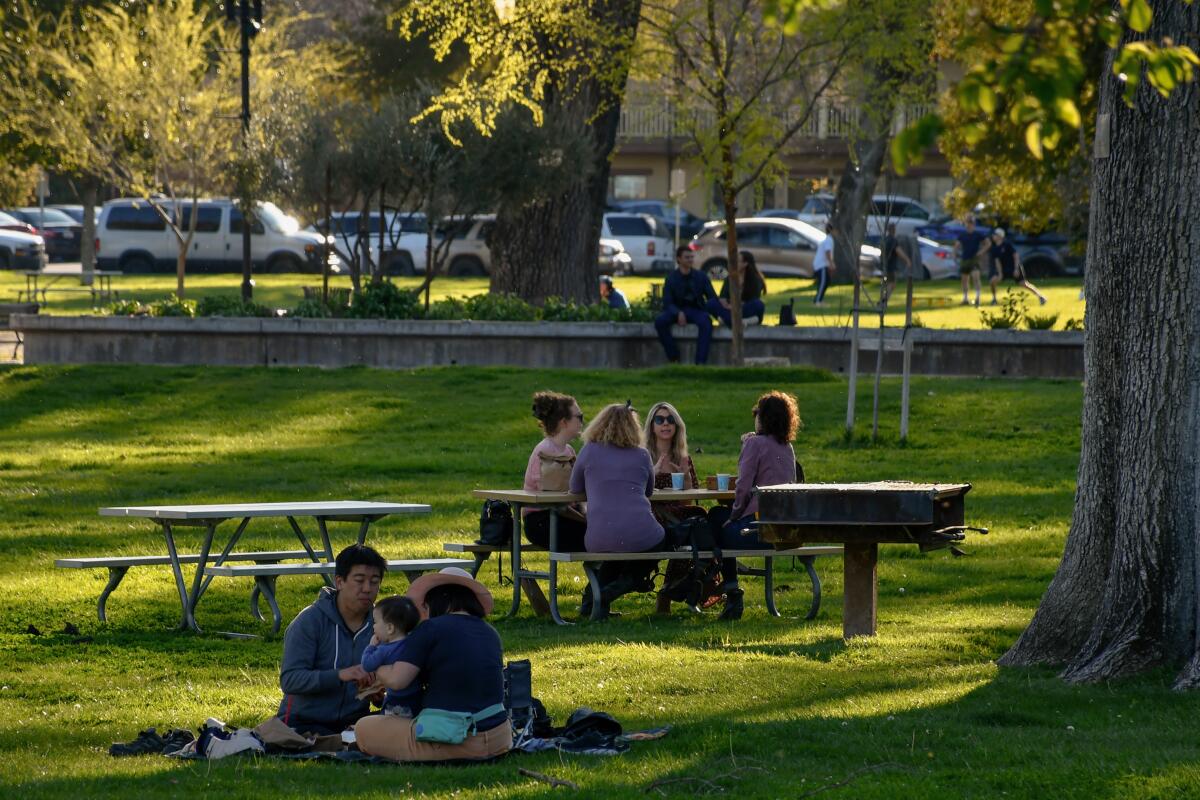
Just across Spring Street stands the landmark Paso Robles Inn, which last year redid its upstairs Cattlemen’s Lounge (where several steer horns are mounted and a marble bar glows eerily). There’s plenty of shopping, eating and drinking in the blocks around the park, including more than a dozen tasting rooms, plus the varied artworks (and monthly opening receptions) at Studios on the Park.
Bonus tip: A block off the park, the self-consciously chi-chi Piccolo hotel (Champagne vending machine in lobby) has a rooftop bar, Tetto, with pleasing views and springtime breezes. Also near the park, BL Brasserie (formerly Bistro Laurent) is a longtime dinner favorite, but on the last trip we tried Thomas Hill Organics with excellent results.
24. Amble, nibble and tipple at SLO’s farmers market
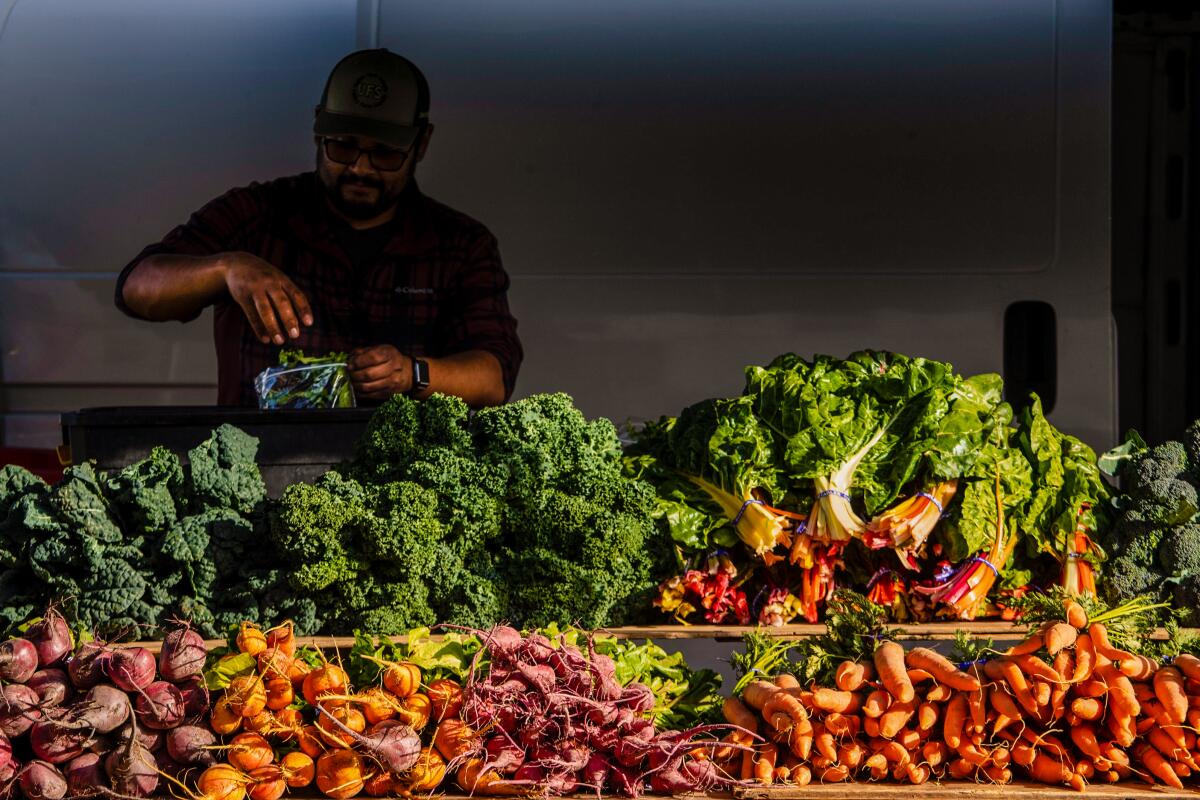
Since 1983 (with a pandemic hiatus), the Downtown San Luis Obispo Farmers’ Market has been taking over Higuera Street on Thursday nights, giving pedestrians free rein to nibble, sip, shop and hang out in the heart of downtown. It happens from 6 to 9 p.m. from March through October, 6-8:30 in cooler months.
The market fills five blocks with more than 100 vendors, including produce sellers, street food makers, assorted artisans and live music. You can get ribs here, and pulled pork, corn on the cob, kombucha, soap, tamales, honey, mushrooms and that particular secular sacrament (a crescent-shaped bit of beef, grilled over red oak) that SLO folk call tri-tip. Bring the family (but not your dog). And be reassured: The lines may be long for barbecue from F. McLintocks Saloon and cold-brew boba tea from Sequel Cold Brew Tea, but they move fast.
Bonus tip: Cal Poly students are a key part of this operation, making up an estimated 60% or more of the workers and a large chunk of the browsers. For further proof of collegiate influence, have a look at downtown’s Bubblegum Alley between Garden and Broad streets along Higuera.
25. Find the island at Lake Tahoe’s Emerald Bay
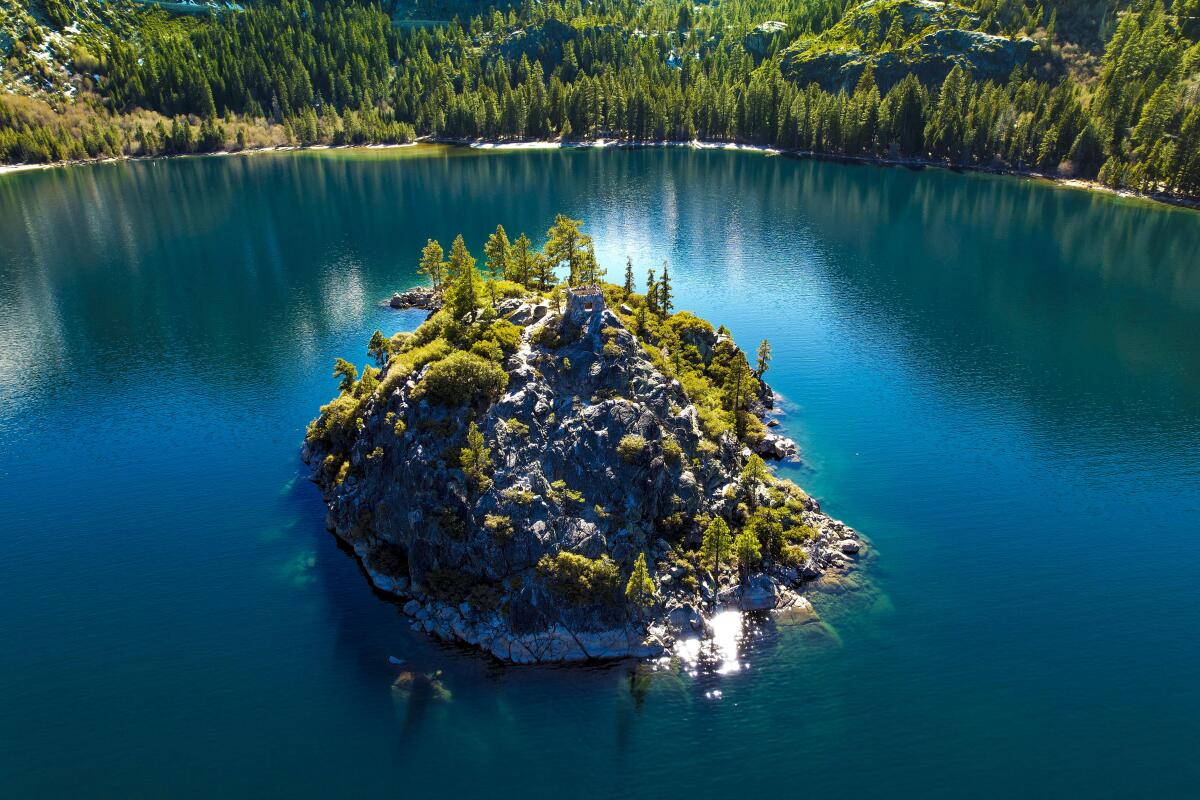
Whatever the season, the views from Emerald Bay Overlook, the rocks next to the main parking lot and Eagle Falls Vista Point are wraparound wonderlands of lake and forest, with tiny Fannette Island and its stone teahouse ruins completing the scene. In warmer months there’s camping. Closer to the water’s edge (at the end of a fairly steep one-mile trail) is Vikingsholm Castle, a Scandinavian-style mansion from the 1920s. There also are kayaking options. And if neither the lake, mountains nor mansion does it for you, go home. Or go play the slots in Stateline, 14 miles east across the Nevada border.
Bonus tip: It’s a 72-mile drive around the lake — highly recommended. And by the way, a new study says the lake is clearer now than it’s been since the 1980s, thanks to resurgent native zooplankton.
26. Break bread at Erick Schat's in Bishop
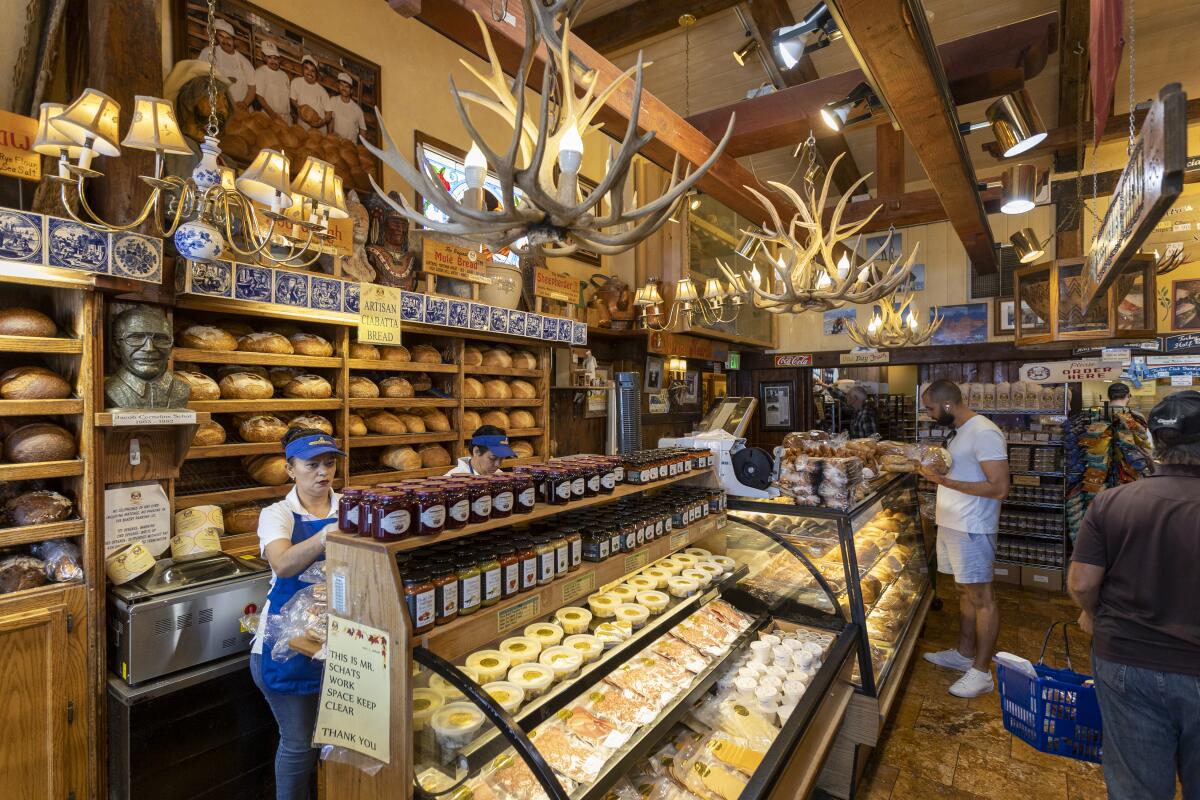
Bonus tip: If you’re spending the night, the Creekside Inn nearby has 87 rooms, rates that start around $160 and a location alongside Bishop Creek. You’ll find fire pits outside and bold Sierra images inside by Bishop-based photographer Galen Rowell, who died in 2002.
27. See butterflies hover at Exposition Park
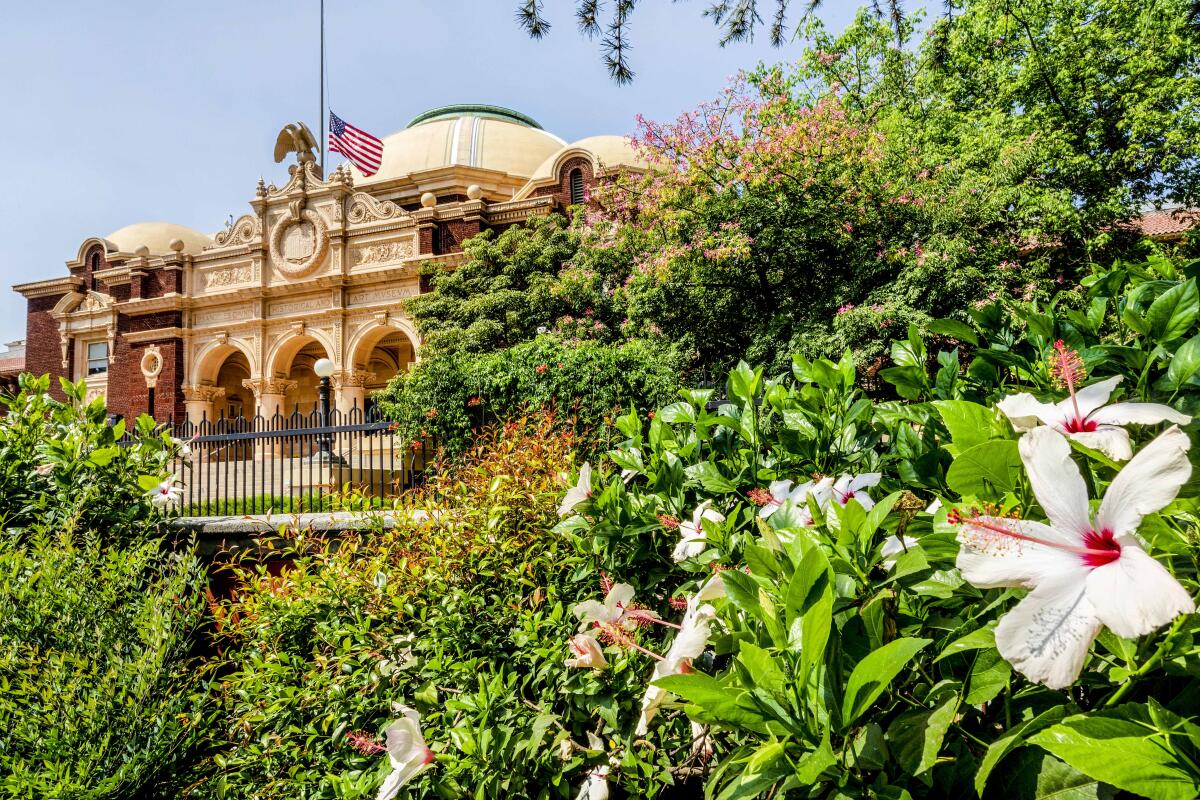
Start with the California African American Museum, which wins praise for thoughtful, lively shows. A few steps away, the California Science Center awaits, with its kid-captivating display of the Space Shuttle Endeavour. The Natural History Museum of L.A. County offers all the skeletons, dioramas, insects and butterflies (the latter through Aug. 13) you can handle. The rose garden does what rose gardens do.
A few steps away, the Los Angeles Memorial Coliseum is the only venue anywhere to host two Summer Olympics (1932 and 1984) and BMO Stadium (formerly Banc of California Stadium) is the site of L.A. Football Club soccer and many a pop concert.
As for the neighbor who’s due, it’s the $1-billion George Lucas Museum of Narrative Art, once scheduled to open this year, now targeted for 2025, just west of the Natural History Museum. As the sinuous exterior and its 11-acre site make clear, this will be no modest enterprise: a museum dedicated to the art of storytelling through images.
Bonus tip: More than 300 Kobe Bryant murals have sprung up in Southern California since the 2020 helicopter crash that killed him and his daughter Gianna. As this mural map shows, Exposition Park is surrounded by them.
28. Creep between weeping walls in Fern Canyon
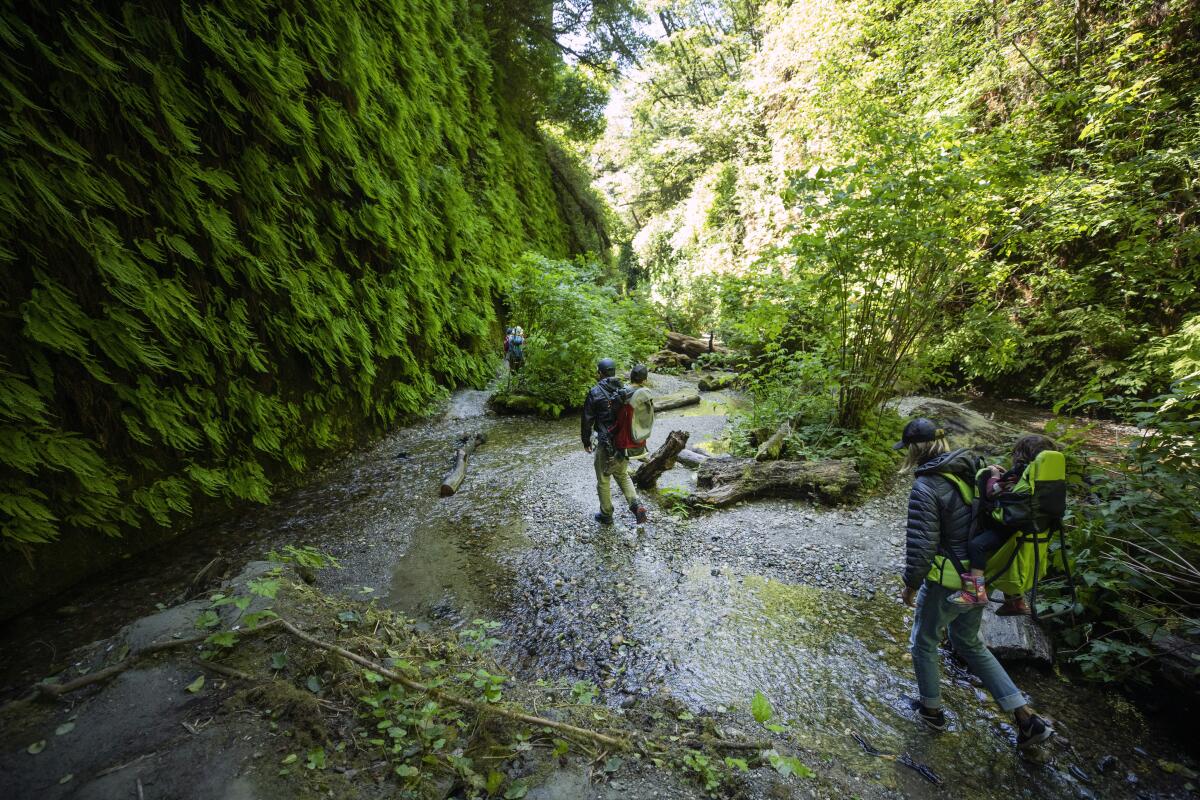
The Fern Canyon Loop Trail, which neighbors Gold Bluffs Beach, measures barely a mile. But the path takes you up a narrow canyon into primordial greenery between walls that rise 50 to 80 feet on each side. Parts of “The Lost World: Jurassic Park” were shot here 25 years ago, as were parts of the BBC’s “Walking With Dinosaurs.” The walls weep. The fronds drip. Home Creek riffles underfoot. Bring water shoes.
And book it a week or two ahead. In 2022, rangers imposed a May-to-September requirement that hikers reserve permits for their canyon-adjacent parking in advance. (The alternative: Hike into the canyon from the park visitor center, a 10-mile round trip on the James Irvine Trail.)
Also this year, spring and summer hikers in Fern Canyon and the Gold Bluffs Beach area will need to reserve permits up to two weeks in advance, with a limit of 250 reservations per day, thereby easing backups and wear and tear on the narrow, muddy road to the trailhead. The day-use fee is $12 cash at the entrance. No dogs. The second half of the loop hike is a less interesting route through Sitka spruce forest. When done, you might want to do what I did: Hike the wet bit a second time.
Bonus tip: Leave time to drive the 10-mile-long Newton B. Drury Scenic Parkway, which is flanked by massive redwoods. It’s free. (Like Prairie Creek Redwoods State Park, it’s also part of Redwood National and State Parks.)
29. Feast at the Ferry Building and roam the waterfront in San Francisco
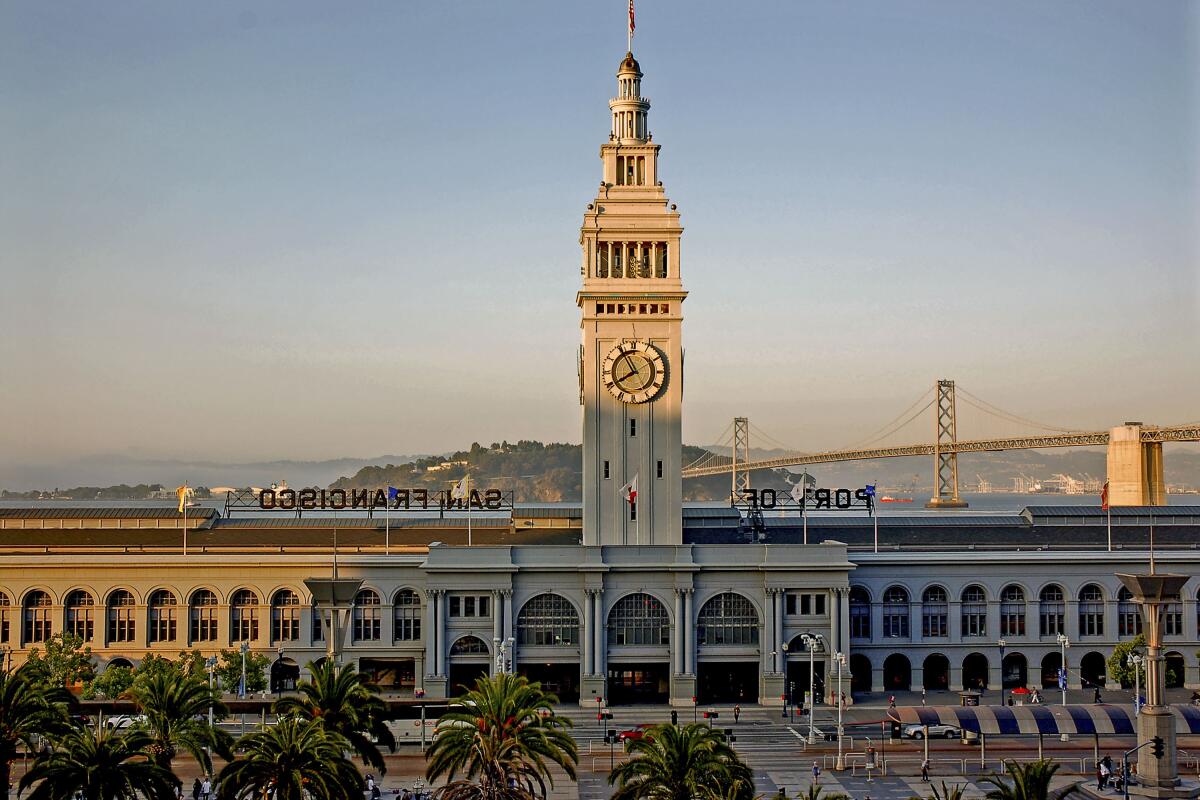
Start at the foot of Market Street in the 1898 Ferry Building, with its restaurants, food-focused retailers and farmers market (Tuesday, Thursday and Saturday). Blue Bottle coffee! Hog Island oysters! Acme bread!
Take a moment to mourn the demise (in March) of the 10-year-old nightly Bay Bridge Lights Show and hope that something worthy arises in its place. Working your way north and west on the Embarcadero (by foot, bike or throwback streetcar), you’ll find food and booze at the snug, old Pier 23 Cafe; (open 11 a.m. to 7 p.m. Wednesday-Sunday); hands-on science at the Exploratorium (closed Monday); a tourist-driven shopping scene (with sea lion soundtrack) at Pier 39; and a whole lot of T-shirt vendors, seafood restaurants and the Boudin Bakery at Fisherman’s Wharf.
Bonus tip: If you rent a bike at Blazing Saddles, Sports Basement or San Francisco Bicycle Rentals (about $30 to $80 daily), you can pedal to Golden Gate views at Crissy Field, the Warming Hut and Fort Point. Many visitors ride across the bridge to Sausalito (1.7 miles) and catch a ferry back, but I prefer the bike ride to Fort Point and back: no cars roaring past, less wind and more pleasant places to stop.
30. Meet Sequoia’s big trees and their boss, General Sherman

The awe is simple. This is an epic living thing, about 2,200 years old, surrounded by legions of other epic trees. The frustration is usually because the general’s stature resists camera capture. It’s too tall to shoot.
And there’s more frustration lately. Sequioa and Kings Canyon parks have been menaced by six major fires in eight years. Then came the storms of early 2023, which forced closure of all roads into both parks. Kings Canyon’s Grant Grove has reopened and several other areas were expected to reopen by late May. But General Sherman and the Giant Forest area of Sequoia remained closed. Rangers plan to have them accessible by Highway 180 (the Kings Canyon park entrance) by June 9 and accessible by Highway 198 (the Sequoia park entrance) by July 1.
If you go, expect a crazy quilt of blackened trees, new growth and flood damage. In the Sequoia gateway town of Three Rivers, you can get a good burger at Buckaroo Diner, a cold beer at the Gateway Restaurant, a cabin at the Buckeye Tree Lodge.
Bonus tip: In the 1880s, before Sequoia was a national park, a Utopian commune called the Kaweah Colony occupied the area. The communists, who planned to log the area, had their own name for the biggest tree. They called it Karl Marx.
31. Feed your imagination and feast your eyes at the Getty
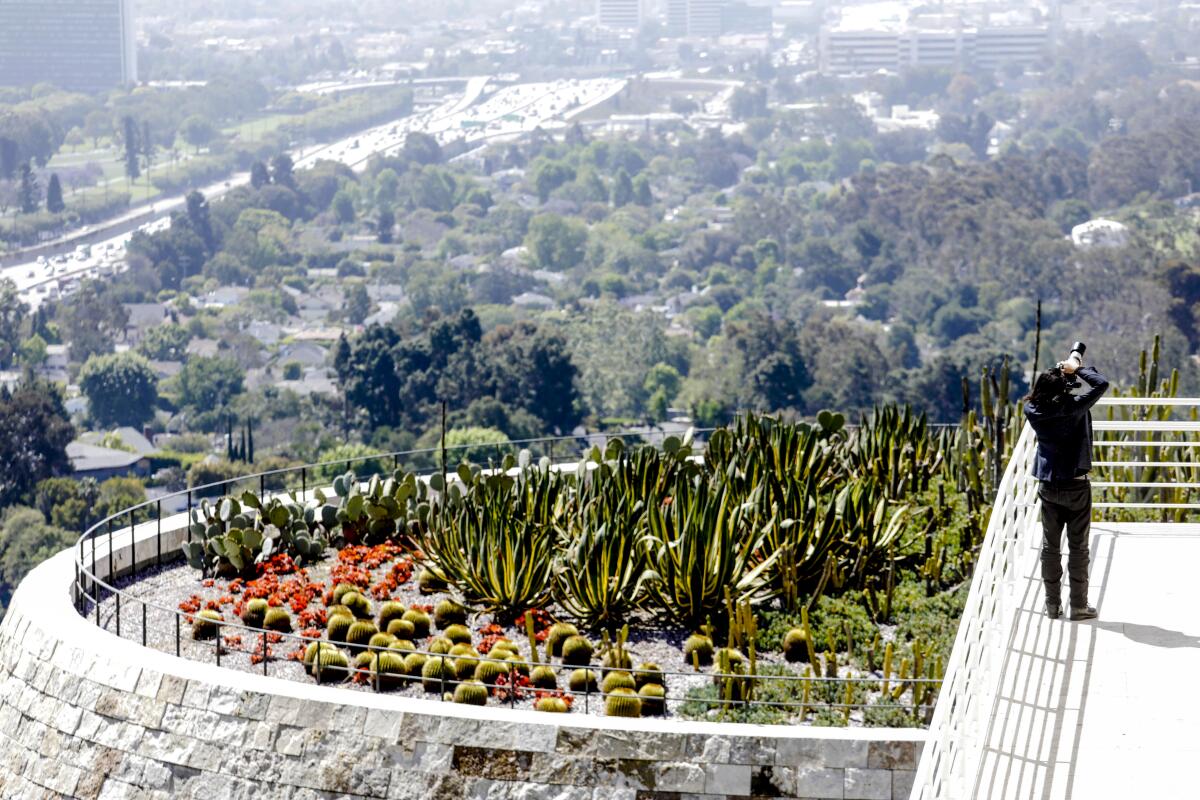
Even by Los Angeles standards, the Getty Center in Brentwood is a young landmark (completed in 1997). But this 110-acre museum campus of bright, spare buildings has a spectacular location and is backed by an $8.6-billion endowment.
The galleries include Van Gogh’s “Irises,” Cézanne’s “Still Life With Apples” and David Hockney’s “Pearblossom Highway” photocollage, along with thousands of other paintings and sculptures, a renowned photography collection, a boldly modern garden and a set of jaw-dropping views toward the Pacific. One temporary exhibition through Sept. 17 looks at pastel portraits from 18th century Europe.
Admission is free but you must reserve a timed-entry spot and parking is $20. (It’s closed on Monday.) Take the tram up the hill and head for the West Pavilion, which houses photography and Impressionists. Check out the cactus garden (between the east and west pavilions) along with the larger, lower Central Garden designed by artist Robert Irwin. Also, spare a few minutes to read up on the notoriously tight-fisted oilman who endowed this place even though he left California in 1951 and never returned.
Bonus tip: If antiquities are more your style, spend a day at the Getty Villa in Pacific Palisades, which specializes in ancient Greek, Roman and Etruscan art and is closed Tuesdays.
32. Grab a handful of nature (or is it junk?) at Glass Beach

Visitors, including many families, comb the shore and snap photos. But remember: Parks officials forbid visitors from carrying bits away. The best-known Glass Beach is at the west end of West Elm Street. Others are slightly north in MacKerricher State Park.
Bonus tip: Speaking of gems in the rough, Fort Bragg’s Noyo Harbor is a lively, gritty spot at the water’s edge. For an upscale overnight, try the Noyo Harbor Inn, built in the 1860s, rebuilt in the 2010s. For fresh food by the water, try the Noyo River Grill (opened in 2018) or the neighboring Princess Seafood restaurant (Thursdays-Sundays, 11 a.m. - 5 p.m.). The Princess menu features sablefish and crab caught by an all-woman local crew on a 42-foot boat whose name is ... Princess. Live music on weekends.
33. See Golden Gate Park from the de Young Museum's view tower
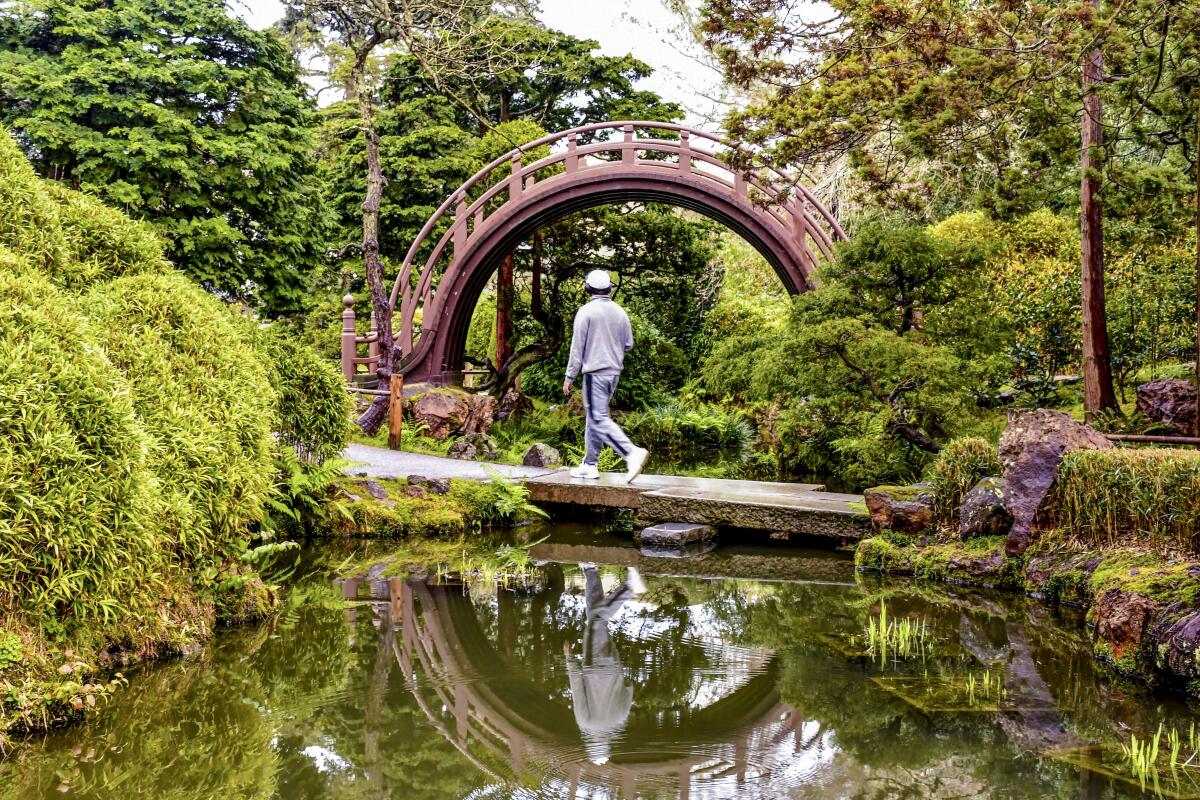
The de Young’s an art collection that includes a little bit of everything, including site-specific works by Andy Goldsworthy and James Turrell and a Kehinde Wiley show through Oct. 15. But the bold, angular de Young building also has something else: Upstairs at the east end of the building, you’ll find its 144-foot-high Hamon Tower, whose observation level has glass walls and staggering wraparound views. Though adult admission to the museum is $15, you can head up to the tower for nothing. (The museum is closed on Mondays, though.)
Bonus tip: It’s hard to imagine this green park as sand dunes, but that was the lay of the land when park construction began in the 1870s. Look closely at many rocks and you’ll realize they’re colored concrete, deployed by the same long-ago superintendent, John McLaren, who devised the park’s fake lakes and man-made waterfalls.
34. Choose among art, architecture, music and drama on Grand Avenue

Walt Disney Concert Hall, the curvaceous home that Frank Gehry designed for the L.A. Philharmonic, shimmers at age 20. (Catch a concert or do a self-guided tour there.) The Broad museum, now age 7, looms like a white hive of contemporary art. (Admission for most exhibits is free, but you must book in advance; closed Mondays.)
There are so many more arts options close at hand, including the Music Center‘s Dorothy Chandler Pavilion, Ahmanson Theater and Mark Taper Forum, the Museum of Contemporary Art and the Colburn School (for performing arts), you could spend three days exploring this territory. Meanwhile, across the street from Disney Hall, a pair of mixed-used skyscrapers known as the Grand L.A. (also designed by Gehry) opened in 2022 with apartments, retail, restaurants and a swanky hotel, the 28-story Conrad Los Angeles. (Rooms start at about $370 nightly.)
Bonus tip: Between jolts of culture, recharge at Gloria Molina Grand Park, a 12-acre rectangle of grass and foliage (with fountain, Starbucks and playground) that descends from Grand Avenue down Bunker Hill to Spring Street. L.A. County’s Board of Supervisors voted in March to rename Grand Park in honor of Molina’s long service in city, county and state government. She died May 14.
35. Eat with abandon at Grand Central Market
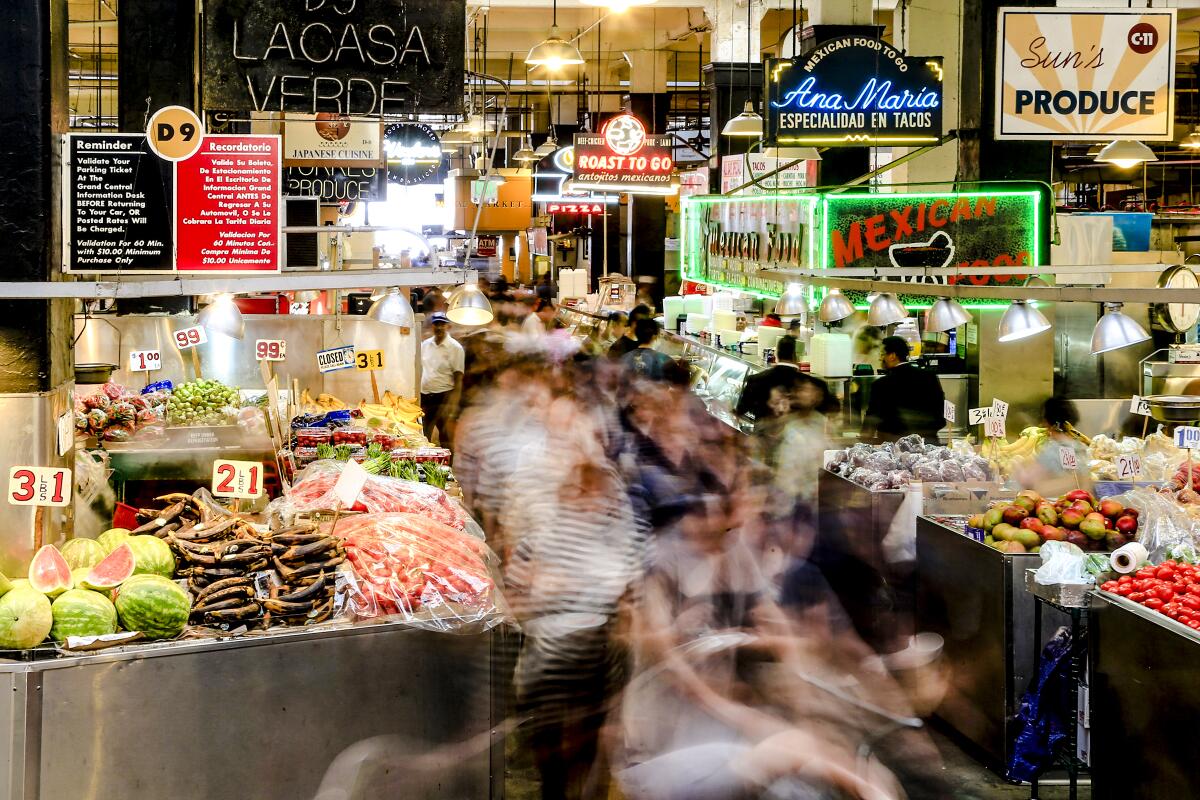
Bonus tip: Across Hill Street, you’ll find the Angels Flight Railway, a funicular that dates to 1901. Its two orange cars charge $1 for a short, steep ride (298 feet) to California Plaza atop Bunker Hill.
36. Guess your Martian weight at Griffith Observatory
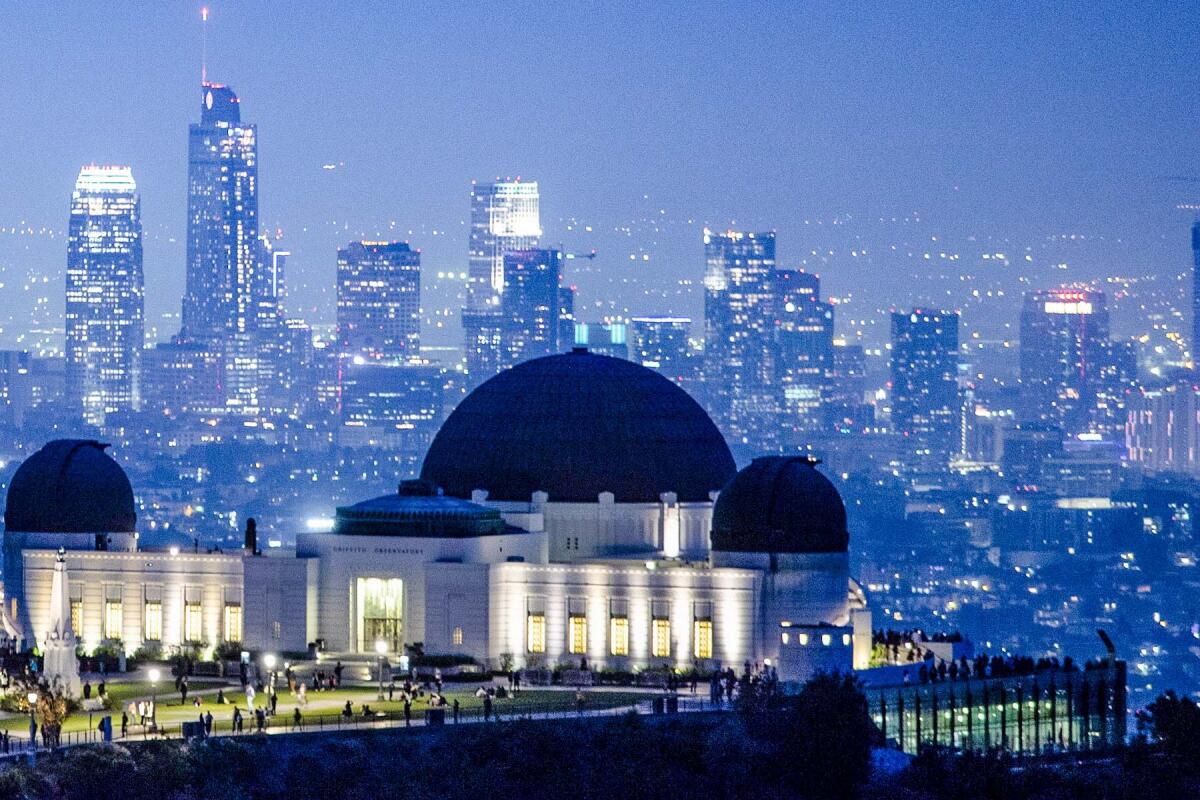
Since 1935, Angelenos have embraced this Hollywood Hills landmark as “the hood ornament of Los Angeles,” as observatory director E.C. Krupp calls it. It’s the architectural star of 4,210-acre Griffith Park, with three copper domes hovering above a startling amount of subterranean space (thanks to a major expansion completed in 2006).
Looking west from the lawn, you see the Hollywood sign. Looking south at sunrise or sunset, you see Los Angeles as a tidy, twinkling grid, with Western Avenue stretching to infinity or maybe San Pedro. Inside, you can scan distant stars or check your weight on other planets. It’s free (except for shows in the Samuel Oschin Planetarium). For snacks, you’ll have the Cafe at the End of the Universe. From its patio tables you can recall “Rebel Without a Cause” (1955), “La La Land” (2016) and the live concert video Adele made in 2021 — all of which had key scenes here.
Remember it’s closed Monday. And don’t park here if you can avoid it — it’s $10 an hour and the most convenient lot is basically always full. Take a rideshare or catch a DASH bus from the Greek Theatre or the Sunset/Vermont Metro station.
Bonus tip: You can hike from the observatory to the Tom LaBonge Panorama atop Mt. Hollywood, a roughly 2.6-mile round-trip journey. And be sure to read up on the philanthropist-felon who made all this possible, Griffith J. Griffith.
37. Look up and step lightly in the Grove of Titans

Bonus tip: I slept in Crescent City’s Curly Redwood Lodge and had breakfast at the Good Harvest Cafe, both recommended. And save an hour or two for the 1856 Battery Point Lighthouse, which stands on a tidal island along a gorgeous stretch of coastline. If you get to the parking lot at Battery and B streets at low tide, you can walk to the lighthouse.
38. Examine the Hammer Museum and UCLA
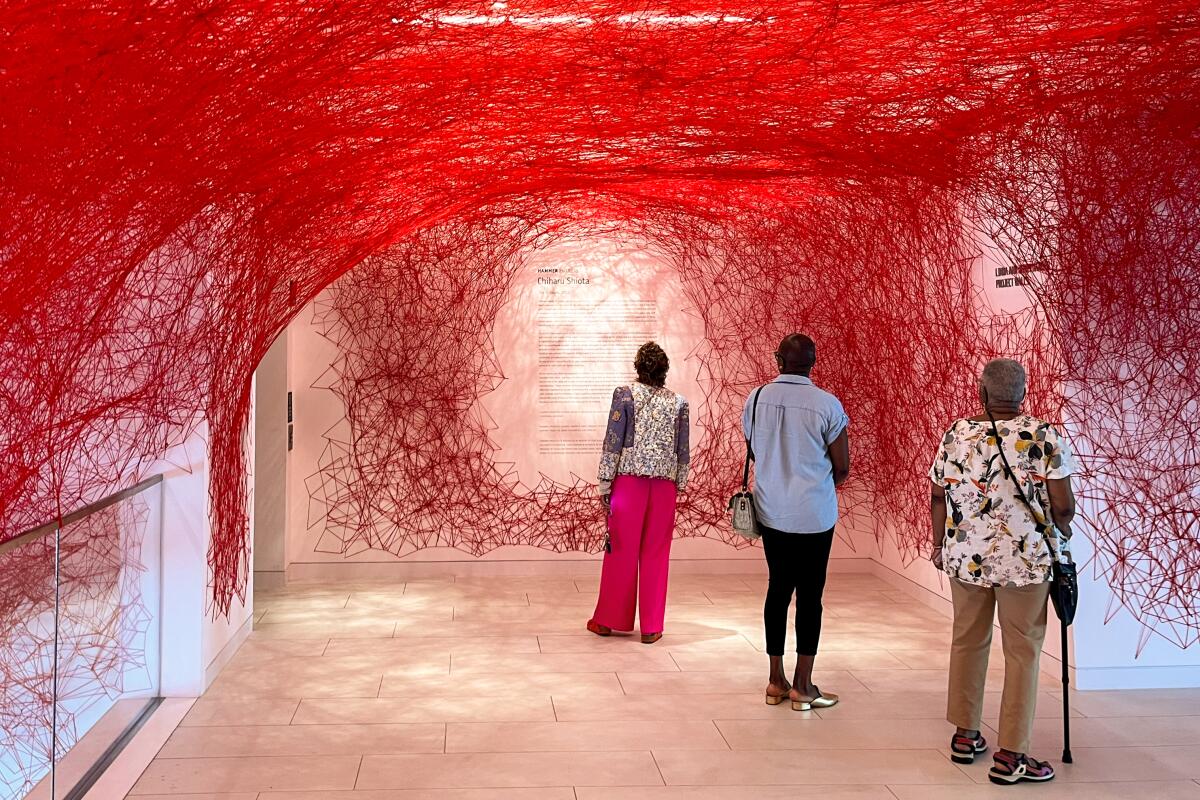
For a sense of the UCLA campus (which has 31,600 undergrads and drew about 145,900 freshman applications in 2023), I suggest walking a two-mile loop from the Hammer. Head north on Westwood Boulevard to Bruin Plaza (where a big, bronze Bruin bear statue awaits your selfies). Climb Election Walk (if it’s a warm day, legions of students will be sprawled on the lawn) to Shapiro Fountain. The big brick behemoth to your right will be Powell Library. To your left: Royce Hall, host to many a concert. Now circle back. You’ll pass the Fowler Museum (which explores global arts and cultures) on your right. Need merch? Try the student store in Bruin Plaza. Whether you’re an alumnus or not (I’m not), you must admit UCLA may be the prettiest, liveliest California campus this side of Palo Alto. Just be careful not to bump into one of its “#1 Public University” banners. They’re everywhere.
Bonus tip: In the Hammer Museum courtyard, Lulu, a restaurant by California cuisine pioneer Alice Waters and David Tanis, serves lunch (Tuesday through Sunday) and dinner (Wednesday through Sunday) under orange lanterns. Thumbs up on the $17 mozzarella, prosciutto and arugula sandwich.
40. Enter a green dream on Highway 46
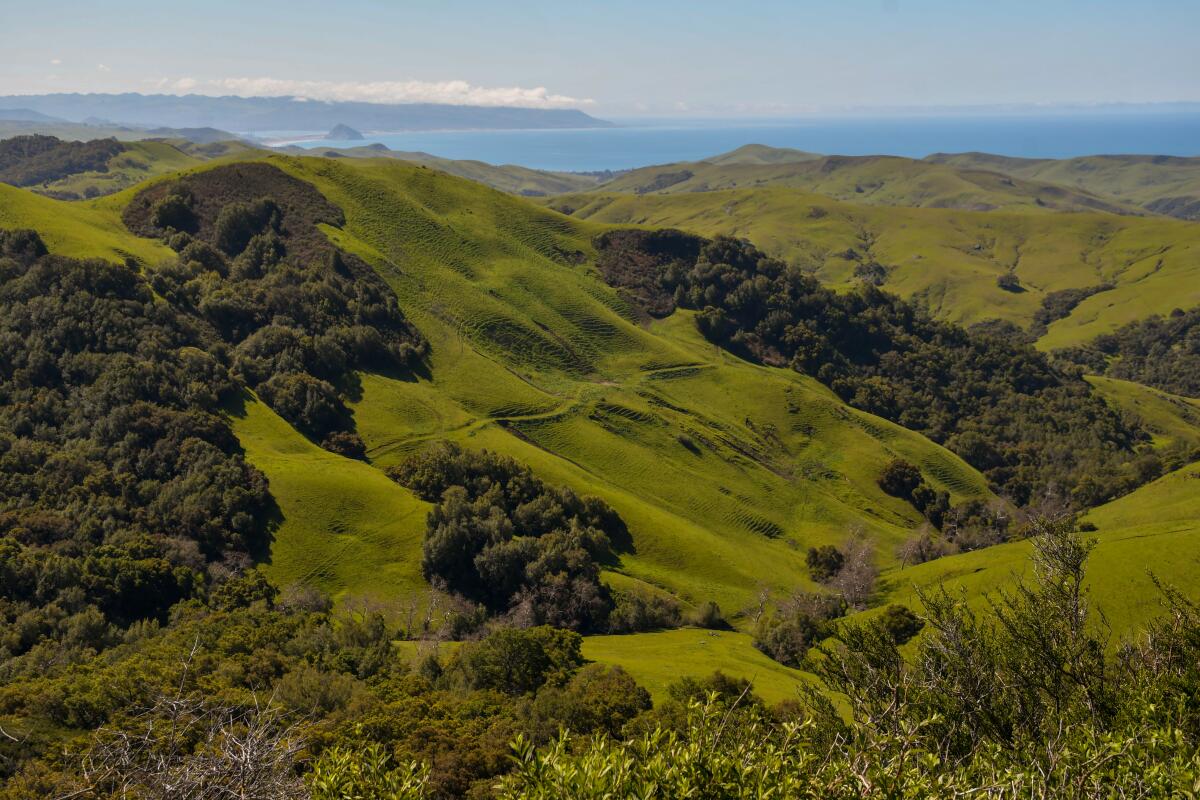
Bonus tip: If you’re heading west-to-east on 46, there’s an extra possibility in the hills just east of Paso Robles: Sensorio, a walk-through display of ever-changing lights by artist Bruce Munro. Imagine electric flowers with a dimmer switch, the changing colors set to music. It’s generally open Thursday through Saturday nights in April and May, Thursday through Sunday nights from June through December. Tickets start at $49 for adults, $28 for children.
41. Picnic at the Hollywood Bowl
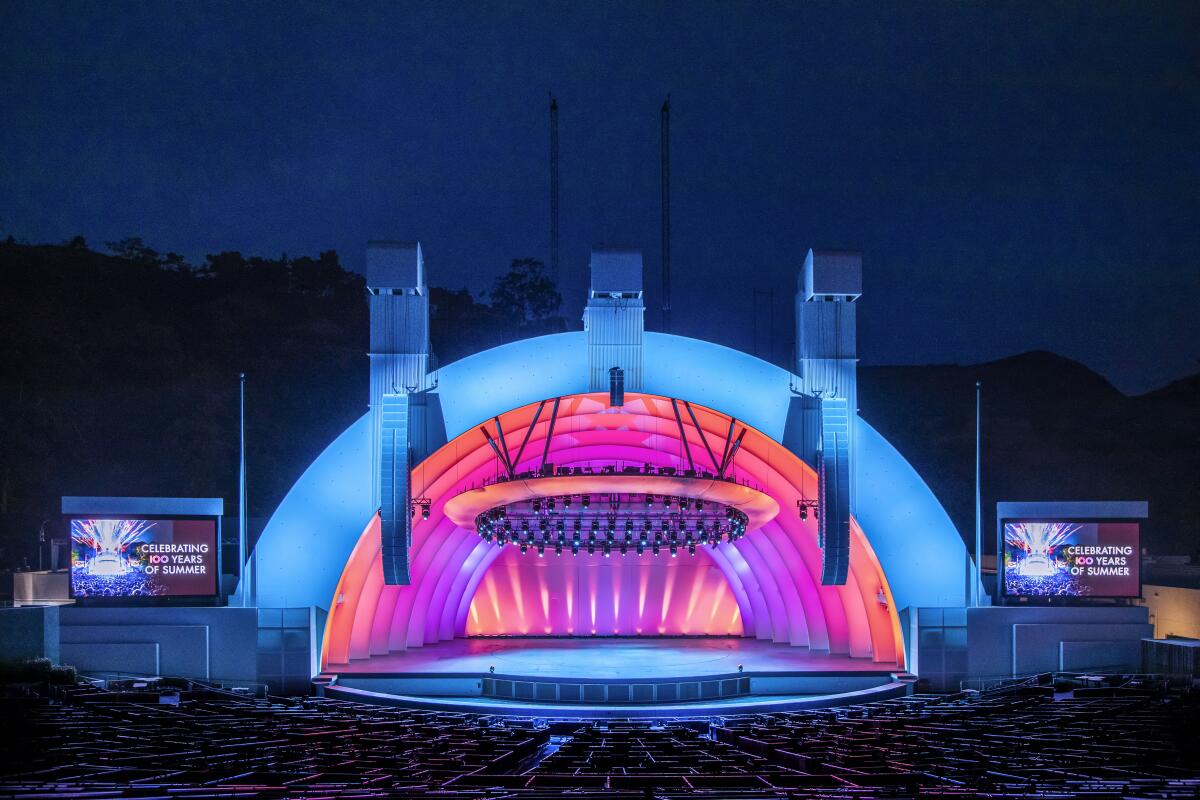
Or maybe it’s just the picnics. Most venues would scream bloody murder if you tried this, but at the county-owned bowl, the tradition is that you’re allowed to bring your own food into most shows. If the Phil is playing, you can usually bring wine and beer, too. (Though alcohol is forbidden at some shows.)
Aaron Copland, Deep Purple, Igor Stravinsky, Ella Fitzgerald, the Beatles, Kamasi Washington and Phish have played here. There’s a jazz festival and a mariachi festival every June and around July 4 there are a few fireworks shows (this year featuring the Beach Boys). The 2023 “Sound of Music” sing-along will be Sept. 16.
The venue holds about 18,000 and parking is messy. Try to get dropped off at Lot B or use a shuttle bus. If you like outdoor shows in smaller venues, remember the Greek Theatre (capacity: about 5,900) in Griffith Park; and the Ford Amphitheatre (capacity: about 1,200) at Cahuenga Pass. Both run summer seasons.
Bonus tip: Some morning rehearsals for classical concerts at the Hollywood Bowl are open to the public, typically on summer Tuesdays and Thursdays between 9 a.m. and 12 p.m., always subject to change. For the latest information, email information@laphil.org or call (323) 850-2000.
42. Stretch among stars at Hollywood Forever Cemetery
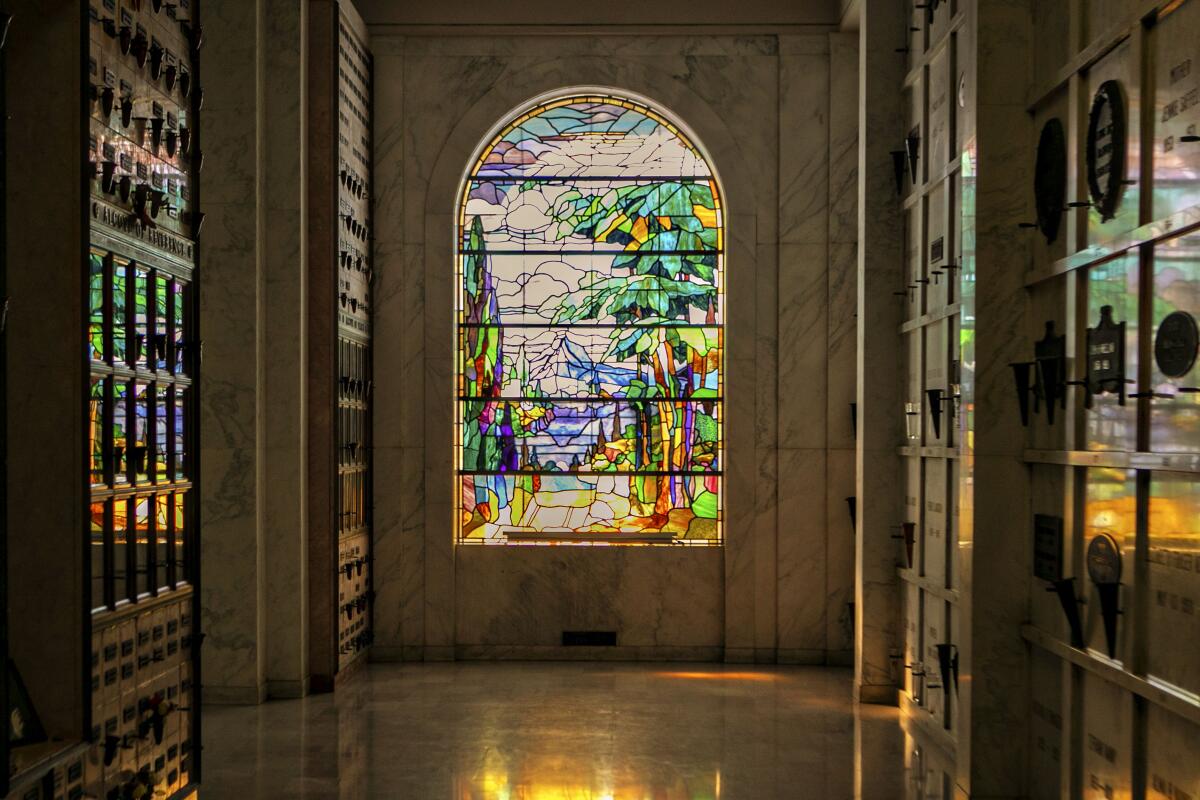
There are, of course, many more celebrity graves in town, including the sprawling Forest Lawn in Glendale (where Michael Jackson and Elizabeth Taylor are) and Pierce Brothers Westwood Village Memorial Park (where Marilyn Monroe is). There’s also a tour company, Grave Line (“we put death on the map”), that specializes in celebrity-death-based itineraries.
Bonus tip: The cemetery’s Day of the Dead celebration, a spectacle for more than 20 years, features hordes of costumed visitors, live bands, Aztec dancers and ofrendas (altars) honoring departed loved ones.
43. Read the Hollywood sign, frontward and backward
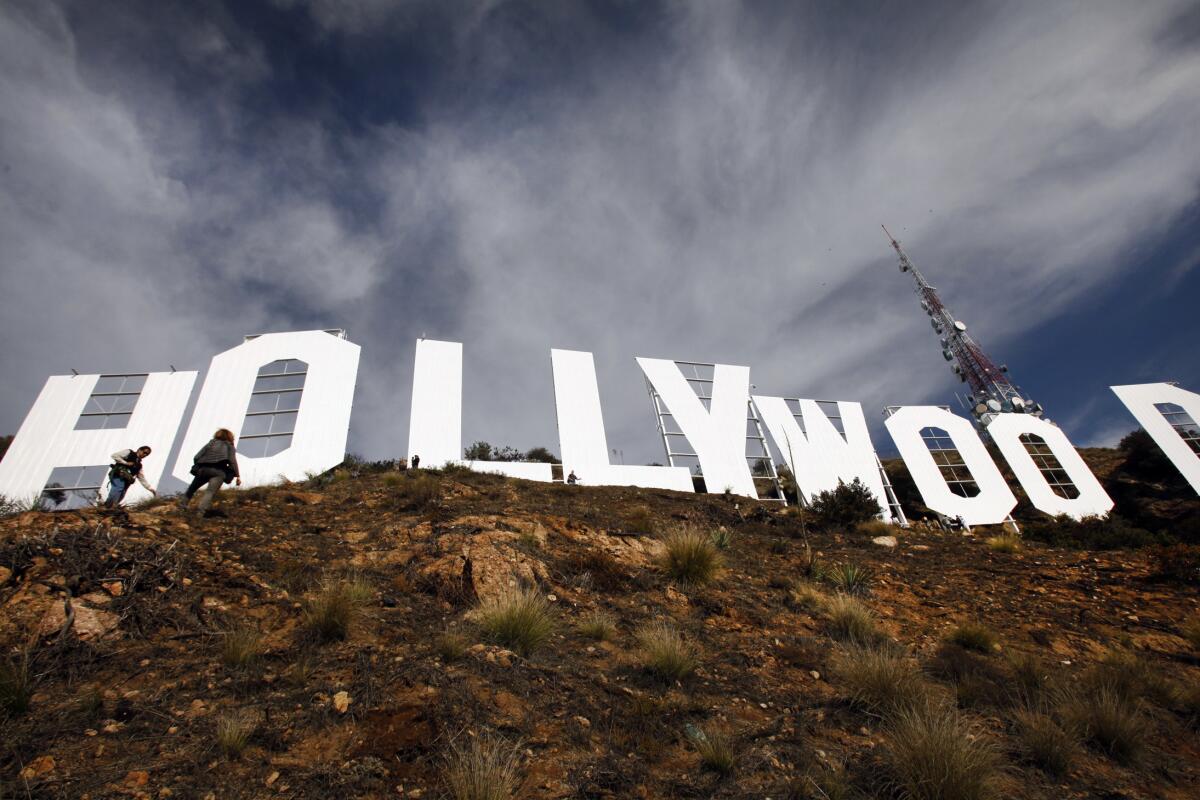
We can do this. One option is Lake Hollywood Park at 3160 Canyon Lake Drive, a grassy, dog-friendly spot with room for a picnic, the sign’s letters looming about 2,000 feet away. (There’s parking on the street, but you may need to walk a few blocks.)
If you’re headed to Ovation Hollywood, the mall at Hollywood Boulevard and Highland Avenue, you could just head up to the fourth level bridge, which was placed to look straight at the sign, 3.2 miles to the north.
Or maybe you must have the view from above, with the letters backward. The shortest route to that is the Burbank Peak Trail (2.8 miles round-trip), but it’s steep, rocky and requires parking curbside on Lake Hollywood Drive, then walking a quarter-mile uphill to the trailhead on Wonder View Drive. I’d rather take the longer, flatter hike from Griffith Observatory, an 8.8-mile round trip that might take five hours. (There are other options too.)
Bonus tip: Like horses? Take a two-hour, $125 evening ride in the Hollywood Hills with Sunset Ranch at the north end of Beachwood Drive. You won’t get above the sign, but you’ll be on horseback in Hollywood. You win.
44. Make tracks in the white sand at the Hotel del Coronado
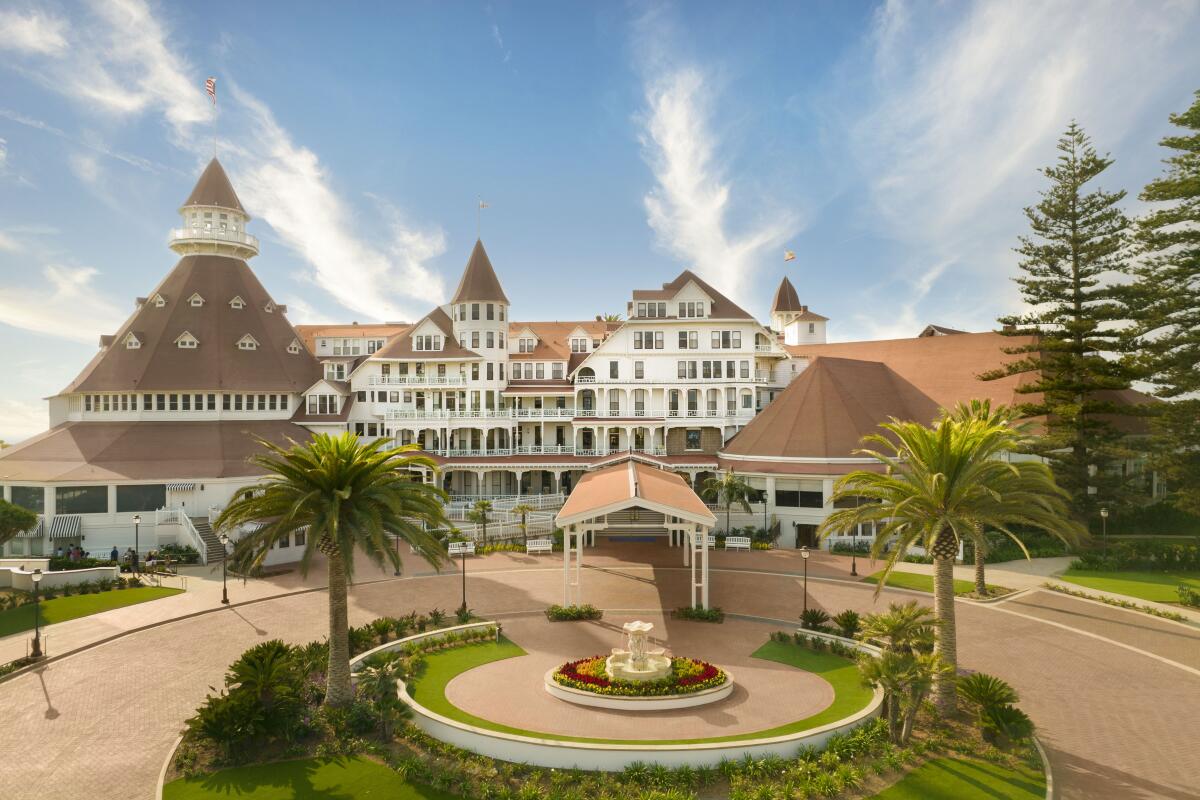
Suddenly, the old building, where rates might dip as low as $600 on off-season weekdays, seems like a bargain. Stay there. Or just pop in for a meal, a drink or ice cream. Or head straight to that wide, sandy beach. And if you spot a bunch of really fit guys doing weird exercises along the shore, those will likely be Navy SEALs, whose training base is nearby. (Later, if you like, you can find “Some Like It Hot” — the 1959 movie with the Del, Monroe, Lemmon and Curtis — on Netflix.)
Bonus tip: Coronado is pricey. But its ferry service is not. Take a 15-minute ferry between downtown San Diego (5th Avenue and Convention Way) and the Coronado Ferry Landing (at the foot of B Avenue). You’ll get an eyeful of skyline and you’ll pay just $7 each way.
45. Browse among blossoms, books and a Blue Boy at the Huntington

Also, the Rose Garden Tea Room, a longtime local favorite that closed in March 2020, is set to reopen May 24 after a renovation.
Meanwhile, the museum and library, underwritten by a railroad fortune, have been diversifying energetically. “Blue Boy,” Thomas Gainsborough’s emblematic 18th century portrait of a rich British kid, returned in 2022 from London’s National Gallery, and now shares a gallery with “Portrait of a Young Gentleman” by American artist Kehinde Wiley (who painted Barack Obama’s presidential portrait). Other exhibits include quilts from Gee’s Bend (through Sept. 4) and the long-term installation “Borderlands,” which shows how artists probe political and personal boundaries.
Meanwhile, the Huntington’s library Exhibition Hall displays include a 15th century manuscript of Chaucer’s “Canterbury Tales” and a typed draft of Pasadena’s own Octavia E. Butler’s “Parable of the Sower” (1993). And through Dec. 4, the Library West Hall will display the oldest printed book in the Huntington’s collection, “The Scripture of the Great Flower Ornament of the Buddha,” created in 1085. Adult admission is $25-$29 for nonmembers. Closed Tuesday.
Bonus tip: There’s more Octavia Butler, and more books by people of color generally, three miles north of the Huntington at Octavia’s Bookshelf on North Hill Avenue in Pasadena. The bookshop opened in February.
46. Order Animal Style at the flagship In-N-Out
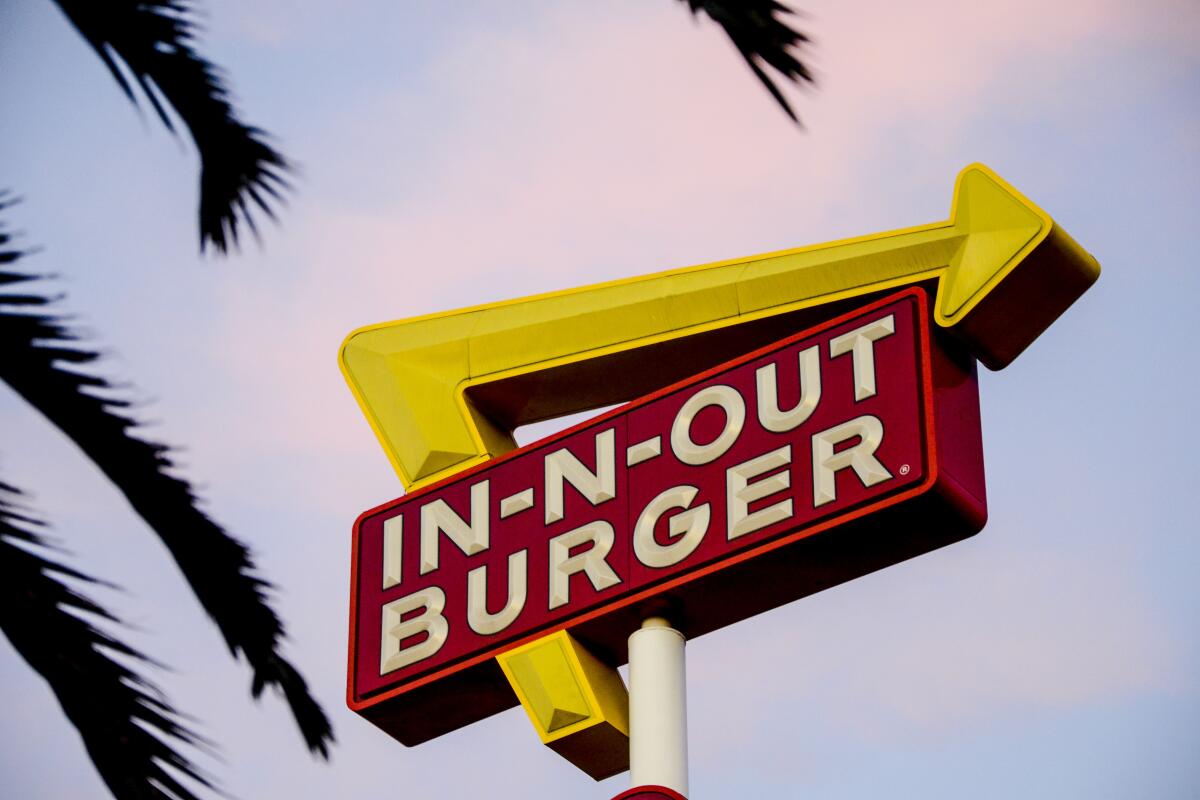
You might also head to the nearby replica of the chain’s first tiny, red-and-white burger shack, open for photo ops 11 a.m.-2 p.m. Thursday-Sunday at 13766 Francisquito Ave., Baldwin Park.
Harry and Esther Snyder opened the first In-N-Out burger shack in 1948, which put them among the first to try a drive-through restaurant. (The kitchen was about 10 square feet.) The company’s ties to car culture have remained strong through the decades, but fans say the burgers are what matter most. To taste what the fuss is all about, order a Double-Double, Animal-Style — a double cheeseburger with extra spread and grilled onions, basically — which has fueled the company’s growth to more than 330 outlets in seven western states. (The first outlets in Colorado opened in 2020, but there are still no In-N-Outs east of Texas.)
Bonus tip: About that Bible verse on the bottom of your cup: The In-N-Out chain’s owner is its founders’ granddaughter, Lynsi Snyder, an evangelical Christian whose Slave 2 Nothing Foundation fights substance abuse and human trafficking.
47. Roam Indian Canyons and take native waters
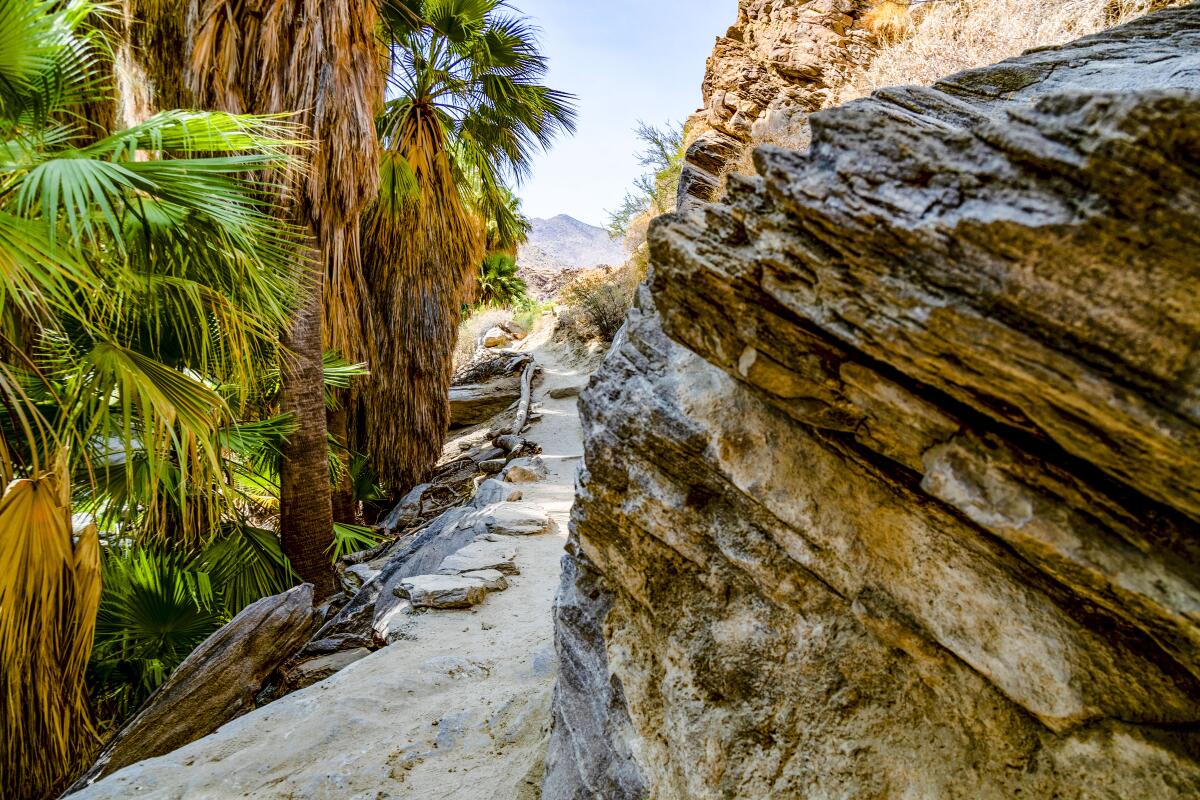
In Andreas Canyon, you follow a path along the year-round Andreas Creek, which is lined by Washingtonia filifera, the California fan palm. This is a genuine oasis, reached by an easy hike — a 1.2-mile round trip.
In Palm Canyon, a few miles away, the looping 2.7-mile Victor Trail drops into a shady, boulder-strewn fold in the desert hills (more native palms here), then returns along a higher ridge. Those canyons, along with Murray Canyon and Tahquitz Canyon (which has a seasonal waterfall and history that includes ancient myth and Jim Morrison), are all part of the Indian Canyons network of open space managed (and named) by Agua Caliente leaders.
Adult admission is $12; open daily Oct. 1 through July 4; on Fridays, Saturdays and Sundays in summer. No pets.
Bonus tip: To soak in the waters for which Palm Springs is named, head to the Agua Caliente Band’s Spa at Séc-he, which opened in April after a five-year reconstruction of the ancient mineral baths. Day passes cost $145 and treatments include a quartz bed, salt cave, 15 treatment rooms and 22 private mineral baths. The spa is part of Agua Caliente Cultural Plaza, where a cultural museum is due to open by year’s end.
48. Get sound-scrubbed at the Integratron
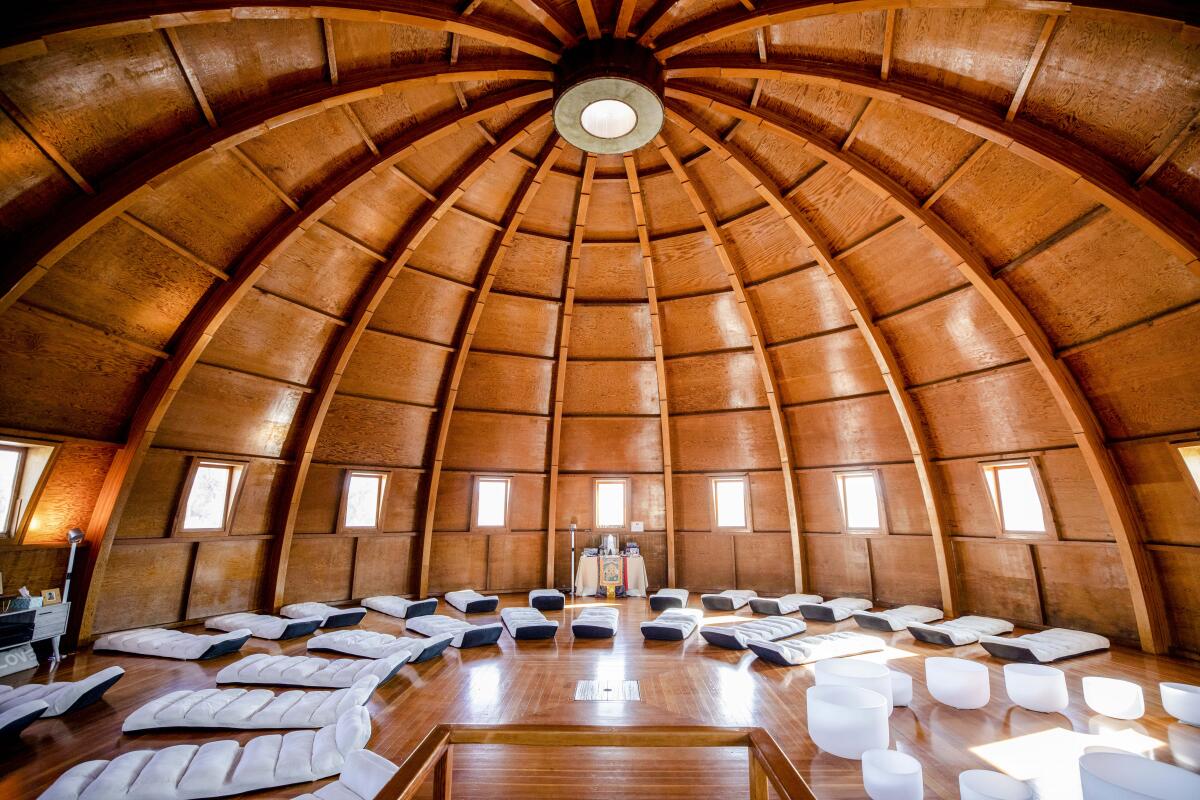
But times and ownership change. Now family-owned, the Integratron is mostly about sound baths, offered to private and public groups by appointment only. A typical group bath includes up to 32 people, lasts an hour and starts with your host telling Van Tassel’s tale. Then the mallets come out, and the host taps at 20-quartz crystal “singing bowls” that can sound like church bells, elegant feedback or a planetary dial tone.
The Integratron offers group sound baths Thursday-Sunday at $55 per person (age 14 and older). The business closes for the summer, this year July 3 through Sept. 13. Private sound baths are $1,300 and up.
Bonus tip: No soap, water or disrobing is involved but you do have to take off your shoes and turn off your phone.
49. Taste cattle country in Jocko's Steakhouse

High on the walls you can see the brands of local ranches past and present. My filet mignon ($39.95 for 10 ounces) was just tender enough and full of flavor. And while you tuck into your meal, you can savor the old-school details all around, including the saltines and iced pickles on the table tops. Your dinner entree comes with salad, Pinquito beans, garlic bread, potatoes, rice or vegetables, followed by ice cream. (I had spumoni, for the first time in years.)
Bonus tip: Jocko’s menu also includes pork, chicken, seafood, a few Italian dishes. For vegetarians? My wife left Jocko’s raving about the hash-browns casserole and grilled artichokes.
50. Paddle the Klamath in a Yurok canoe
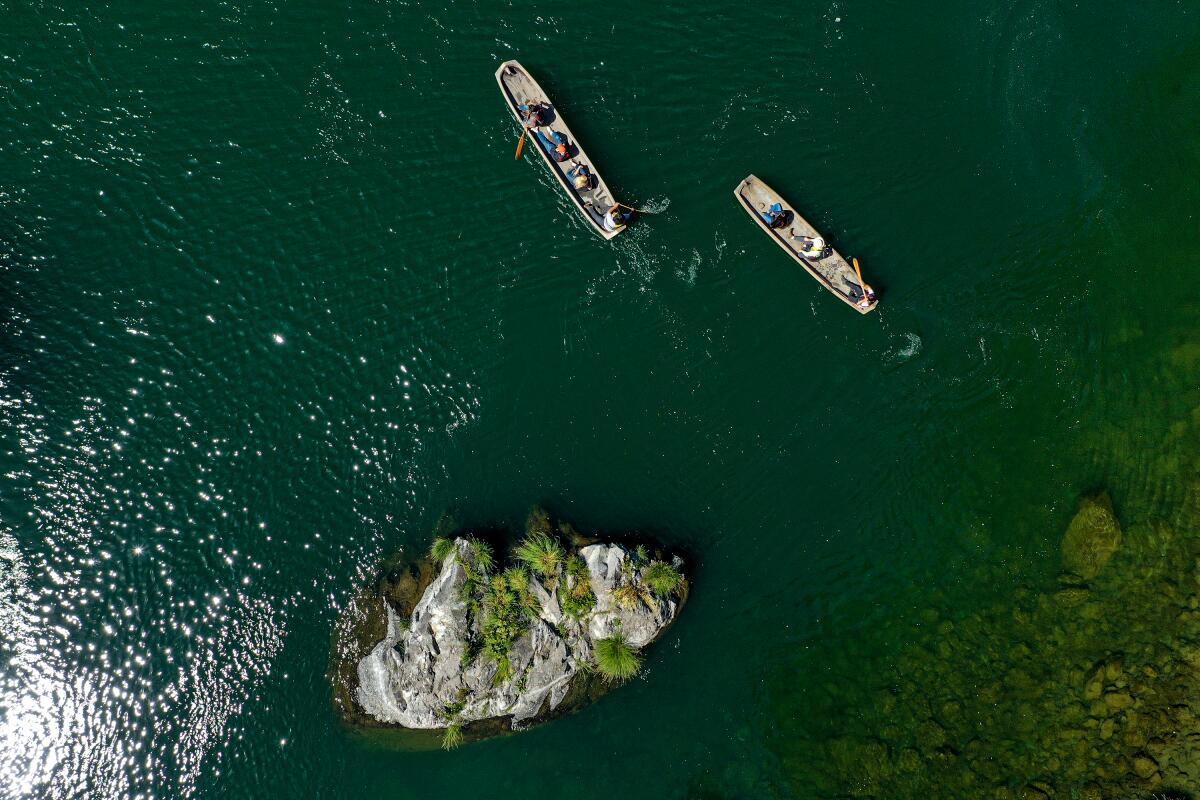
Bonus tip: Klamath River Overlook, at the end of Requa Road in Klamath, offers the region’s best view of the river while still standing on solid ground. From that overlook, you can hike a steep trail (a mile down and back) that takes you toward the water. After that, head for the south side of the river at the end of Klamath Beach Road. That’s Klamath Beach, where at low tide you can walk past traditional Yurok sweat houses to a sand spit where the river and sea meet, anglers cast between rock formations and seals play in the current.
51. Feel kneaded in a Koreatown spa
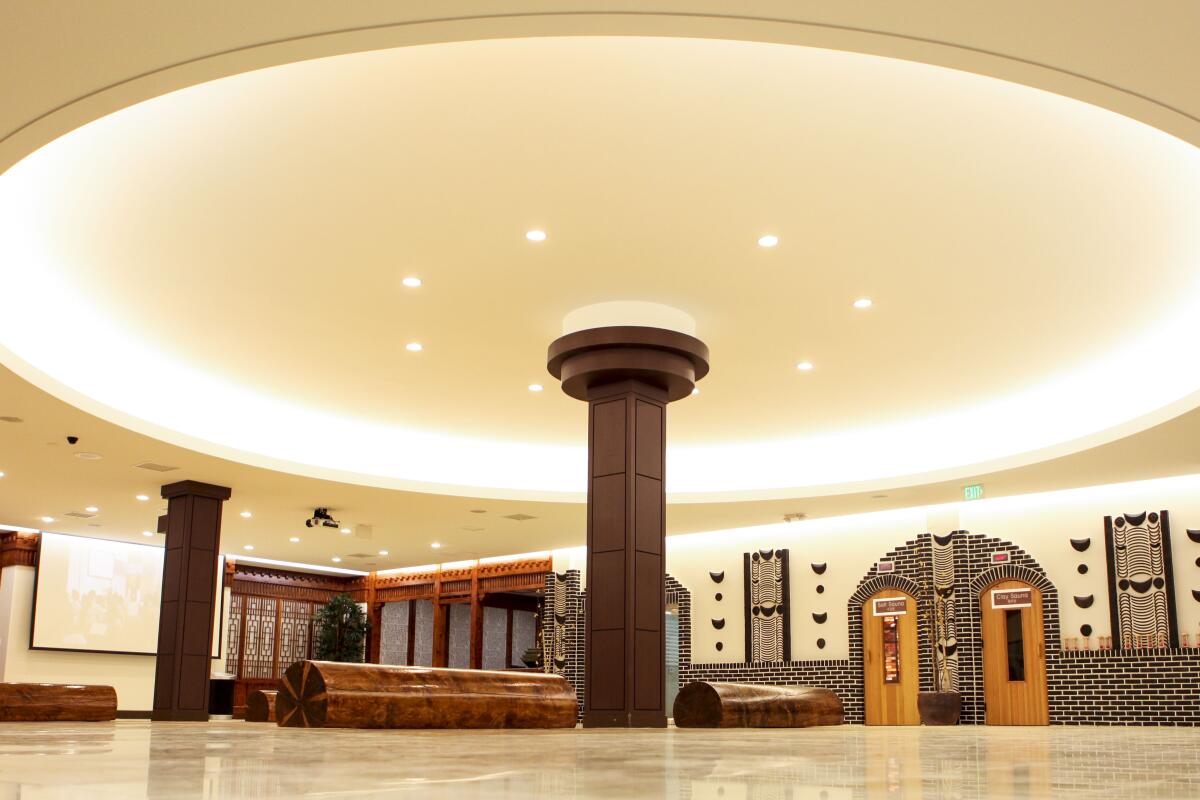
The spas in and near that neighborhood offer baths; saunas involving salt, clay, jade and ice; facials; manicures and pedicures; massages; and more. Body scrub? You’ll feel clean and tender as a piece of lumber freshly planed and sanded. A 30-minute session usually costs about $50.
Every spa does things its own way, but nudity in gender-segregated areas is a common feature. Coed and family areas are known as jimjilbang, and there’s usually a food option. The Crystal Spa (open daily, $30 a day) serves men, women and children over age 10. The Olympic Spa serves only women 18 and over. Aroma Spa & Sports includes yoga, aerobics, a big pool and a rooftop driving range. Wi Spa, a few blocks east of Koreatown on Wilshire, invites families and has a gym, restaurant, computer area, kid zone and rooftop terrace. (It’s open around the clock, charging nonmembers $30 per adult.)
Bonus tip: Koreatown was born in the 1970s as Korean immigrants moved in along Olympic and Wilshire boulevards between Vermont and Western avenues. Its many restaurants and bars have made it into perhaps the city’s busiest nightlife zone. One dinner favorite is Sun Nong Dan, which is open around the clock and is part of a four-location chain. (If there are at least two of you, get the galbi jjim, short ribs in a spicy stew.)
52. Get lost in L.A.’s best book nook
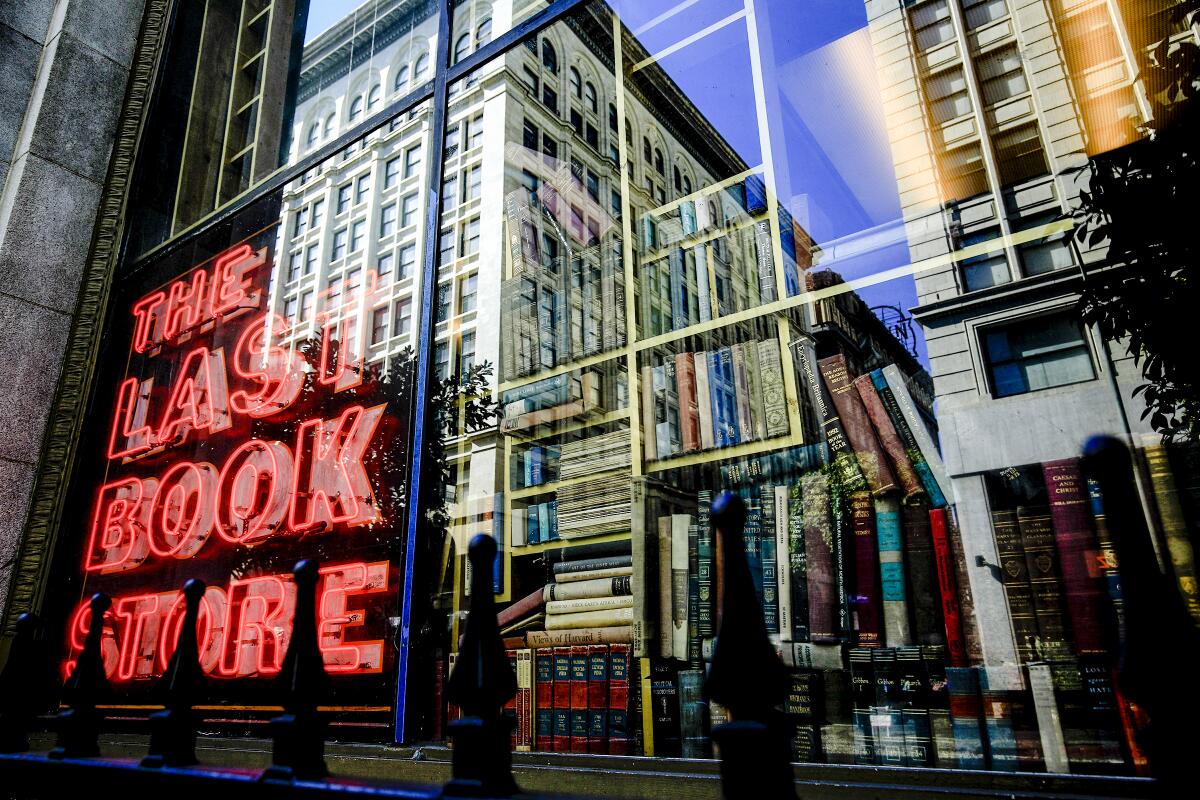
The Last Bookstore opened in 2005 as booksellers were faltering across the land, then expanded into this 22,000-square-foot space in 2011. The ground floor is filled with new and used books; used vinyl, CDs and DVDs; an annex for art and rare books; and a stage for readings and other performances. The tall, white columns, circa 1915, suggest you may be sifting through the ruins of a lost civilization. Dangling artworks hint at magic in progress.
But the flashiest bit is yet to come. On the upstairs mezzanine, you find the Horror Vault and the Labyrinth, where used books sometimes are arranged by subject, sometimes by color, sometimes sculpturally. Don’t miss the tunnel. Around the periphery, studios harbor makers with work for sale. If literature is dead, don’t tell this place’s 136,000 Instagram followers. Open daily, 11 a.m.-8 p.m.
Bonus tip: There are at least two other cool bookshops downtown: Hennessey + Ingalls (art and architecture, Arts District) and Kinokuniya (lots of manga, Little Tokyo). And the Central Library (with its amazing mural-lined rotunda and stained-glass globe) is just four blocks away at 630 W. 5th St.
53. Be spellbound at the Magic Castle
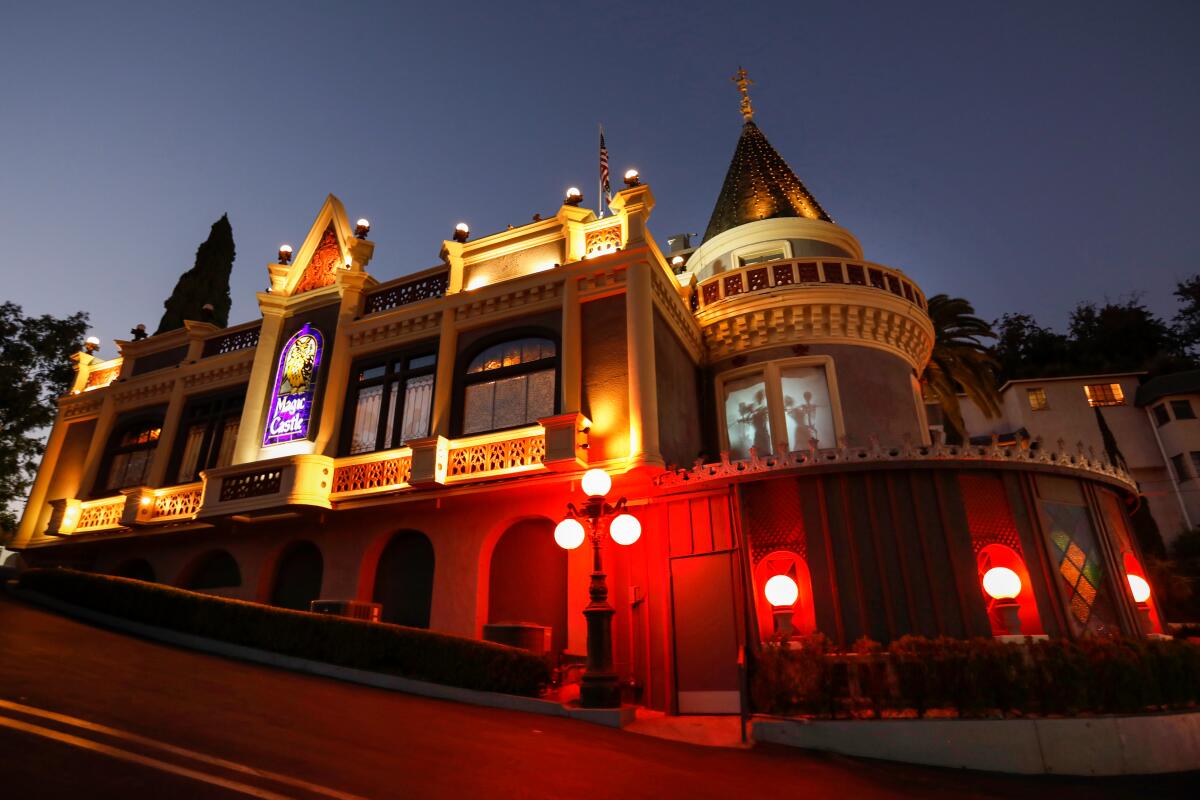
Inside you’ll find a dash of Vegas, a dash of Hollywood history, a dash of deep magic geekdom (more Harry Houdini, less Harry Potter). With an invitation from a member, you can make a reservation and turn up in formal attire, hand over $35-$45 per person, then step in through the secret door (which might or might not involve a bookcase). You’ll find a series of rooms with oak paneling, eerie oil portraits and handy bartenders. You’re obliged to order in the snazzy dining room (entrees: $45-$60). Proceed to a 45-minute magic show in the main theater, then meander through the mansion, dropping in on card tricksters, sleight-of-hand artists and other entertainers. The club is adults-only except for brunch performances on weekends, when children are welcome.
Bonus tip: Book a night at the Magic Castle Hotel, next to the castle, and you’re in at the castle itself — no invitation from a member required. The hotel is a ‘50s apartment building that’s been converted and stocked with free snacks. Rates start about $225 (and most units have kitchens). The furniture and grounds are worn, but service is snappy and family-friendly. And one other thing: That red phone next to the pool? That’s the free popsicle hotline.
54. Stride from Main Street to Mendocino's bluffs
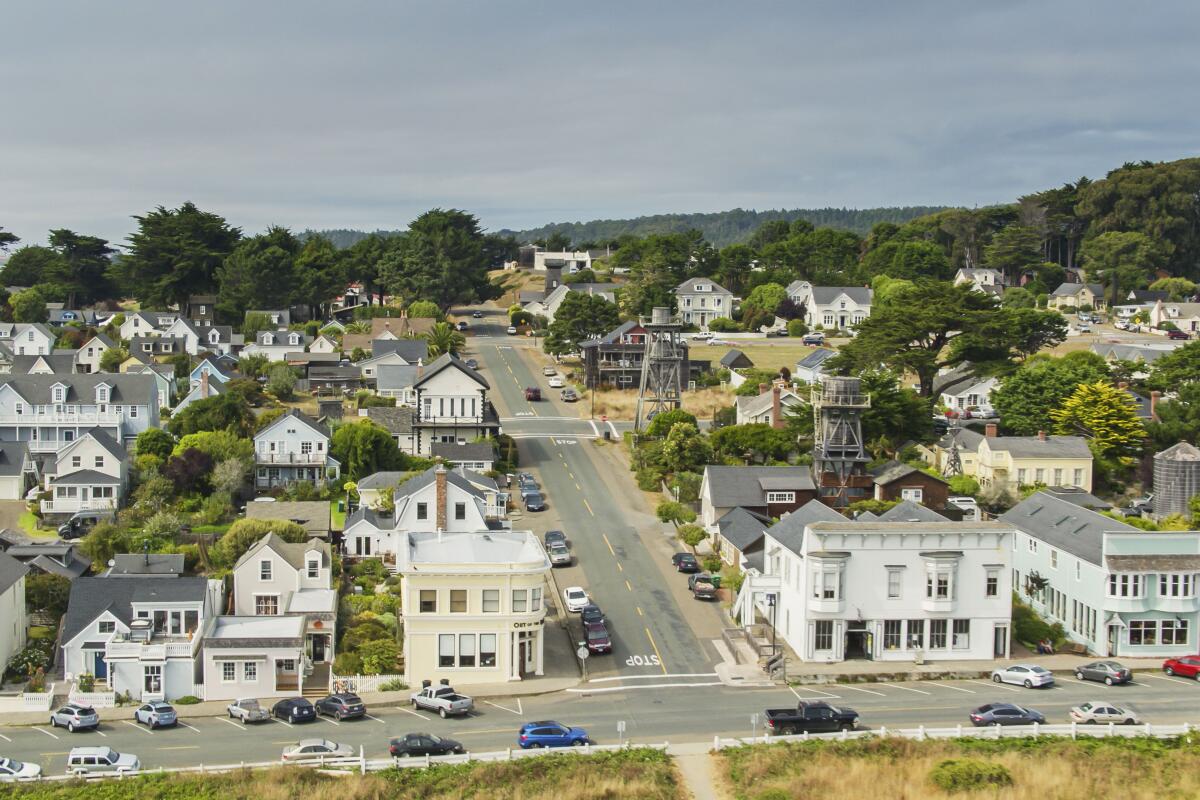
Be sure to venture into Mendocino Headlands State Park, which surrounds the village. Take the easy Mendocino Headlands Bluff Trail and admire the driftwood on Portuguese Beach and Big River Beach.
Bonus tip: The Fog Eater Cafe on Albion Street is a tiny, vegetarian, Southern diner that serves dinner Wednesday-Saturday and brunch on Sunday. I had a great meal there on my last visit. The restaurant’s backyard neighbor is the recently opened Fog Bottle Shop, specializing in natural and organic wines and house-made snacks.
55. Snack and sip on the Malibu Pier

Bonus tip: For a beach experience that’s more Gidget and less Gucci, think about Paradise Cove, eight miles west of the pier. It’s just about ideal for entertaining out-of-towners. The Paradise operation includes a sequestered beach with a lively restaurant, beach-gear rentals, lifeguards, reclining seats on the sand and servers fetching burgers and rum drinks. Be sure to spend more than $30 in the restaurant and less than four hours at the cove. Otherwise, your $10-$15 tab for parking will inflate to as much as $65.
56. Hurtle down Mammoth Mountain at its snowiest
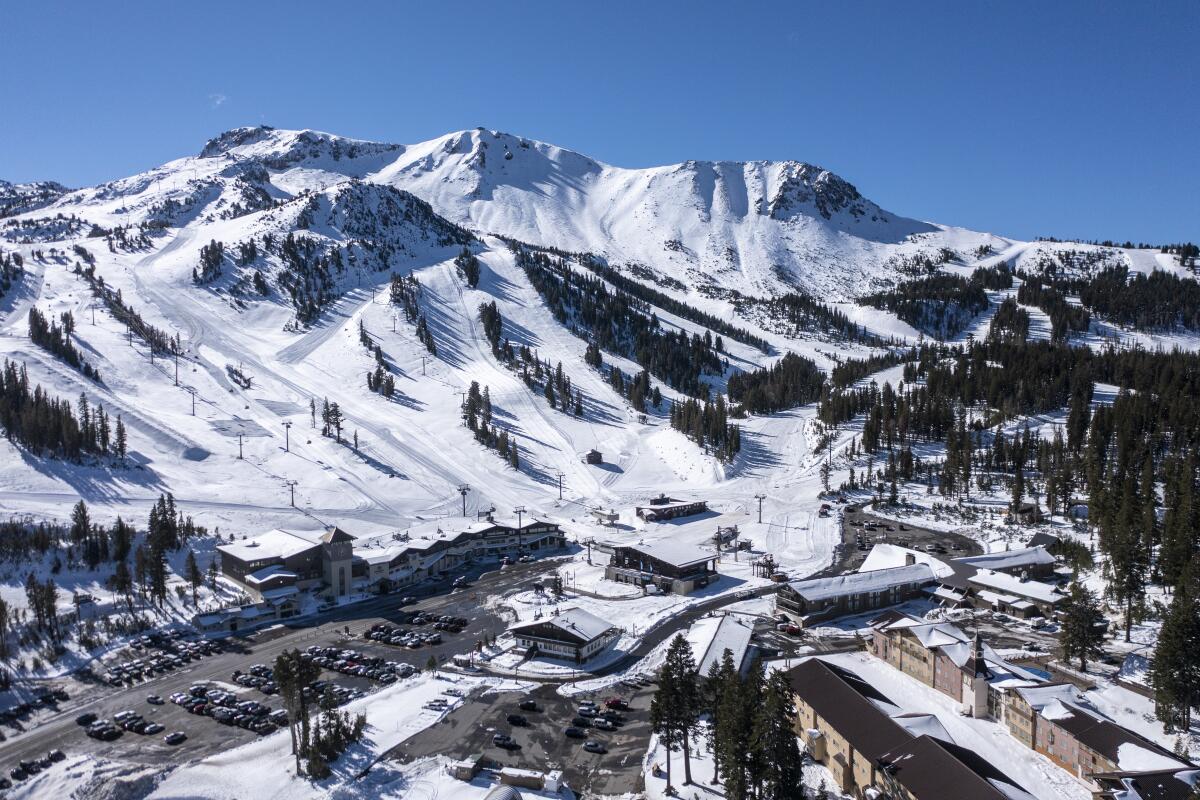
The mountain ski operation was founded in 1953 by a moonlighting hydrologist named Dave McCoy, who died in 2020 at age 104. Because the snow will melt eventually, I should mention that the mountain’s summer offerings include more than 80 miles of single-track trails for mountain-bikers, a via ferrata for climbers, assorted hiking trails and gondola rides to the summit. There’s also golf and fishing. And outside town, there’s also Camp High Sierra, Devils Postpile National Monument, Rainbow Falls and horseback riding at Red’s Meadow Resort. For a quiet dinner, head for the Lakefront in Tamarack Lodge, a 1924 log cabin.
Bonus tip: To break up the 300-mile L.A.-to-Mammoth drive up the Owens Valley, detour into the rugged Alabama Hills near Lone Pine, where dozens of movies and TV shows have been shot, including the first “Lone Ranger” film in 1938. Check out Lone Pine’s Museum of Western Film History, which has maps of filming locations. Farther up the road you’ll hit Bishop, the best place for a bite or overnight between Los Angeles and Mammoth.
57. Remember the prisoners of Manzanar
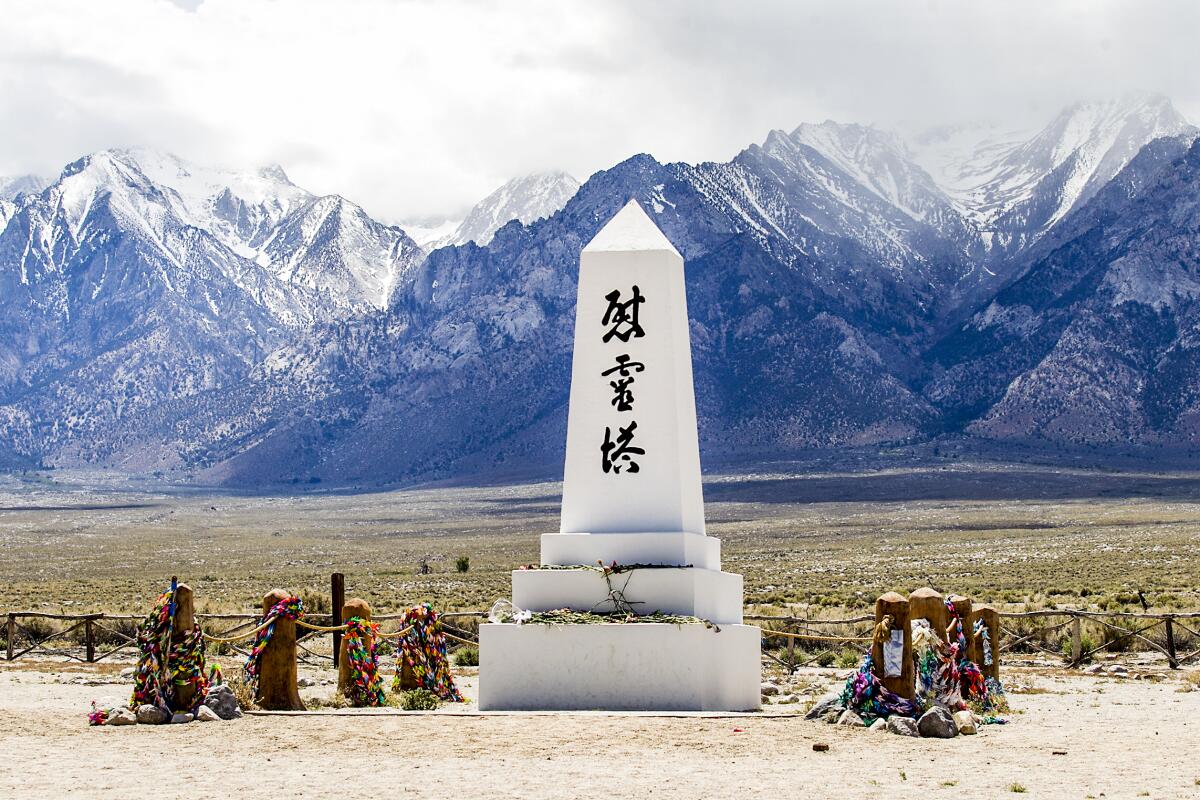
When you drive the camp’s three-mile periphery, pause at the cemetery, where a tall monument is etched with Japanese characters. There’s a visitor center, theater, museum and reconstructed barracks, where exhibits explain how families lost property, converted fruit crates into furniture and debated whether their mess hall should serve Japanese or American dishes. The U.S. government paid some reparations in 1948. Manzanar’s video presentation includes a 1988 speech in which President Reagan declared the incarcerations “a mistake” and authorized more compensation for survivors.
Bonus tip: At least 10 white Americans were convicted of spying for Japan in that era. But NPS research found that no person of Japanese ancestry living in the United States was ever convicted of any serious act of espionage or sabotage during the war.
58. Listen (and eat) in Mariachi Plaza

To the west, there’s the historic Boyle Hotel, once a hangout for wayward musicians, now affordable housing upstairs and the downstairs home of a La Monarca Bakery & Cafe and the Libros Schmibros Lending Library (which has a well-curated selection in English and Spanish).
There are several tempting casual places to eat and drink around the plaza, including Street Tacos and Grill and Yeya’s at 1816 E. 1st St. If you crave something more upscale, there’s the colorful Casa Fina at 1842 E. 1st St., which old-timers will remember as the home of the beloved Serenata de Garibaldi restaurant from 1985 to 2017.
Bonus tip: On a warm day, head for the northwest corner of the plaza, near Boyle Avenue, where the J&F ice cream shop stands. Get a smoothie and admire the tall statue of Mexican singer Lucha Reyes, who presides over the shady benches where musicians play cards and wait for gigs.
59. Slurp oysters at the Marshall Store on Tomales Bay
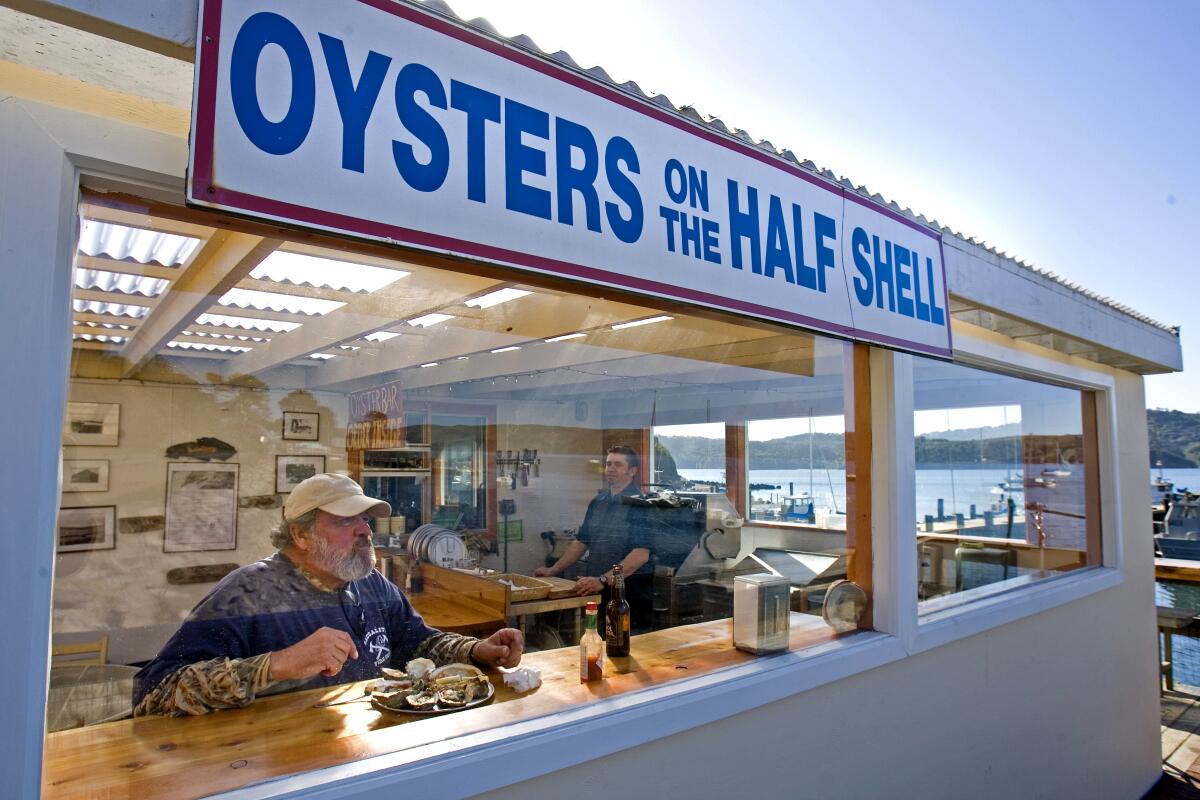
Bonus tip: Beneath long, narrow Tomales Bay lies a bit of the 800-mile-long San Andreas Fault, the great quake risk that runs from the Salton Sea to Mendocino County. Walk the nearby Point Reyes National Seashore‘s 0.6-mile Earthquake Trail, which starts near the Bear Valley Visitor Center.
60. Refuel at at the rustic chic Mattei’s Tavern
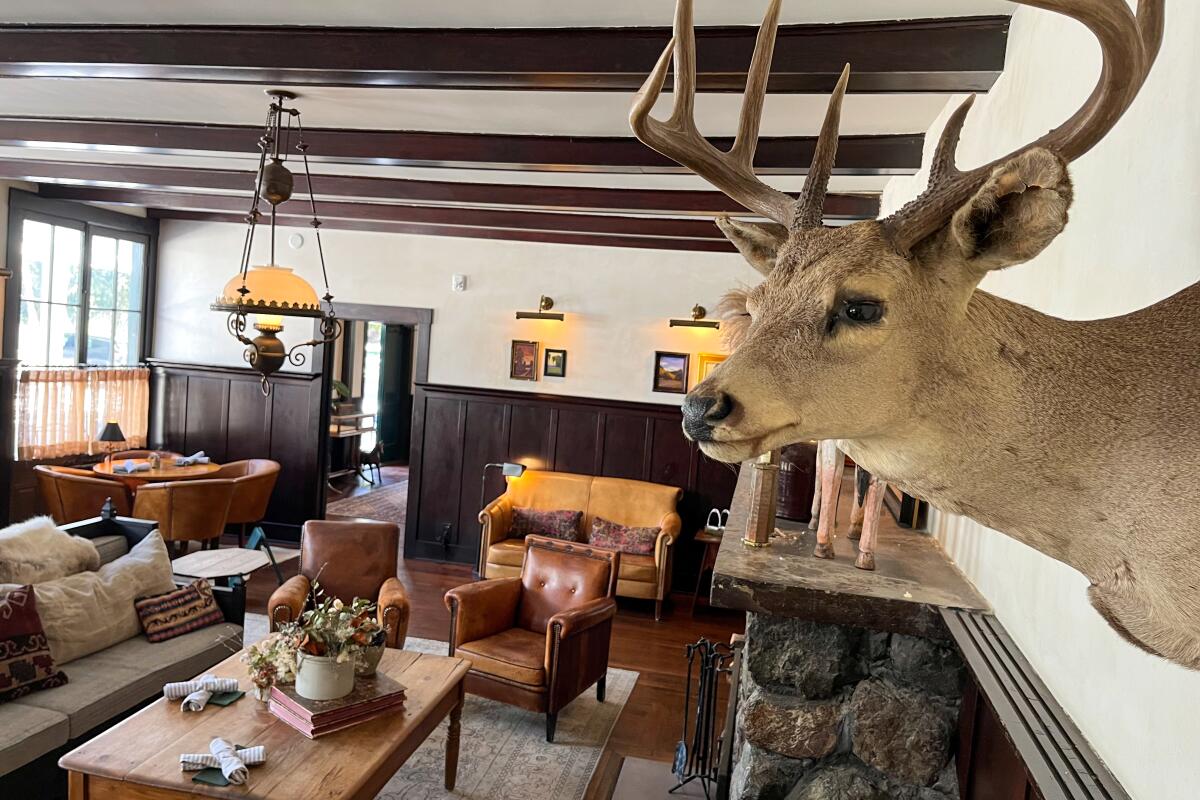
Only a fortunate few can afford the 67 rooms at the Inn at Mattei’s Tavern, which begin around $800 nightly (it’s part of the luxe Auberge Resorts chain). But a tavern breakfast, lunch or dinner may be within reach, and on the way you can stroll the carefully tended grounds and browse its public rooms, which are full of antiques and art celebrating the tavern’s history and frontier mythology. The property, which dates to 1886, was closed for several years (and its owner convicted of wire fraud) before an ownership change, renovation and reopening late in 2022. For breakfast, try the huevos rancheros ($24). Then stroll a block east to Grand Avenue, where you’ll find tasting rooms, boutiques and restaurants. Jedlicka’s (since 1932) is a western wear shop with an iconic horse statue out front. Across the alley, the Wine Merchant & Cafe’s patio always seems to be busy.
Bonus tip: Tighter budget? Head for the Cork and Oak Deli in R Country Market, which has a handful of sidewalk tables and tri-tip quesadillas (gooey cheese, tangy meat) for $11.99.
61. Ogle seacliffs and slopes at Montaña de Oro State Park
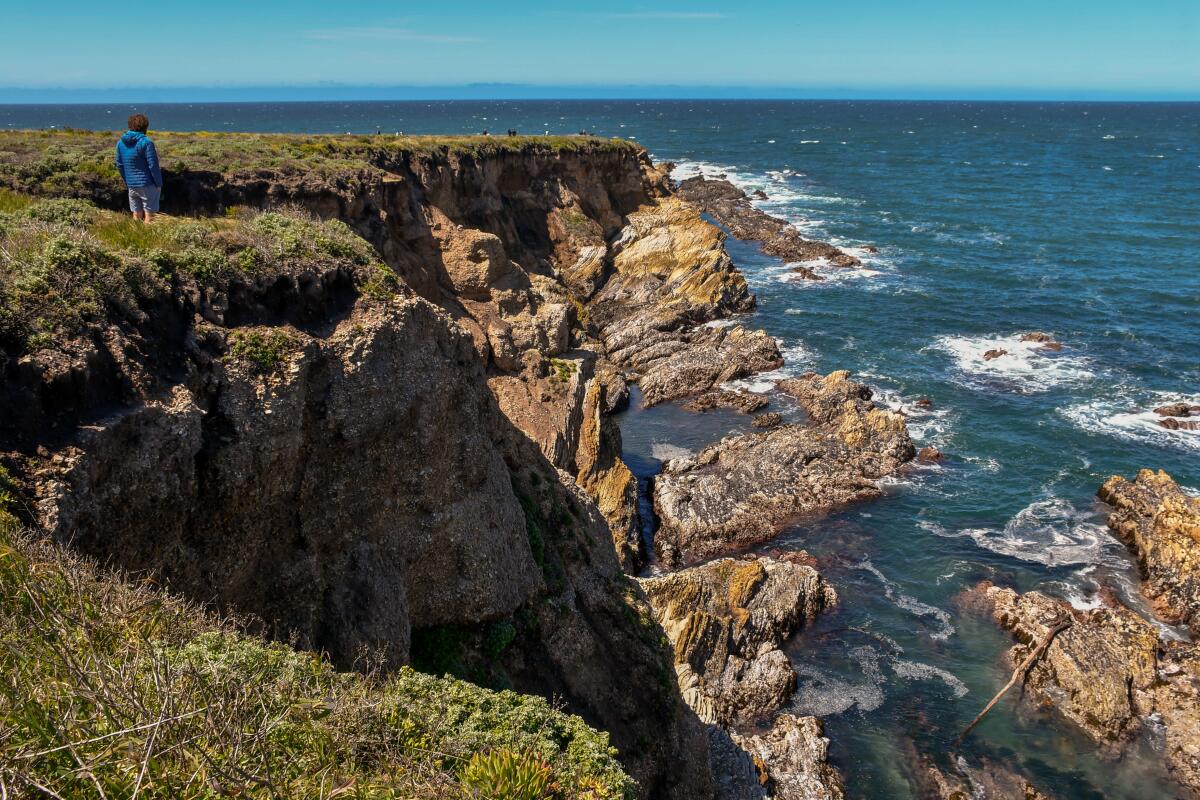
Bonus tip: The Bluff Trail was full of great coastal views. But I did have to change my route once — when a rattlesnake slithered across the grass-fringed trail ahead of me. At Montaña de Oro and elsewhere, snakes have more places to hide this spring.
62. Get next to sea creatures at Monterey Bay Aquarium
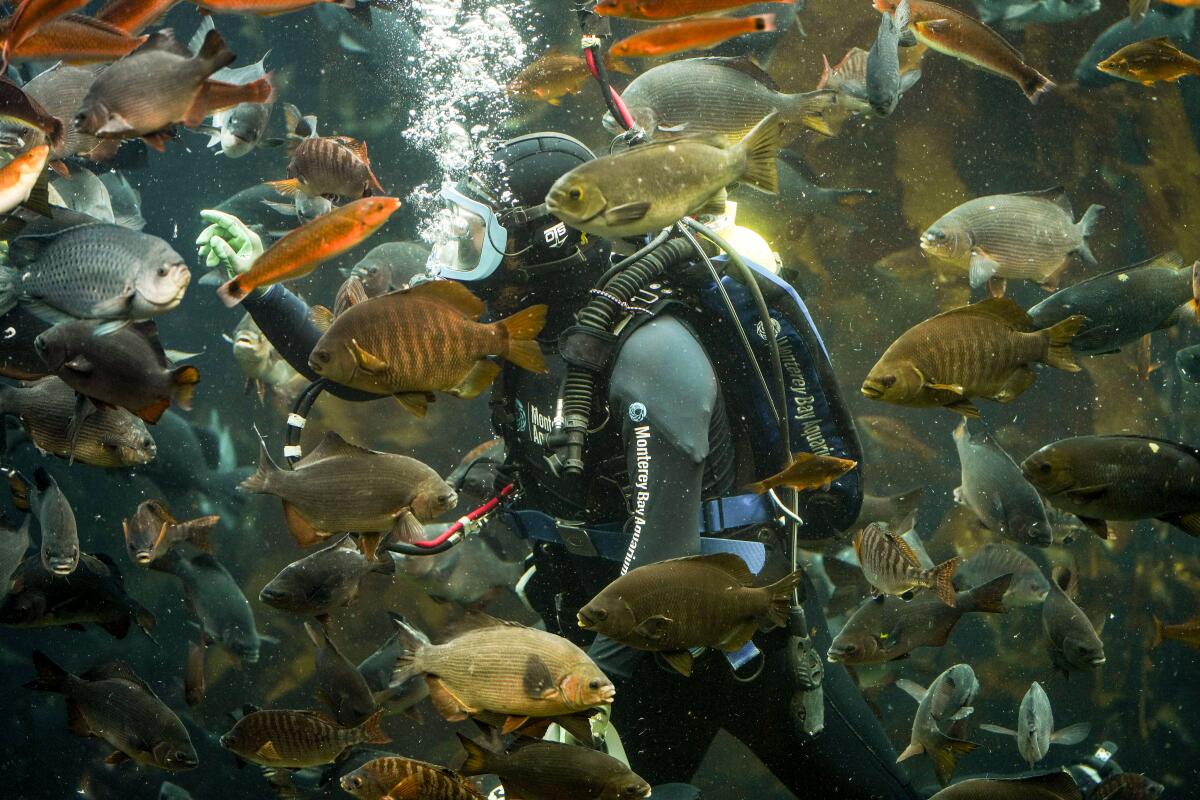
Bonus tip: Rent a kayak or bike from Adventures by the Sea and paddle the bay or pedal along Ocean View Boulevard toward Lovers Point and Asilomar State Beach in Pacific Grove. Or just drive to Lovers Point Park in Pacific Grove, where gnarled cypress trees, jutting rocks, hanging fog and irresistible otters can often be found. The 17-Mile Drive at Pebble Beach and its iconic Lone Cypress ($11.25 per car) are nearby too.
63. Build a driftwood mansion on Moonstone Beach Drive
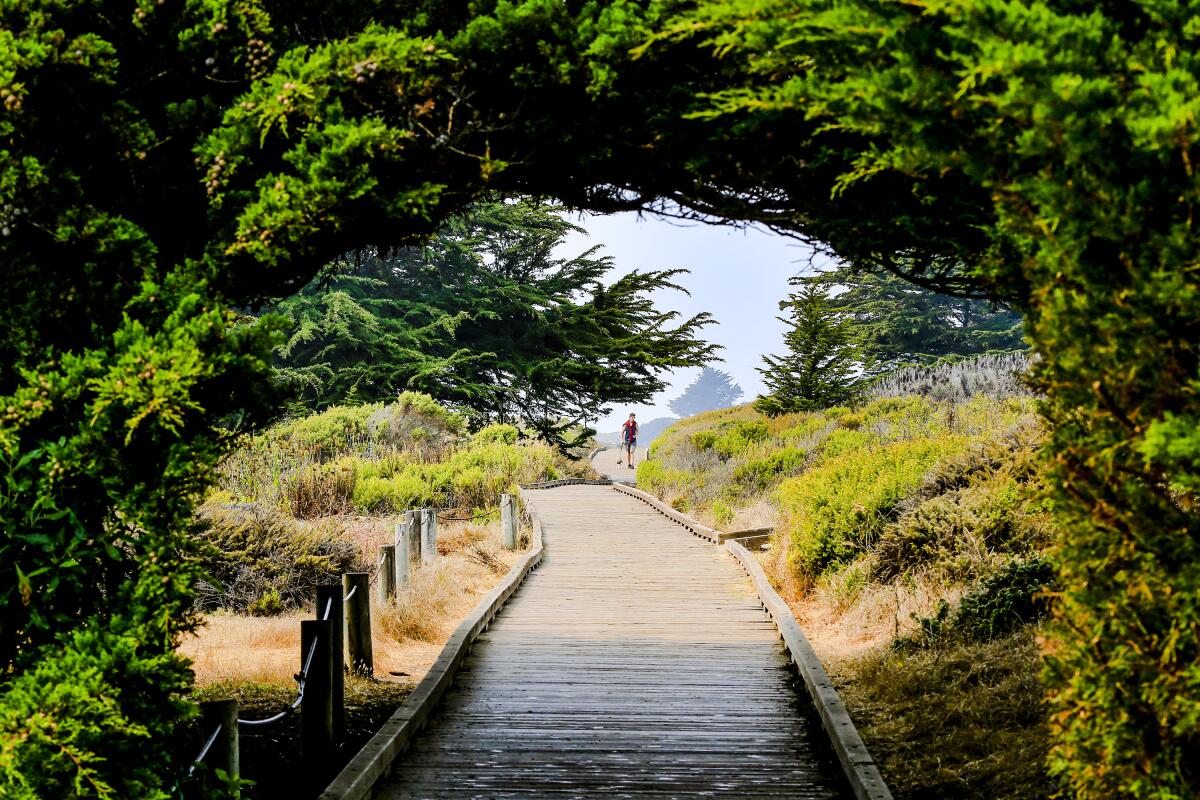
One of my favorite family lodgings is Oceanpoint Ranch, which has 61 rooms on its generous 9-acre property, along with a pool, shuffleboard, horseshoes and a casual Canteen restaurant. Summer rates start at about $225. For a more romantic vibe, try Whitewater down the street.
North of the boardwalk, Leffingwell Landing Park begins, offering more trails and coastal views. To the south, there’s the 437-acre Fiscalini Ranch Preserve.
The city’s east and west villages sit a bit inland, and Main Street includes art galleries and boutiques but no chain stores.
Bonus tip: For dinner, you might sample the eclectic menu at Robin’s Restaurant (a mainstay for more than 25 years). Or dig into olallieberry pie at Linn’s Restaurant (which has been around for more than 30 years). Or slurp chowder at the Sea Chest Oyster Bar. But if you choose the Sea Chest, as many visitors do, be warned: You’ll need to line up at the restaurant at 5:30 p.m. to put your name in for the evening. They don’t take any other kind of reservations. And payment is cash only.
64. Walk or paddle in Morro Rock’s shadow
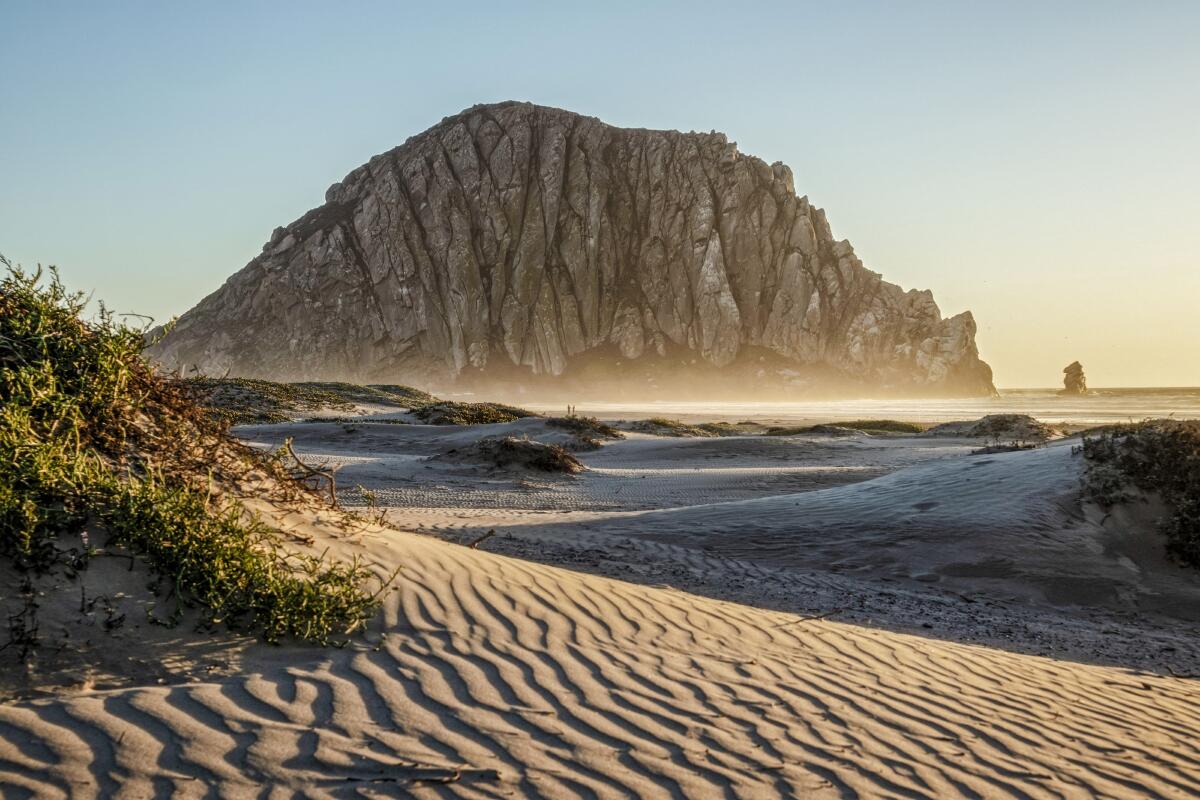
Some can be climbed for nice views (including Black Hill and Cerro Cabrillo in Morro Bay State Park), but not this sister. Admire her from the Morro Bay embarcadero or Morro Rock Beach at the end of Coleman Drive (where there’s a parking lot). Or from the dunes. Or a kayak. Or Morro Bay State Park, which includes a stretch of shoreline south of the rock.
Morro Bay’s waterfront galleries and shops are nice for a few hours’ browsing, and there are watercraft rentals. At local eateries, keep an eye out for Morro Bay oysters. Or go with a quick Mexican bite from Taco Temple on North Main Street.
Bonus tip: You can usually see otters (and often their pups) at the Morro Bay South T Pier along the embarcadero, next to Great American Fish Company.
65. Make tracks on Mt. Tam
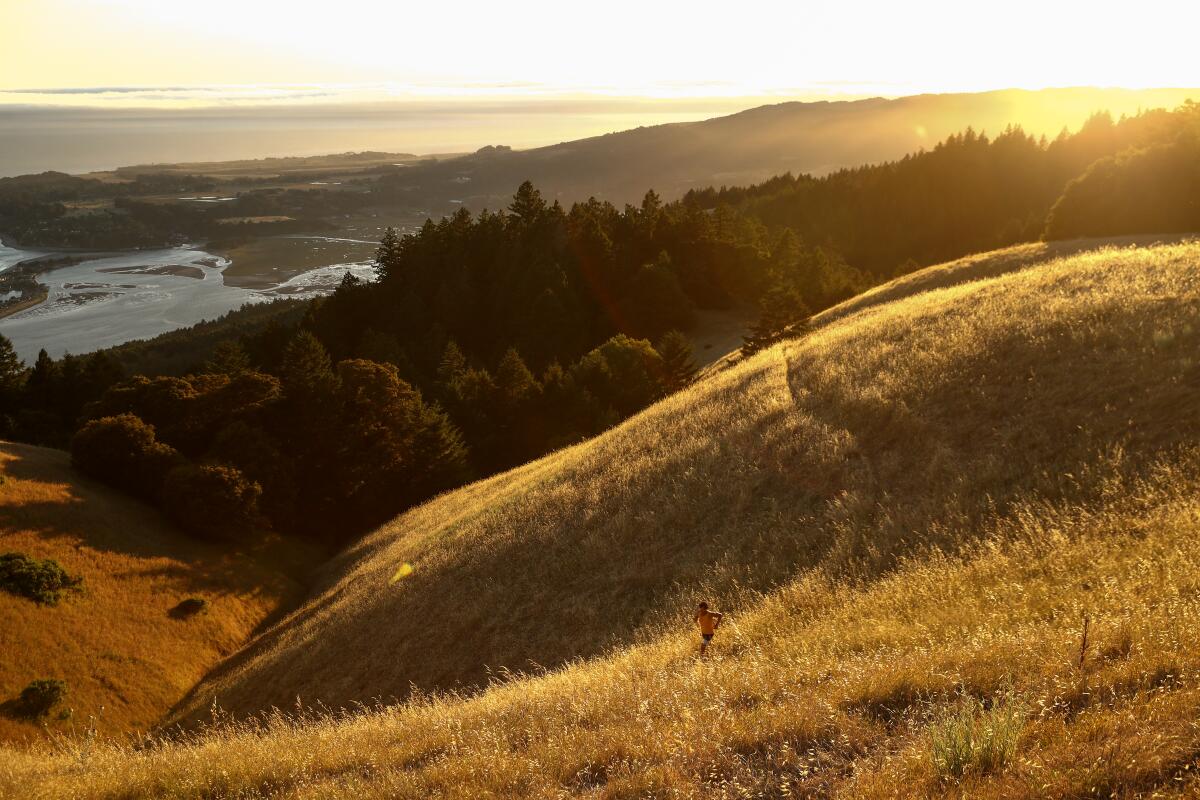
Bonus tip: If you hike or ride Dias Ridge, you’ll end at Muir Beach by the Pelican Inn, a facsimile of a 16th century English pub with seven snug guest rooms ($285 per night and up, modern plumbing) and a menu full of beers, ales and hearty British dishes. It’s named for one of Sir Francis Drake’s ships. If Shakespeare had found this place, he’d never have gone home to Stratford and “Titus Andronicus” might end with a mountain-bike chase and a few rounds of ale instead of so many dead people.
66. Lose your balance at the Mystery Spot

It’s good, clean, kitschy fun (“nature’s black magic”), neighbored by a 30-minute hiking trail amid redwoods, oak and eucalyptus. It’s open daily with tours every half hour, reservations recommended. Besides the $10 admission fee, parking costs $5 per vehicle (cash and checks only). But you do get free bumper stickers at the tour’s end. And the gift shop — it’s as cheesy and extensive as they come. I went home with a tilted coffee mug.
Bonus tip: Unique as it may seem, the Mystery Spot is part of an entire genre of roadside attractions based on optical illusions and gravity and born in the 1930s and ’40s. Others include the Oregon Vortex (since 1930 in Gold Hill, Ore.), Trees of Mystery (since 1946 in Klamath) and Confusion Hill (since 1949 in the Mendocino County town of Piercy), and Mystery Hill (since 1958, or perhaps earlier, in Blowing Rock, N.C.)
67. Eat at Nepenthe, high above Big Sur
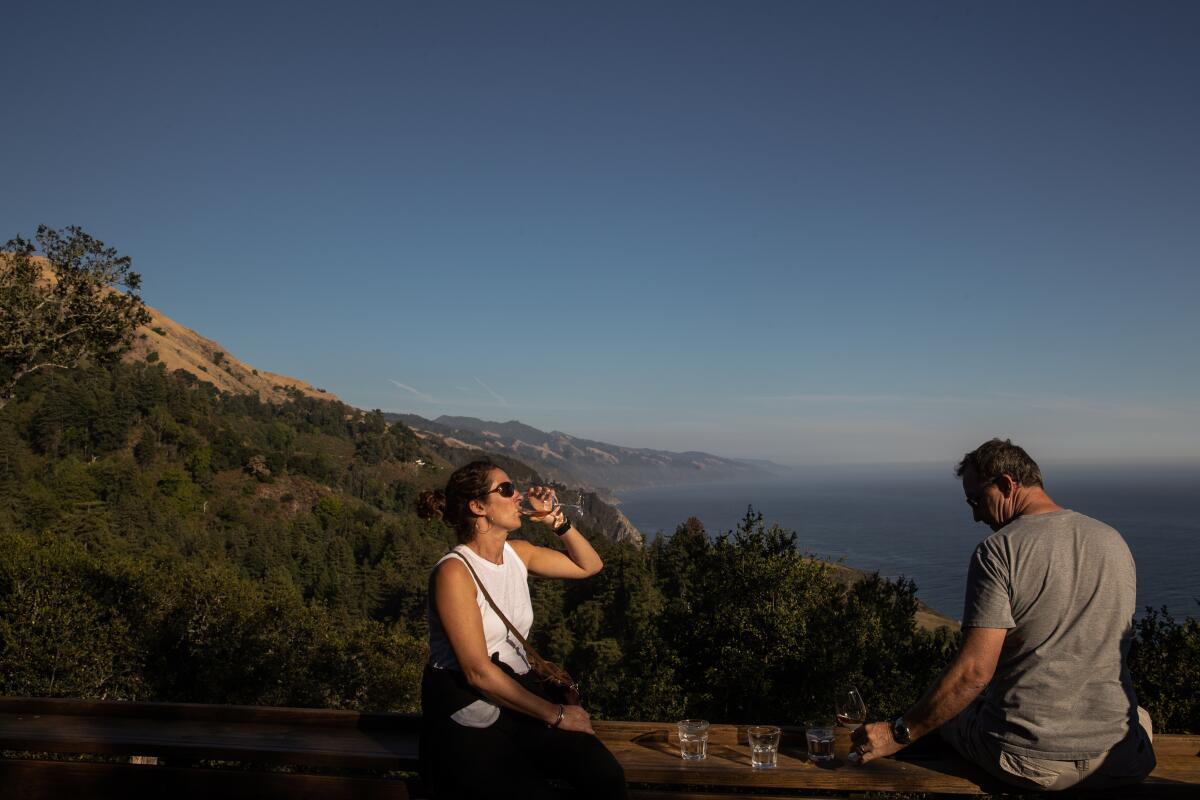
At this clifftop compound of two restaurants and a gift shop, diners since 1949 have gaped at the surf and rocks 800 feet below. Nepenthe restaurant does lunch and dinner indoors and out, including its celebrated Ambrosia burgers and vegetarian burgers. Café Kevah, on a terrace, does breakfast and lunch.
The difficulty, of course, is Highway 1, which includes 75 of the most celebrated and spectacular miles you’ll find on the West Coast but closes often for mudslide and rockfall repairs. (As of early May, the highway was closed just north of Ragged Point, with reopening forecast for sometime after July 14.) Double-check with Caltrans before any Big Sur drive.
And if the road is open, there will be many chances to hike off some of your Nepenthe calories. In Julia Pfeiffer Burns State Park, you’ll find the half-mile trail overlooking McWay Falls. In Andrew Molera State Park, the Bobcat and East Molera trails are open (but many others are closed for now). At Bixby Creek Bridge, you’ll find a familiar view and distracted drivers jockeying for parking spots.
Overnights can be challenging, because affordably priced public campgrounds book up far in advance and at Big Sur’s two most famous hotels, the Post Ranch Inn and Ventana Big Sur, the tab for two nights might exceed your monthly mortgage. Two hotels to try in the $200-to-$500 range: Big Sur River Inn and the Glen Oaks Resort.
Bonus tip: You’ll see another facet of Big Sur’s bohemian character half a mile south of Nepenthe at the Henry Miller Library (which is really more of a cultural center and bookshop). A third of a mile beyond that, also to the south, is Deetjen’s Big Sur Inn, a throwback lodging and restaurant so memorable that it has its own place on this list.
68. Listen in at the Richard Nixon library
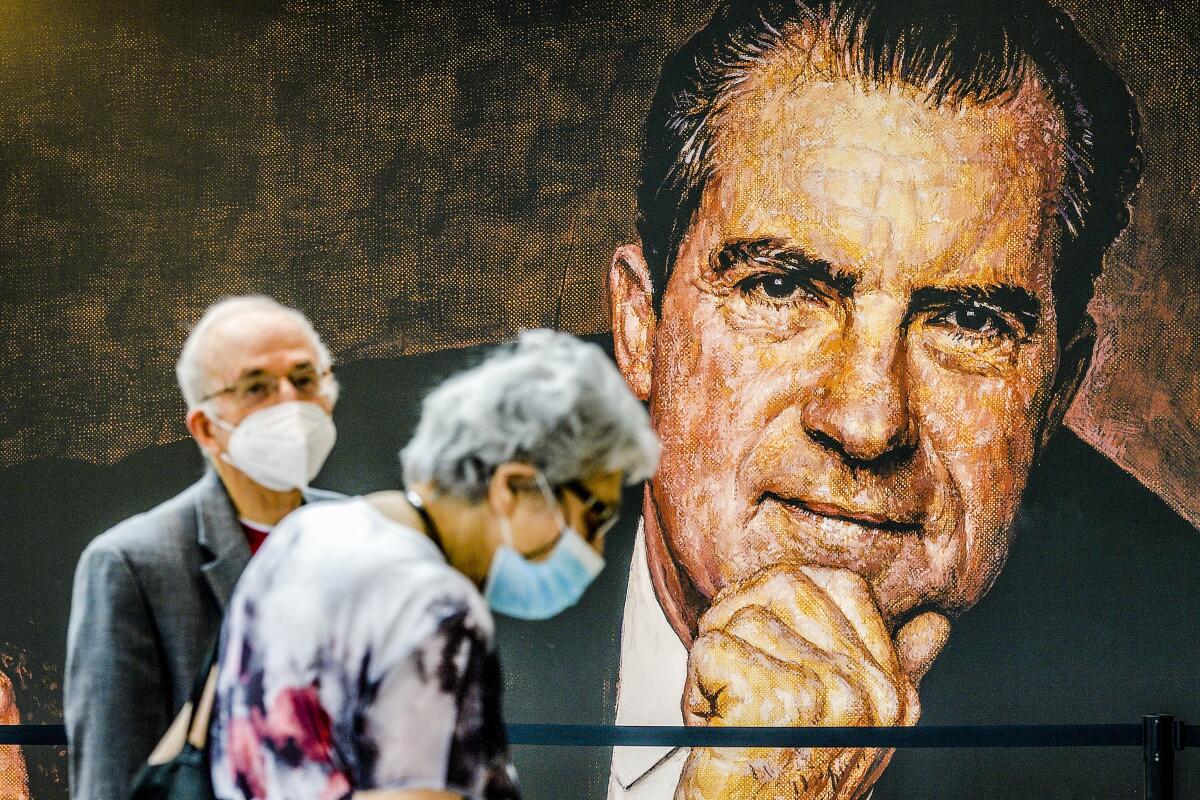
As shown in dozens of exhibits on the 9-acre site, Nixon negotiated the U.S. withdrawal from Vietnam, created the Environmental Protection Agency and, in a 1972 visit, made a major diplomatic breakthrough with China. But operatives of his campaign were caught breaking into Democratic National Committee headquarters (in the Watergate office complex), and then Nixon and top aides were caught trying to cover it up. His own secret tapes sealed his fate. He is the only U.S. president to resign.
Nixon and his wife, Pat, are buried here next to the modest home where Nixon was born, which is now part of the library grounds. (There’s also a presidential helicopter on site.) She died in 1993; he died in 1994.
Adult admission to the library is $16 (compared to $29.95 at the Reagan Library in Simi Valley).
Bonus tip: The National Archives has digitized all 4,042 reels of Nixon’s infamous White House tapes and more recordings are being declassified every year. Whether you’re in the library or on a computer at home, you can now eavesdrop on the president as he makes phone calls, confers with Secretary of State Henry Kissinger, considers dropping Spiro Agnew as his vice president and ponders relations with China and India.
69. Eat Italian and read bohemian in North Beach
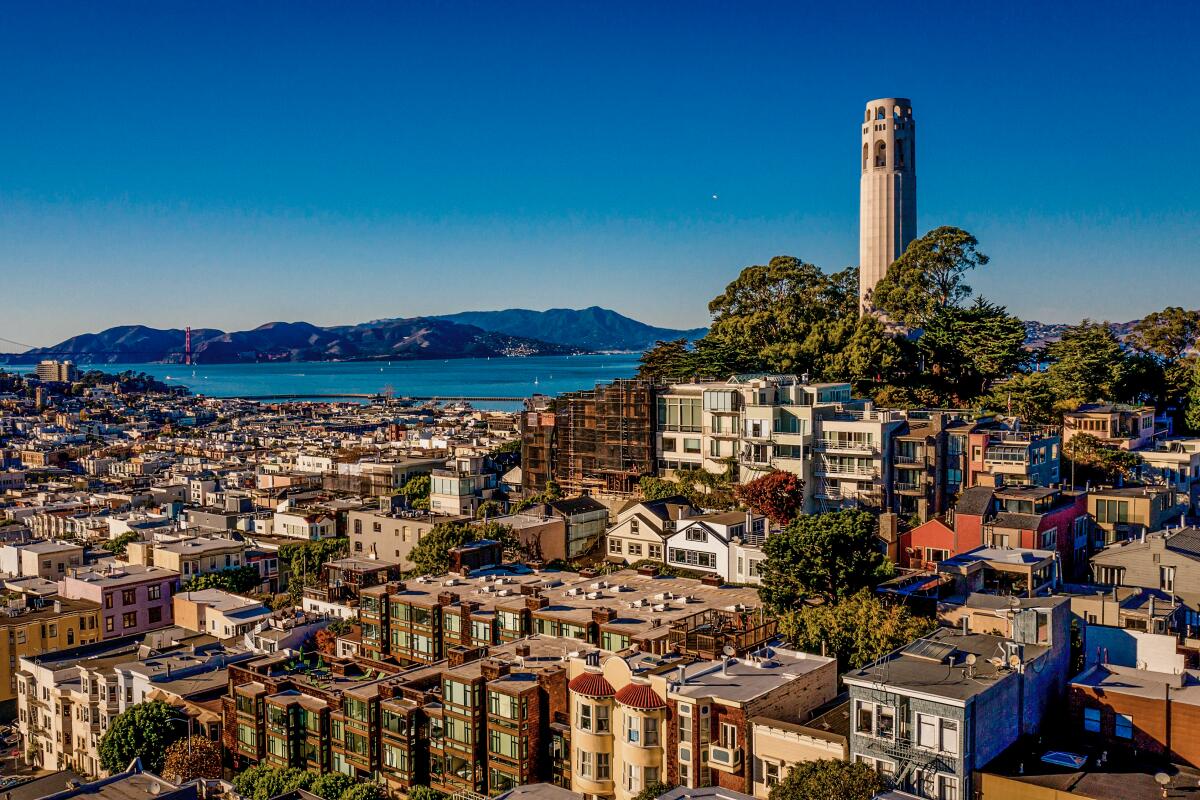
Now you might be a little shaky, but don’t miss Coit Tower, where you can admire the witty Depression-era murals and unmatchable views of the city, bay and bridges. It’s $10 per adult, $7 for San Francisco residents.
Hungry? Get a big, messy sandwich at Molinari Delicatessen (established 1896) and eat it in Washington Square. Or get coffee at Caffe Trieste (since 1956), prizeworthy pies at Tony’s Pizza Napoletana on Stockton Street or seafood at Sodini’s or Sotto Mare on Green Street.
Bonus tip: The shops and eateries of Chinatown (next to North Beach) suffered deeply through the pandemic, but the stylish China Live restaurant complex stays busy. It’s on Broadway, about 400 feet from City Lights. Two other lively, upscale Chinatown restaurants within an easy walk: Empress by Boon on Grant Avenue and Mister Jiu’s on Waverly Place.
70. Hang with Impressionists at the Norton Simon

Pro tip: Even if you’ve never set foot in Pasadena, odds are good that you’ve seen this museum’s brown-tiled exterior. That’s because it stands at the corner of Colorado and Orange Grove boulevards, the prime turn (and TV camera location) along the route of the Rose Parade.
71. Step into history for kids in Old Sacramento
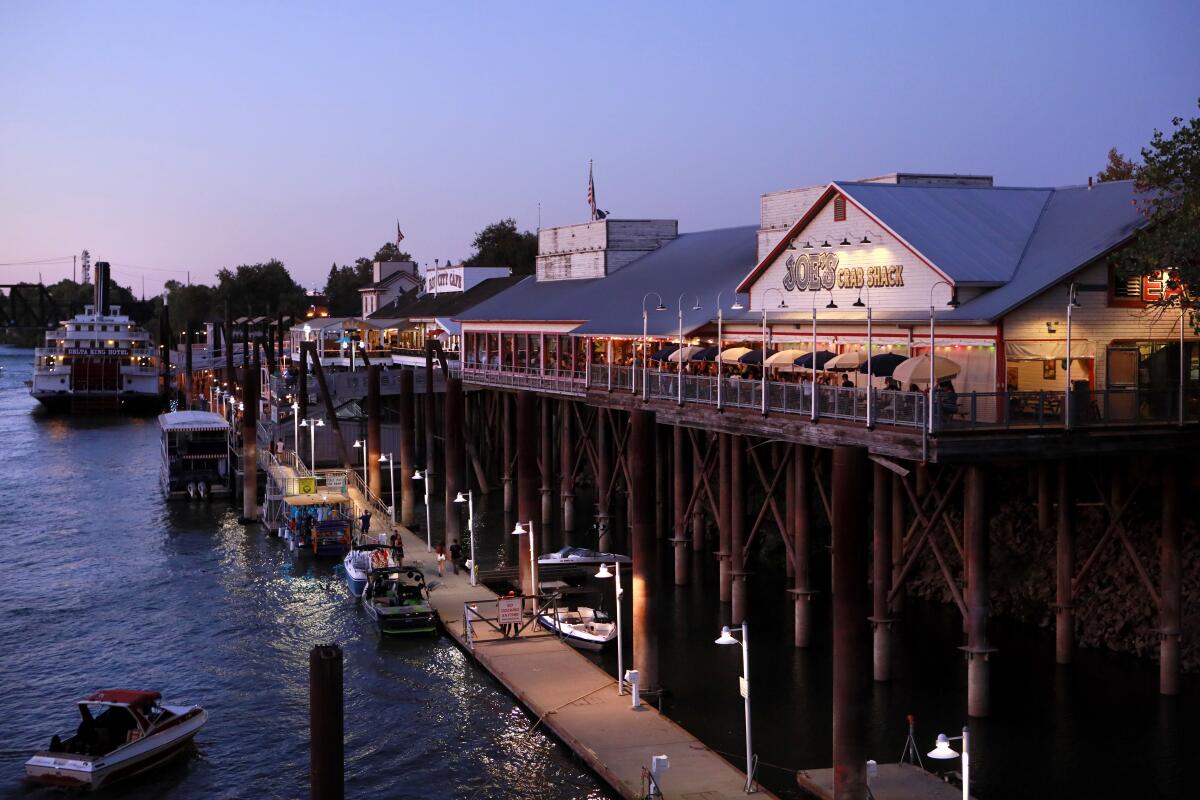
The park is basically the old core of downtown Sacramento — a 296-acre area that includes more than 50 historic buildings and the western terminus of the first transcontinental rail route. Besides its horse-drawn carriage rides, wooden sidewalks and touristy shops, the area includes the California State Railroad Museum, home to about 20 steam locomotives and an array of exhibits exploring the outsize role of railroads in the state’s history. The park stands beside the Sacramento River, the emblematic Tower Bridge and the Delta King, a 1927 paddle-wheel riverboat that’s now a hotel.
For anyone assembling a family itinerary — especially for a fourth-grader who is supposed to be studying state history — the park slots in nicely alongside the state Capitol and its museum (closed on weekends) and Sutter’s Fort State Historic Park (open daily).
Bonus tip: Before the transcontinental telegraph and railway were completed, Sacramento was the last stop for the 1,966-mile Pony Express. At the corner of 2nd and J streets, you’ll find a sculpture of a slight young man on a horse (riders had to weigh less than 125 pounds). The sculpture is a tribute to the express, which only lasted from April 1860 to October 1861. (The service’s eastern terminus was St. Joseph, Mo.)
72. See what's in the gleaming Orange County Museum of Art
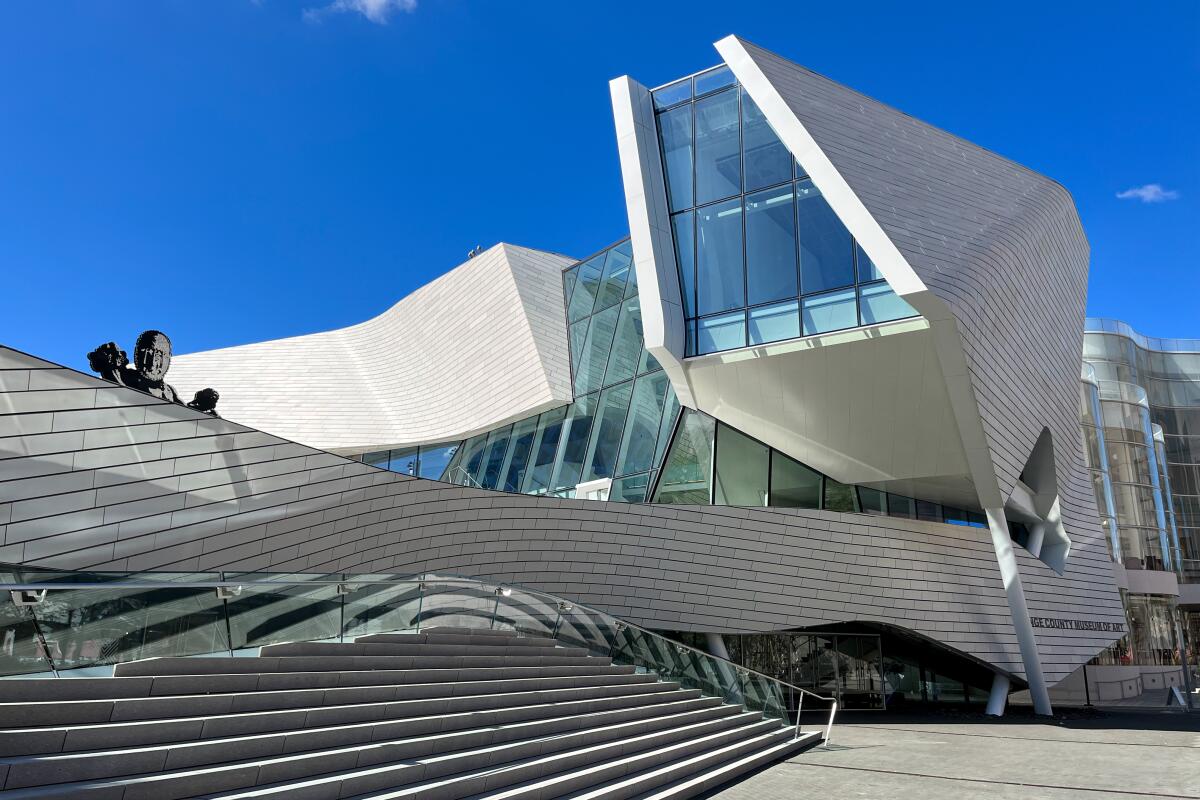
Do not look for Impressionists here. Or pleasant California landscapes. OCMA’s mission is to confront us with challenging contemporary work — a bracing contrast to the surrounding suburban landscape. Through June 4, an exhibition by Daniel Arsham plays with the idea of how our current culture (including our phones) will look as ruins in the future. Atop the building (through Aug. 13) rises “Of Many Waters...” — a 16-foot-high sequined metallic sculpture by artist (and L.A. native) Sanford Biggers. Closed Mondays.
The rest of the Segerstrom Center for the Arts includes venues for music, drama and ballet. Traveling productions like “Tootsie” and “Come From Away” play the campus’ largest venue, 3,000-seat Segerstrom Hall — not to be confused with the 1,954-seat Renée and Henry Segerstrom Concert Hall (where the Pacific Symphony often plays). South Coast Repertory, also on campus, offers several productions yearly in its theaters.
Bonus tip: South Coast Plaza, mother of all California malls, is just a few blocks away (and donated the land that the new museum sits upon). Since its 1967 opening (on a former lima bean field), South Coast Plaza has grown into one of the largest shopping centers in North America, with about 250 retailers and 30 restaurants, including enough luxury brands to raise a Kardashian’s eyebrows. Wandering through, you may be tempted to buy a blazer (as I did). Or, if you’re remembering Daniel Arsham’s work, you might wonder what future archaeologists will learn here.
73. Grab a sandwich (and dessert) at the Orange Works Cafe
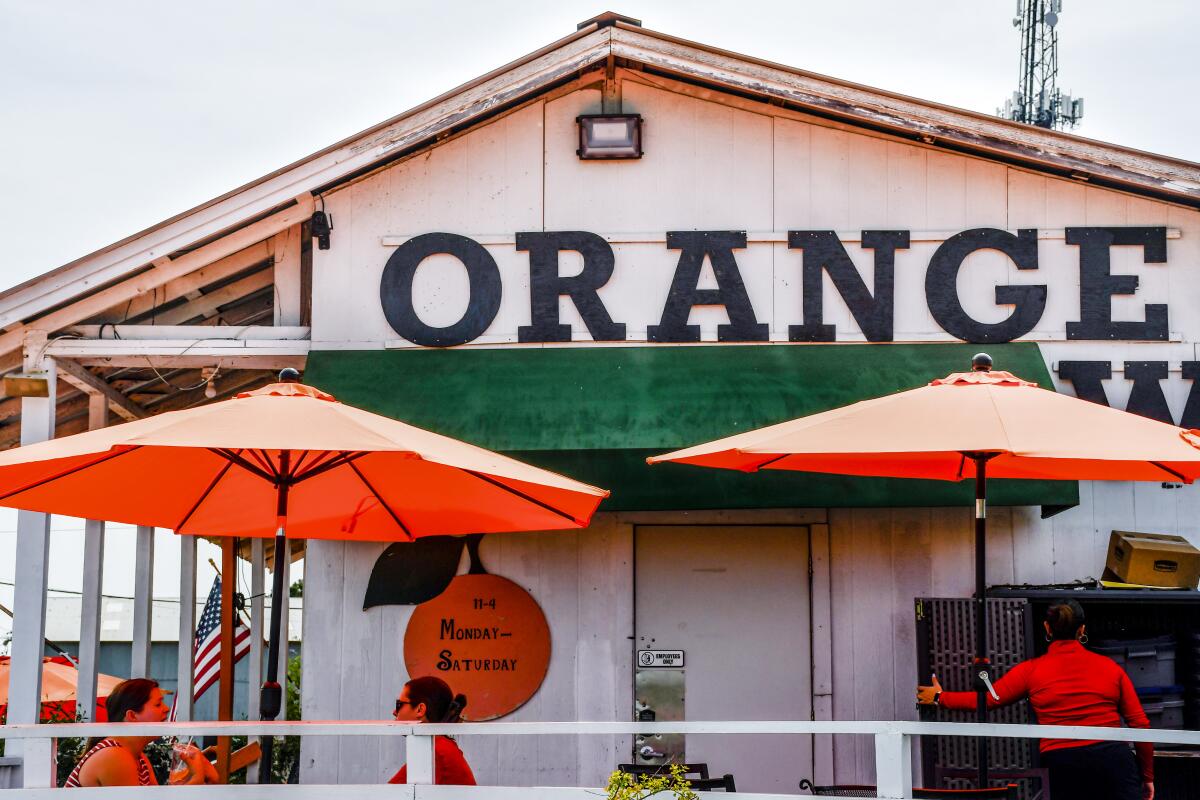
The Orange Works people (who also have a Visalia location) rotate other homemade, farm-fresh ice cream flavors too, including persimmon, pomegranate, cantaloupe and Peeps at Easter time (I’d like to see those orchards). The cafe makes turkey, ham, pastrami and roasted eggplant sandwiches, all on Mexican French rolls, a.k.a. bolillos. (Most popular: the Jacques, with tri-tip and roasted garlic.) The menu hasn’t changed in a while — “What’s not broke, we don’t fix,” said manager Eddie Khal. For $13, you can get the lunch special — a sandwich, potato chips, a drink and 6 ounces of ice cream. There are milkshakes and smoothies too. The cafe is open 11 a.m. to 4 p.m. Monday through Saturday (not Sunday, alas).
Bonus tip: The cafe expanded its patio this year, and often hosts pop-up maker markets on Saturdays. If you’re driving from Southern California to Three Rivers or Sequoia National Park, Orange Works is on the way.
74. Graze globally at L.A.’s Original Farmers Market
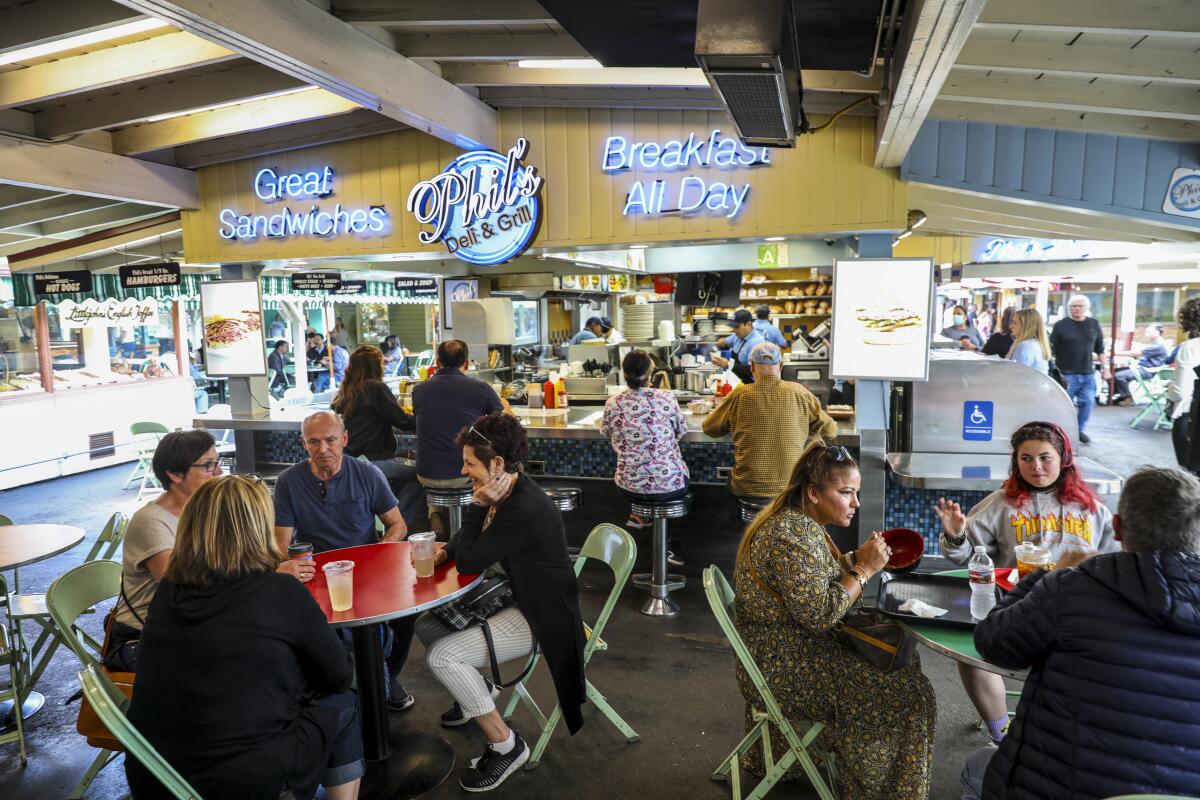
For French food, try Monsieur Marcel Gourmet Market. For tacos, Trejo’s. For pie, Du-par’s (since 1938). For coffee table books that might be larger and costlier than your coffee table itself, there’s the tightly packed 550-square-foot Taschen bookshop under the clock tower. If you’re traveling with teens or you want a full-blown shopping excursion, you’ll also need to head next door to the Grove, whose burbling fountain, circling trolley and piped-in Sinatra vocals have become part of L.A. DNA (even though the mogul behind the mall, Rick Caruso, couldn’t quite get elected mayor last year). The Grove includes more than a dozen restaurants, and 14 movie screens don’t hurt. The Grove has more parking and foot traffic but the market has seniority.
Bonus tip: For more old/new contrasts, wander among the teen-seeking streetwear shops on Fairfax Avenue between Beverly Boulevard and Melrose Avenue — the Hundreds and Solestage, for instance — and you’ll find they’re neighbored by older Jewish markets and restaurants, mostly notably Canter’s, which is open all hours.
75. Feed a beast at OstrichLand USA
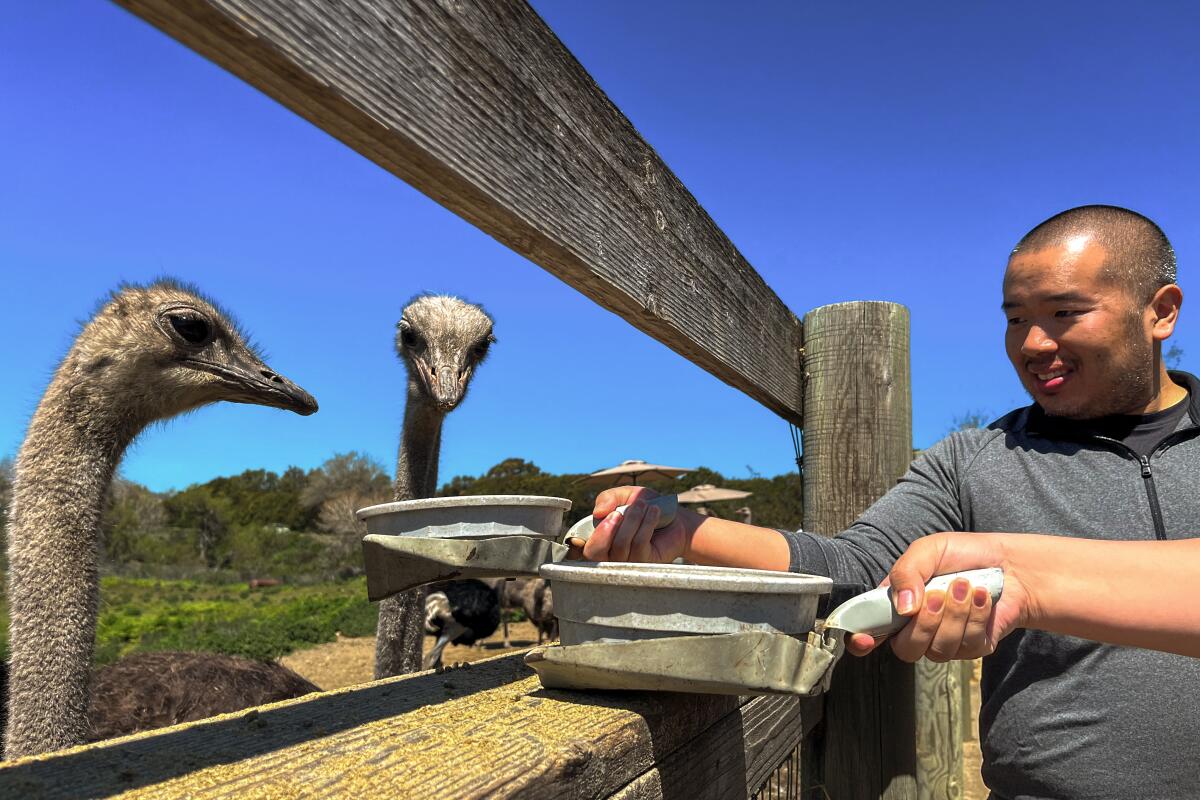
Here’s your answer: a highly affordable, not entirely predictable, close-up encounter with a living, breathing, aggressive, malodorous almost-dinosaur. That is, an ostrich. Or its cousin, the emu. OstrichLand USA is a sort of zoo where families go to see and feed more than 100 of these tall, big-eyed, sharp-beaked creatures. You pay $7 per adult ($3 for kids 12 and under), plus $1 for some pellets in a bowl, then make your way down to the wooden fence that separates people from beasts. If you have a bowl, don’t worry, the birds will find you. Just keep a good grip on that bowl, because ostriches move fast, have strong jaws and are not shy. (I didn’t see anyone get bitten in my hour there, but plenty of people were startled.) It’s open 9 a.m. to 5 p.m. daily.
Bonus tip: The ostriches are not on their way to becoming jerky. They live out their lives (as long as 75 years) on these 33 acres. Native to Africa, they reach weights of up to 350 pounds, heights of eight to nine feet. (Young ones can grow a foot per month.) They’re said to be the largest and fastest-running birds on Earth. And once they stick their beaks in your bowl, you will not be bored.
76. Peruse pickles at Oxbow Public Market
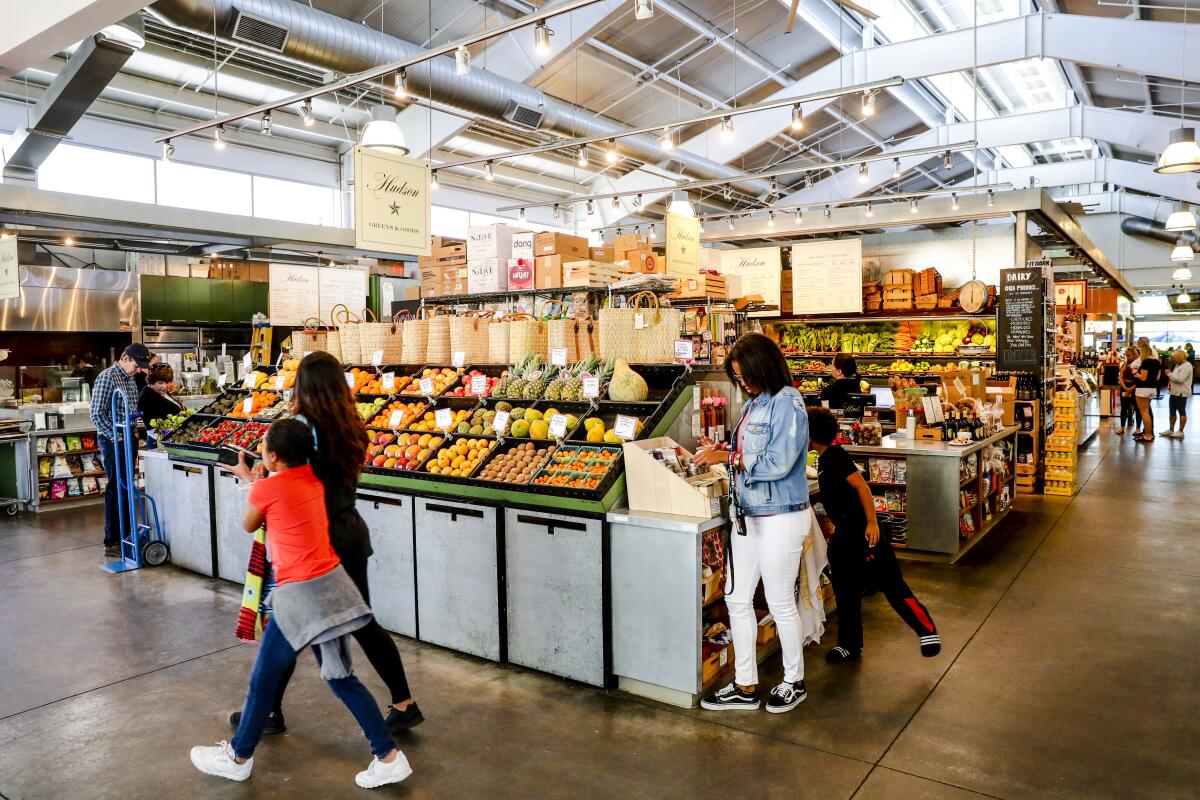
The Oxbow Public Market, which dates back to 2007, has about two dozen merchants and restaurants. They offer buffalo and duck tacos (C Casa), sushi (Eiko’s), local seafood (Hog Island Oyster Co.), house-made bagels and pickles (Loveski Deli) and much more. For variety’s sake, there’s a little bookshop too. The market is open 7:30 a.m. until 9 every night, but individual shop hours vary.
Bonus tip: The market is about two blocks southeast of the start of the Napa Valley Wine Train (which offers a journey with tea service, wine tasting, lunch or dinner at $205 to $645). It’s also two blocks southwest of the CIA at Copia, which is not a den of spies but a dining-and-education venture of the Culinary Institute of America.
77. Zip from sagebrush to snow on the Palm Springs Aerial Tramway
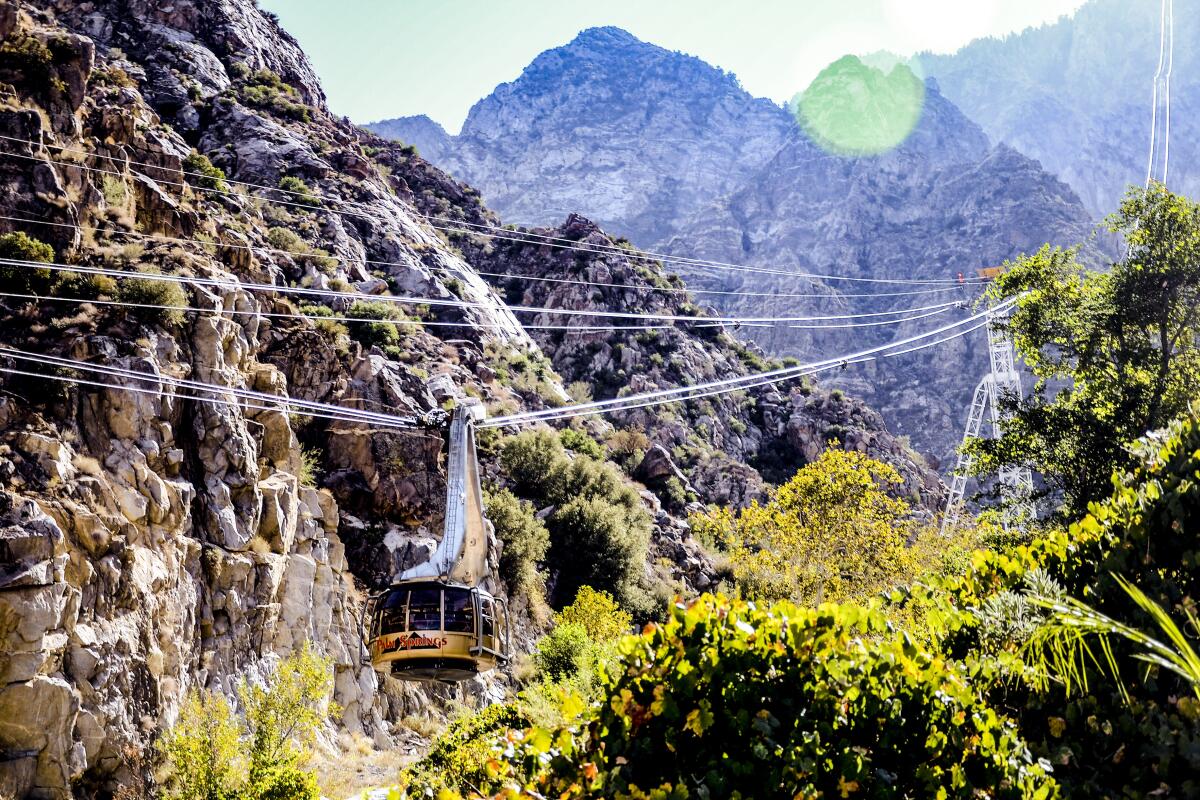
Yet it does. Because back in 1935, a man named Francis Crocker proposed connecting the Coachella Valley to the upper slopes of Mt. San Jacinto. And somehow it all lined up. Twenty-eight years later, the Palm Springs Aerial Tramway opened and here we are. After parking ($12), you step into Valley Station (elevation 2,643 feet), pay $29.95 per adult ($17.95 per child ages 3-10) and board the gondola, knowing that this year, well into summer, there likely will be plenty of snow up top. (But still, you should check.)
Then you begin the climb up Chino Canyon in a slowly rotating gondola (opening windows, capacity of 80 passengers). It’s a 2.5-mile trip to Mountain Station (elevation 8,516 feet), where it’s typically 30 to 40 degrees cooler than at Valley Station. The last tram up leaves at 8 p.m., so there’s time to catch sunset or dusk.
Bonus tip: There are a couple of restaurants at the top: Peaks is fancy, Pines is a cafeteria, and both are open for lunch and dinner. The Lookout Lounge, also up top, serves beer, wine and cocktails until 5 p.m. Alas, the Winter Adventure Center near the top of the tramway, which once rented out snowshoes and cross-country skis, is closed indefinitely. While the snow lasts, bring your own snowshoes, cross-country skis and plastic sleds (but no inflatable or metal ones).
78. Look up at the Pantages
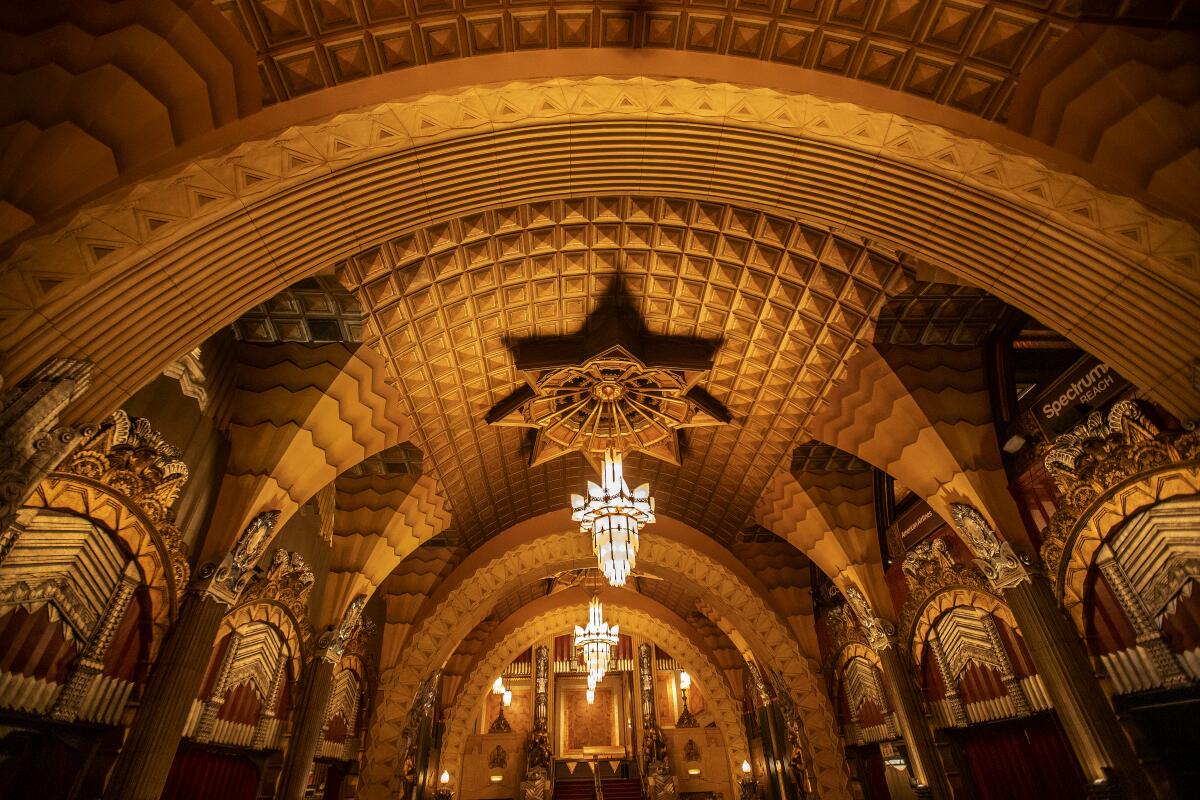
If you can, begin the night with dinner a few blocks away in the atmospheric Musso & Frank Grill (founded 1919, featured in too many movies and TV shows to count). After your show, pause to admire perhaps the coolest piece of neon in the city: the sign of the Frolic Room dive bar, right next door to the Pantages. Inside, along with the smell of spilled beer, is a vintage celebrity-studded mural by caricaturist extraordinaire Al Hirschfeld, celebrating the showbiz types who once bellied up to the very same bar.
Bonus tip: You can’t beat the vinyl and CD browsing (new and used) at Amoeba Hollywood, half a block east of the Pantages. And just across the boulevard from Musso & Frank, you have Larry Edmunds Bookshop, which bulges with books, posters, scripts, photos and Hollywood ephemera.
79. Cut loose at Pappy & Harriet’s desert roadhouse
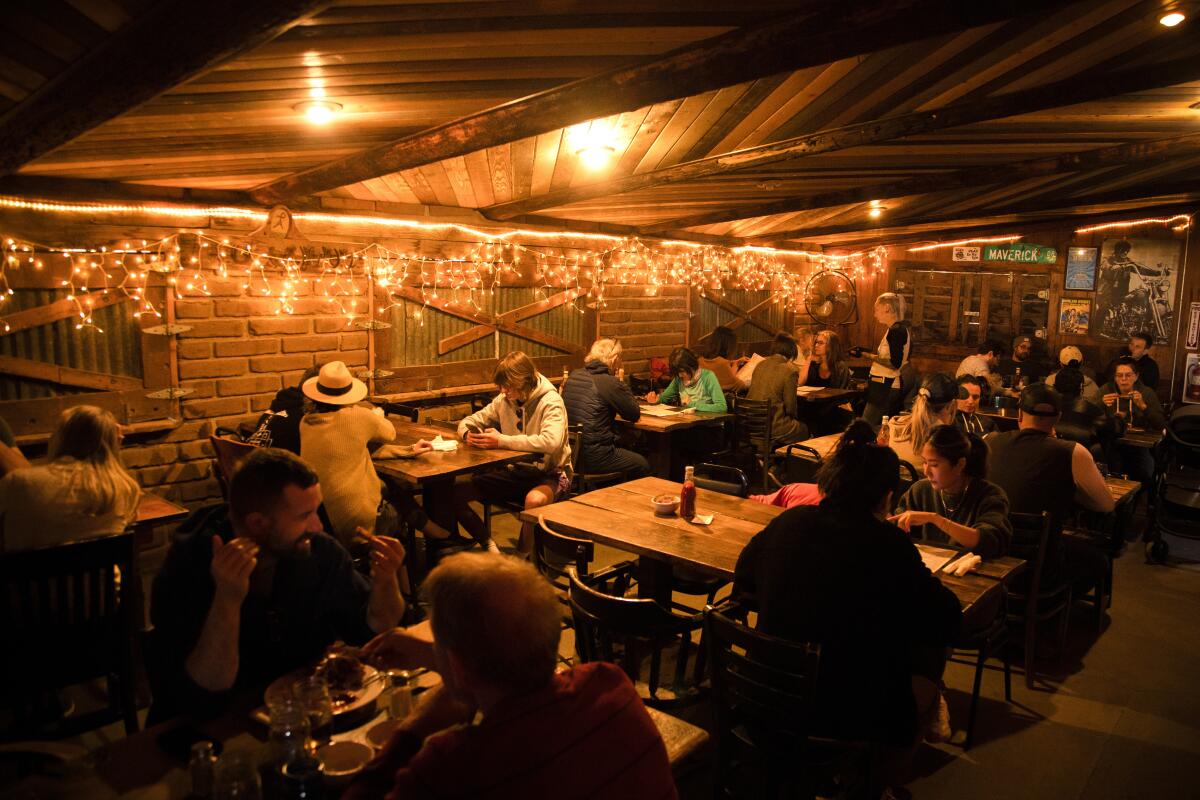
The joint, about 15 miles west of Joshua Tree National Park’s west entrance, was built as a movie-set cantina in 1946 and has operated under its current name since 1982. The current owners arrived in 2021. But it feels as native as a creosote bush.
Steaks are cooked on an outdoor grill (Santa Maria barbecue style), beer is served in Mason jars and all meal service (hearty portions) is first come, first served. A beer is $8, a burger $14. Expect lines on weekends. There’s one stage outdoors, another indoors, and there’s no telling who might show up. One night several years ago, it was Paul McCartney. Another, Lizzo. Due this summer: Rosie Flores, Andrew Bird and Patti Smith, among others, Pappy’s is closed Tuesday and Wednesday.
Bonus tip: You’ll want time to nose around the rest of Pioneertown, all of which was built as a movie set. It’s edging its way back toward becoming a true western town with a motel, saloon, twice-monthly drive-in theater and a main street that’s spelled M-A-N-E.
80. Ogle elephant seals near San Simeon

Which makes them basically irresistible. Depending on the month, you may arrive at the Piedras Blancas Elephant Seal Rookery to find hundreds of these seals basking, sparring, giving birth or mating on a ridiculously beautiful stretch of state-controlled undeveloped coastline seven miles north of San Simeon. (There’s a north beach, a south beach and a beach-cam feed designed to capture both.)
Pull off the coast highway to the parking lot and boardwalk (wheelchair-accessible), usually patrolled by volunteer docents. Stay at least 25 feet away from the seals. No dogs, no drones.
The beasts are called elephant seals because of the large proboscis grown by the adult males (which get up to 18 feet long and 5,000 pounds). In November, thousands of males begin showing up on the beach after months at sea. In December, pregnant females start gathering in “harems” around dominant males. In January and February, the females typically give birth, followed by the resumption of mating a few weeks later. In March, the adult males leave, having lost up to 40% of their body weight in fasting, fighting and fornicating. Females and weanlings leave later, returning to molt in spring and summer. Anytime you stop, you’re likely to see at least a few.
Bonus tip: Nineteenth century fishermen nearly wiped out these creatures, using their blubber for lamp oil and lubrication. Elephant seals also are common at Año Nuevo State Park in Santa Cruz County and Point Reyes in Marin County.
81. Chase condors and climb through caves at Pinnacles National Park

What it doesn’t have is easy infrastructure. There are fewer than 400 parking spaces, and no roads connecting its east and west sides. Only the east side has camping. Since it also has Bear Gulch Cave, that’s my side of choice.
But each side has trails that lead through talus caves under stacked boulders, and those trails climb to cliff-clinging paths with big views. The skies overhead are often busy with condors, turkey vultures and other raptors. (The west side also has Balconies Cave.) If you’re making a day trip from Paso Robles or Monterey via Highway 101, the west side, near the town of Soledad, is your easiest option. Admission is $30 per vehicle.
Bonus tip: Don’t go in the summer. It gets dangerously hot, and that’s when the caves are usually full of Townsend’s big-eared bats and closed to people. In cooler months, the bats hibernate and hikers are usually allowed inside. (Check the website for cave status.) And be ready for crowds on weekends, especially in the spring. On those days, rangers suggest, hikers should arrive by 8 a.m., because the parking lots fill. Clearly, plenty of people do remember this place.
82. Mingle with monarchs in a Pismo Beach butterfly grove

Butterfly season is from late October through February. The grove is free and open sunrise to sunset. Be sure to give the creatures space. And remember that their future is iffy.
The grove, a short stroll from the shore, is an unprepossessing cluster of eucalyptus and cypress trees. But look closely.
Those dirty leaves you see? They might be monarch wings. When the sun comes out, their orange hues blaze and you realize how many butterflies you’re looking at. Even if the sun doesn’t come out, docents often have a telescope trained on the biggest clumps of butterflies.
There are other popular monarch groves in Goleta, Santa Cruz and Pacific Grove.
Bonus tip: The Xerces Society for Invertebrate Conservation has advice on how to help monarchs, including butterfly-friendly plants you can grow in your yard.
83. Tiptoe among tide pools at Point Lobos

It used to be a working shoreline. Since the Gold Rush it has seen whalers; Chinese, Japanese and Portuguese fishermen; and an abalone cannery. Since 1933, the state has owned the land. Take the 1.4-mile North Shore Trail between Whalers Cove and Sea Lion Point and keep an eye out for Old Veteran, a gnarled and grizzled Monterey cypress that clings to a clifftop. Check out the blufftop Whalers Cabin, built by Chinese fishermen long ago, now a compact cultural museum.
At Weston Beach, remember acclaimed photographer Edward Weston, who made images here from the late 1920s to the late 1940s and whose ashes were scattered here in 1958. (Ansel Adams, who lived a few miles away, did a lot of shooting here too.) Don’t be surprised if you see scuba divers; for them, Point Lobos is the gateway to the abundant undersea scenery of the Monterey Bay National Marine Sanctuary. Admission is $10 per car; the 150 parking spaces often fill up, inspiring the frugal and the tardy to park along the shoulder of the highway. It’s open 8 a.m.-7 p.m. No dogs or drones.
Bonus tip: “Come in the winter when it’s stormy and no one’s out here,” Edward Weston’s grandson, photographer Kim Weston, told me several years ago. “It’s an amazing piece of land.”
84. Hike among designers’ dreams in a San Luis Obispo canyon
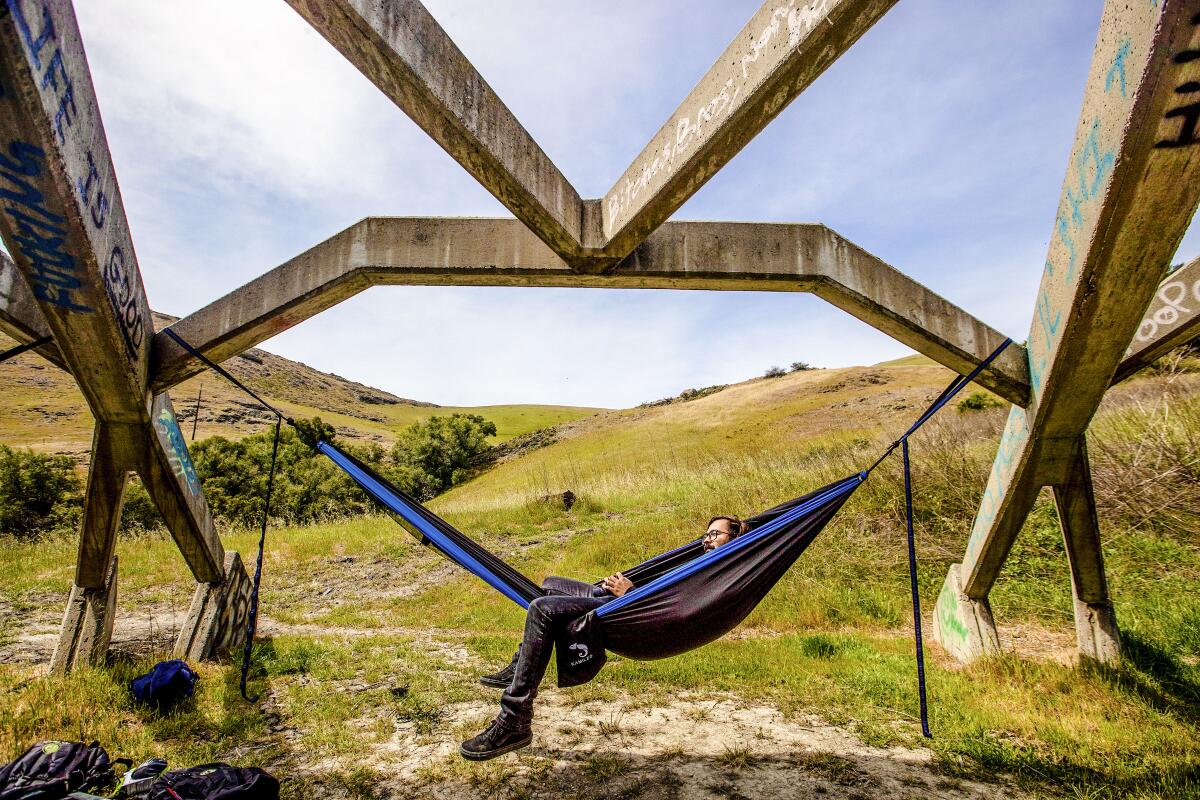
This situation goes back to the 1950s, when Cal Poly was beginning to earn a reputation as a formidable school of architecture. Designer and futurist R. Buckminster Fuller came and gave a stirring lecture about geodesic domes, inspiring five students to build one (using surplus boiler pipe) near the entrance to the Architecture Department building.
In 1963, the university moved the dome out to the northeastern edge of the campus. Since then, Poly Canyon has become a one-of-a-kind testing ground that now holds more than 20 experimental projects. The idea, architecture school dean Christine Theodoropoulos said a few years ago, is to give students an understanding that comes only “when you touch the materials.” The canyon is busiest in April, when the school’s Design Village event invites competitors to build temporary structures. The 2023 theme: Biophilia.
It’s a hike of about 2.5 miles from campus to the first structure and back. Park in Visitor Parking Structure 131.
Bonus tip: Don’t miss my favorite structure, which looks like a whitewashed Gumby doing yoga. It’s called “Hay Bale Arch” and it went up in 2004.
85. See boats and hear overtures at Rady Shell
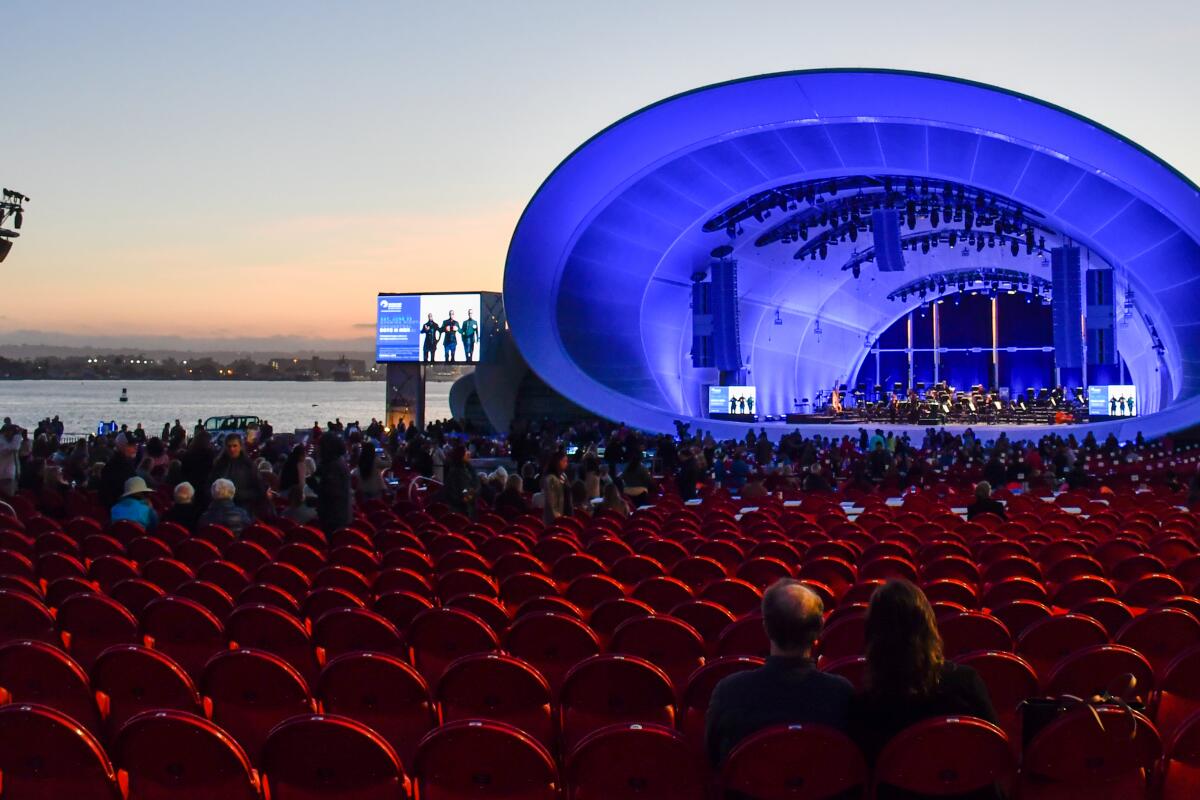
The Shell, which opened in 2021, has a layout that’s flatter and simpler than the Hollywood Bowl’s. (But you can’t bring your own picnic.) It stands on a 3.7-acre finger of land that reaches from downtown’s convention center into San Diego Bay. A few blocks to the north stands Petco Park, home to the Padres.
The Shell is home to the San Diego Symphony and a summer schedule of classical and pop shows, including “movies in concert” with the symphony playing the score. On the schedule for this summer: Mariachi Los Camperos (July 30), Trombone Shorty (Aug. 6), Van Morrison (Sept. 4) and dozens of others. From April through August, you can often eavesdrop on orchestra rehearsals on Wednesday, Thursday and Friday, 10 a.m.-12:30 p.m. The symphony posts a schedule here, to be updated in late May. (In November, the symphony unveils a $125 million overhaul of its indoor venue, the Jacobs Music Center.)
Bonus tip: On nearby Shelter Island, Humphrey’s Concerts by the Bay (next to Humphreys Half Moon Inn) has been staging summer concert series (actually spring through November) in its 1,400-seat outdoor theater since the early 1980s — offering just about every genre except classical music.
86. Watch history take flight at the Reagan Library
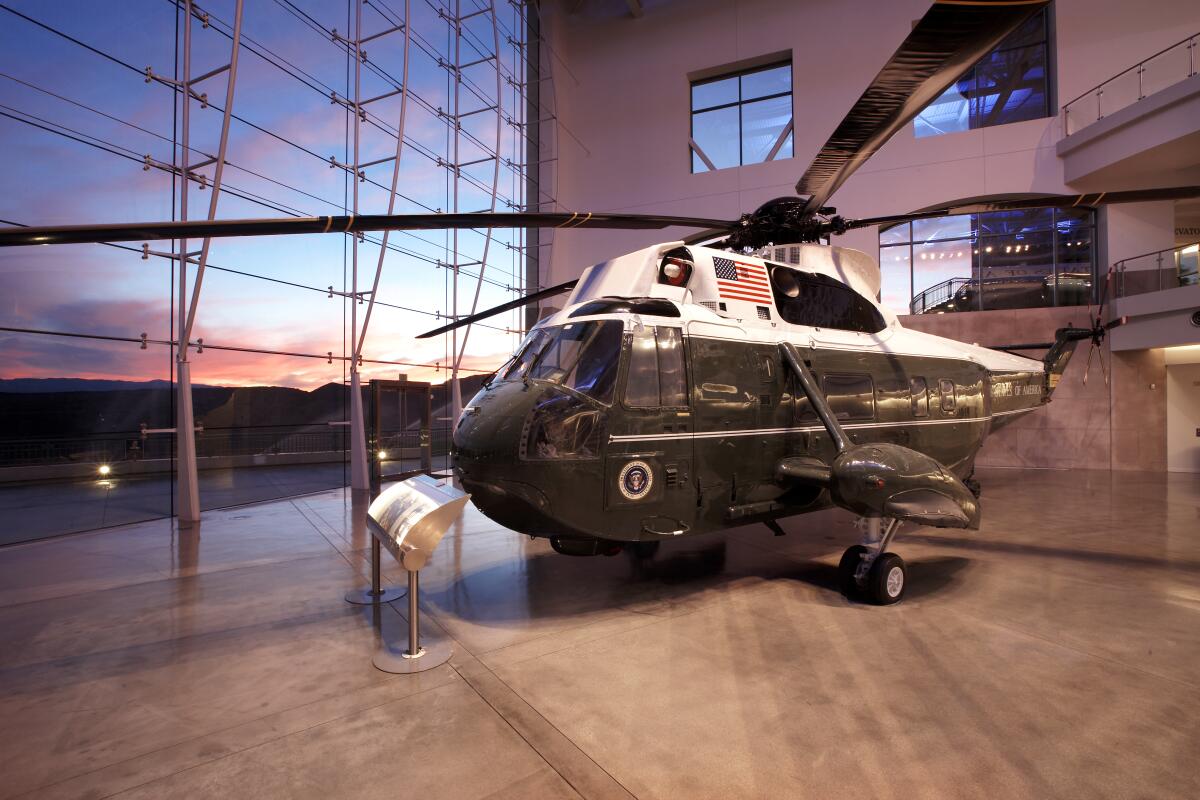
Through Aug. 13, a temporary exhibit explores Auschwitz, the Nazi extermination camp in Poland where Germany’s Third Reich government killed an estimated 1.1 million men, women and children, including 1 million European Jews, between 1940 and 1945. The exhibition is recommended for ages 12 and above.
Adult admission to the museum is $29.95 (compared to $16 for admission to the Nixon Library in Yorba Linda).
Bonus tip: Before you admire the museum’s big chunk of the Berlin Wall, read Reagan’s “Mr. Gorbachev, Tear Down This Wall” speech, delivered in Berlin on June 12, 1987.
87. Shop and gawk on Rodeo Drive
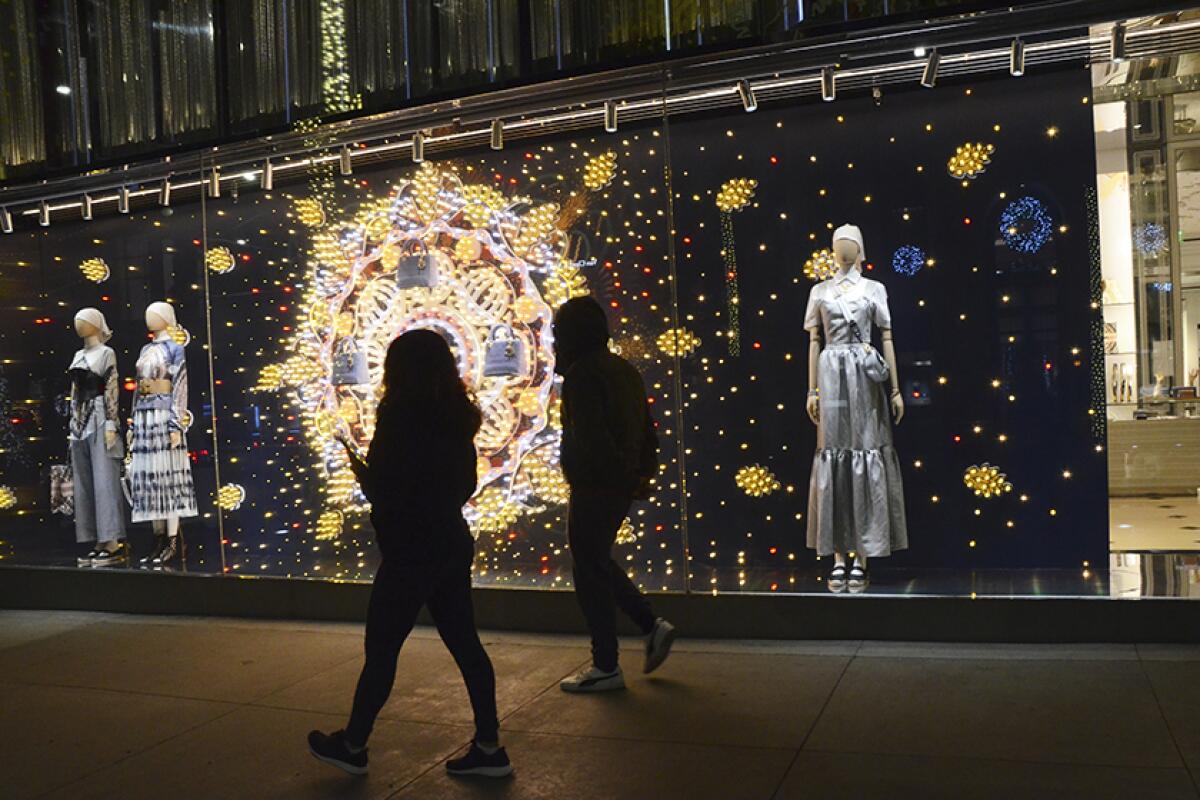
Bonus tip: Parking can be as tough as making that first $10 million. Street spots are metered at $2 per hour, with multiple structures nearby.
88. Kayak sea caves and fend off foxes at Santa Cruz Island

The island’s Scorpion Anchorage, where most visitors arrive, is about an hour’s boat ride via Island Packers from Ventura Harbor. (That’s also where the park’s visitor center is.) You can camp (one campground, 31 sites), and you can kayak in sea caves with a guide and rented vessel from Channel Islands Adventure Co. Or hike to Smugglers Cove and back. To the east of Smugglers Road, you’ll see that portion of the island is recovering from the 1,411-acre Scorpion fire of 2020. Still, it’s easy to imagine when the island was a working ranch, and before. Nowadays, the park service controls about a quarter of it, including Scorpion Anchorage. The other three-quarters of Santa Cruz is off-limits, owned by the Nature Conservancy.
Whether you’re camping or just picnicking, keep an eye out for island foxes: The once-embattled population is now so numerous and bold that one may well take a run at your picnic table. Lock up your food.
Bonus tip: There’s another channel island closer to the mainland than Santa Cruz. It’s tiny Anacapa, where you can find a 1932 lighthouse, spectacular views, two miles of trails, a minuscule campground (seven sites, no water) and enough swooping, shrieking seabirds to trouble Alfred Hitchcock’s dreams. From March through August, gulls nest there and — well, let the park service explain: “Visitors will encounter seabird rookery conditions: guano, strong odor, constant noise, bird carcasses, and birds protecting their territory. If visitors consider these conditions adverse, it is advised that they visit another island.”
89. Melt into the scenery at Sea Ranch

From its start in the 1960s, the development has tangled with some environmental groups. Many say frustration over Sea Ranch helped provoke the creation of the California Coastal Commission in 1972. Yet the project also has won design prizes from the American Institute of Architects.
There’s no denying that these handsome homes have been tucked into a beautiful place. It includes six publicly accessible trails, a links-style golf course and a tiny but emblematic chapel of stone, redwood and stained glass by artist-designer James Hubbell. Rental homes typically go for $275 to $1,000 nightly, often with minimum stays of three to five nights. (Sea Ranch Lodge itself serves as a rental representative for seven homes.) All of Sea Ranch’s roads and most of its trails are private and intended for use only by owners, renters and their guests.
The Sea Ranch Lodge Dining Rom offers lunch and dinner (Thursday-Monday) and a cafe serves snacks, breakfast and lunch, daily.
Bonus tip: After an ownership change, a renovation and a delay or two, ranch management says it will begin renting out the 17 guest rooms in the Sea Ranch Lodge in July, starting at $500 nightly.
90. Chow down at a 626 Night Market
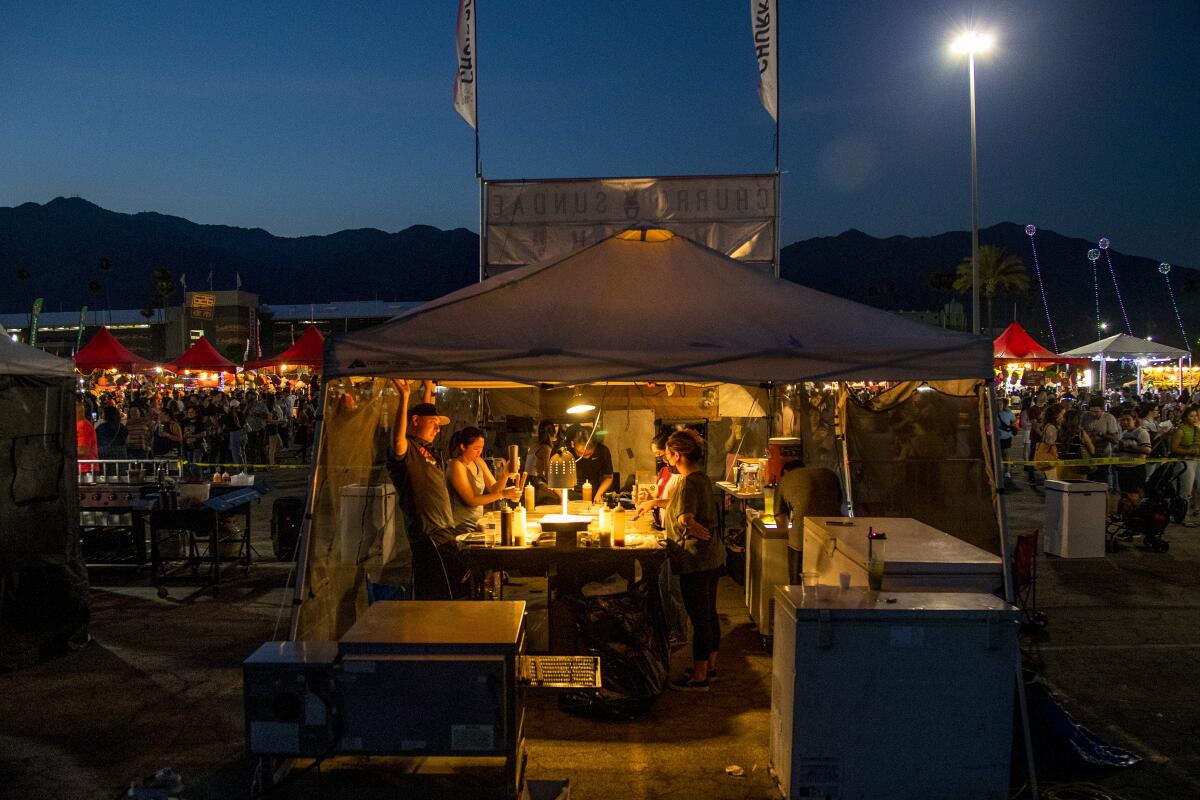
The event, created by Taiwanese American Jonny Hwang in 2012, is inspired by the innumerable after-dark marketplaces that thrive throughout Asia, especially Taiwan, and named for the area code of heavily Asian San Gabriel Valley. Now, however, market events — typically staged on weekends in fairgrounds-type settings — are scheduled in not only Arcadia but Santa Monica (May 27-28), downtown San Diego (May 27-28), Costa Mesa (June 2-4; June 9-11; Aug. 25-27), Pleasanton (May 26-28; July 28-30) and Las Vegas (May 20-21).
The flagship 626 Markets continue to happen at Santa Anita Park racetrack in Arcadia. This year’s dates are June 30-July 2; July 7-9; Sept. 1-3 and Sept. 8-10, with more than 250 vendors expected at each. Admission is $5 (for $9 you get a three-day weekend pass) and gates are open 4 p.m. to midnight. Parking is free. (The Santa Monica and San Diego markets usually feature 30 to 40 vendors.)
The markets include traditional street food, but they’re also snack labs, full of hybrid and experimental tastes and smells. Wandering the Santa Monica market last year, I sipped macadamia nut ice-brew coffee, which nicely washed down the bulgogi dumpling from a stand nearby. The pho tacos, snorkel-shaped Hawaiian honey cones and red velvet cake infused with red wine? Maybe next time. Art, crafts and live entertainment are part of the scene too. You’re allowed to bring in blankets, folding chairs, sealed water bottles, diaper bags and service dogs, but not backpacks, outside food, alcohol, cannabis or therapy animals.
Bonus tip: Most vendors accept credit cards, Apple Pay or Venmo, but bring some cash just in case.
91. Flash back in Sonoma’s Plaza
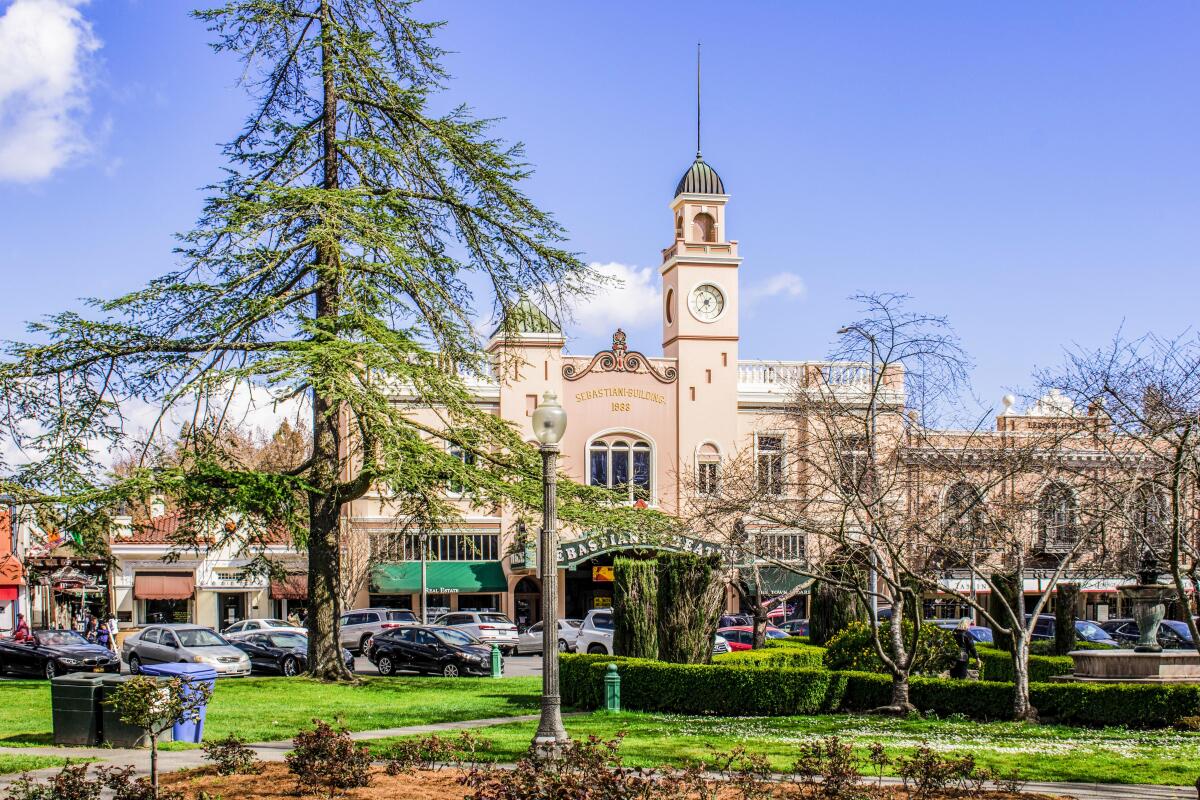
This didn’t last long, but it gave someone time to design a flag with a bear. And it showed Mexico’s vulnerability. By 1848, the U.S. had grabbed control of Alta California.
Now Sonoma County includes some of California’s most coveted real estate. It has more than 425 wineries, and there’s still a bear on the state flag. Downtown Sonoma (population: about 10,700) is filled with bistros, tasting rooms and shops.
Don’t miss Sonoma State Historic Park, which includes Mission San Francisco Solano de Sonoma, founded in 1823. You’ll find a commemorative display, added in 1999, listing names of the baptized Native “neophytes” buried in the cemetery — more than 800 of them. At most California mission cemeteries the Native dead go unnamed, but the keepers of the Sonoma mission, a unit of the state park system, made this gesture of respect a priority.
Bonus tip: On my last visit, I liked the country-French fare and feel of the Girl & the Fig at the plaza’s northwest corner. Two great venues outside town for wine-tasting and history: Gundlach Bundschu Winery (since 1858) and Buena Vista Winery (since 1857).
92. Stroll Sunnylands like a billionaire on holiday
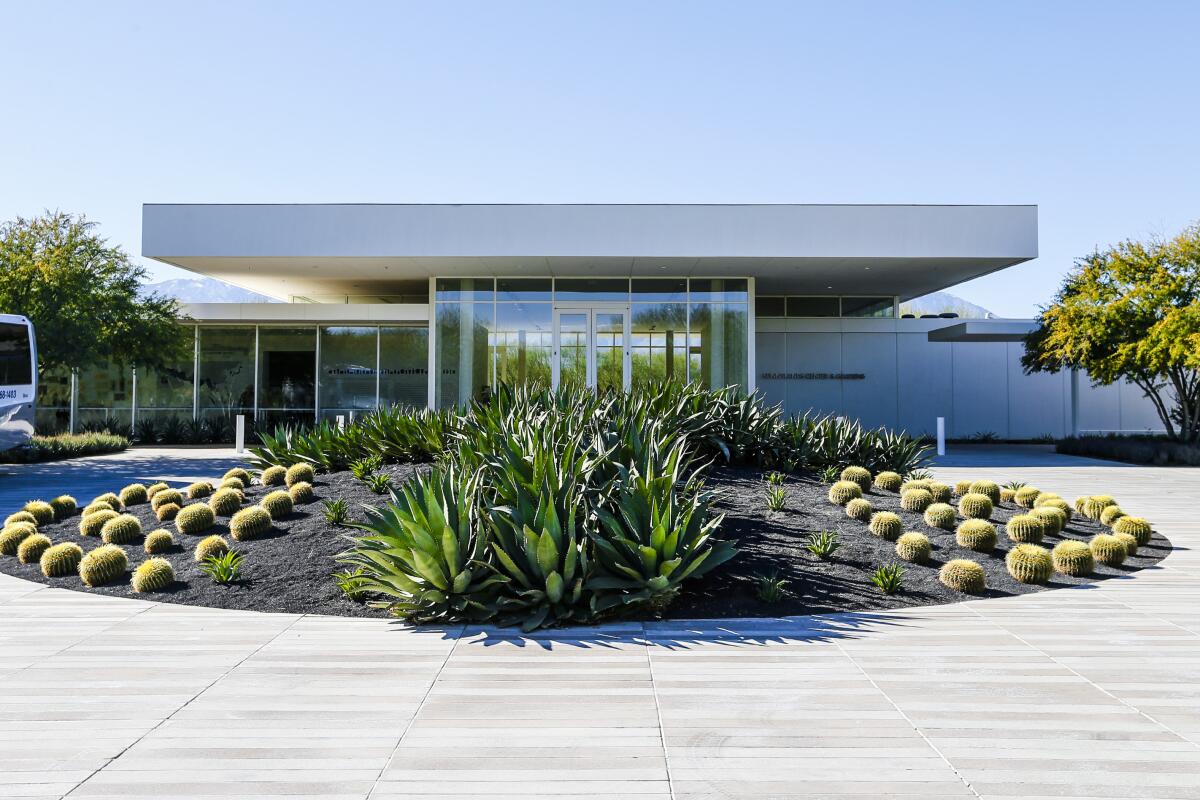
In 2012, after the billionaire couple’s deaths, the Annenberg Foundation opened the 15-acre Sunnylands Center and its succulent gardens, including a cafe, gift shop and reflecting pools, to free public visits, Wednesday through Sunday. From fall through spring you can tour the main home or the rest of the estate, but you’ll need a timed ticket, reserved up to a month in advance. (The property closes in summer months.) The four available tours include a 90-minute house tour ($55) and a 60-minute outdoor walking tour ($26, November through April).
Bonus tip: Grab lunch from the cafe, then sit back on the patio and imagine you’re Barbara Marx, former wife of Zeppo, about to marry another entertainer, a guy named Frank Sinatra. That happened here in 1976.
93. Take wing atop the Torrey Pines cliffs
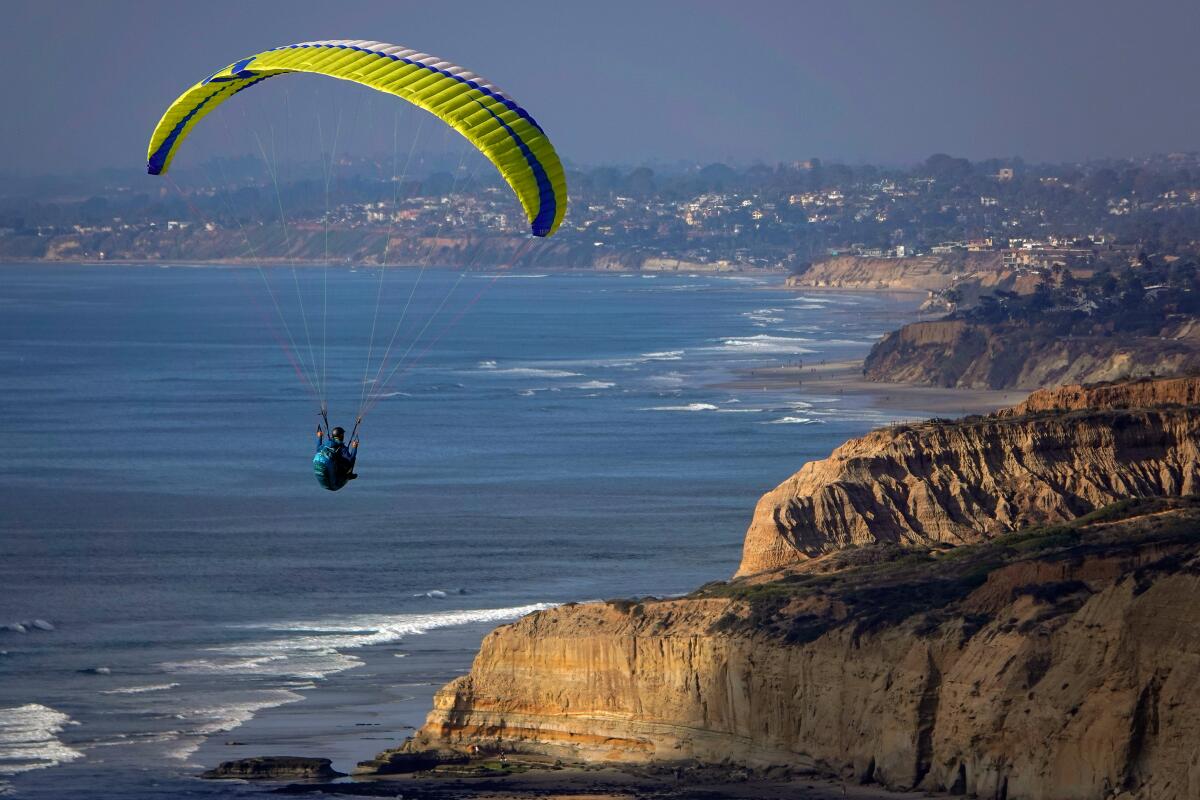
At the gliderport, you can sign up for a $175-$255 tandem paragliding flight — I’m not brave enough for that — or grab breakfast or lunch at the Cliffhanger Cafe (nothing costs more than $11.25). Then settle in at a picnic table and watch the skies. There are often live bands on Saturday afternoons (May through September). See the shoreline about 350 feet below? That’s Black’s Beach, accessible by a steep, half-mile trail. (It has a nude zone.)
Sail planes were taking off here as early as the 1920s. In 1930, Charles Lindbergh glided nearby. Hang gliders joined in the 1970s, then paragliders, then tandem paraglider flights, which now dominate the skies, in part because they are more versatile in wind.
Bonus tip: Next door you’ll find the Salk Institute, whose austere, ultra-symmetrical 1965 Louis Kahn design has made it an architectural landmark. (There are self-guided and docent-led tours on weekdays, but not weekends.) Across North Torrey Pines Road you have the UCSD campus, including the many playful outdoor artworks of its Stuart Collection and, playing straight man, the brutally top-heavy geometry of its Geisel Library (design by William Pereira).
94. Catch a train at the last grand station in America

Take a good look at the high ceiling, the grand arches and the 286 built-in mahogany chairs (for ticket-bearing travelers) in the waiting area. Whether you’re going to step aboard or not, you can get lunch, dinner or a drink at the cavernous Homebound Brewhaus (where a Fred Harvey restaurant stood in the old days) or you can hope your timing is right for Traxx Restaurant (11 a.m.-7 p.m. weekdays only). The Traxx bar, across the hall, is open until midnight daily.
Bonus tip: Across Alameda Street stands Olvera Street, a mostly Mexican marketplace created in the 1930s to boost tourism on one of the city’s oldest streets. Results: mixed. Walkways are lined with souvenir vendors, eateries and a handful of shops, including the popular Olverita’s Village. Long before, the city of Los Angeles was founded here in 1781, when 44 newcomers of Native American, African and European heritage arrived by foot from what is now Mexico, joining the indigenous Chumash and Tongva tribes here already. Olvera Street is part of the El Pueblo de Los Ángeles Historical Monument, which includes LA Plaza de Cultura y Artes and the Chinese American Museum.
95. Roam the decks of the USS Midway Museum
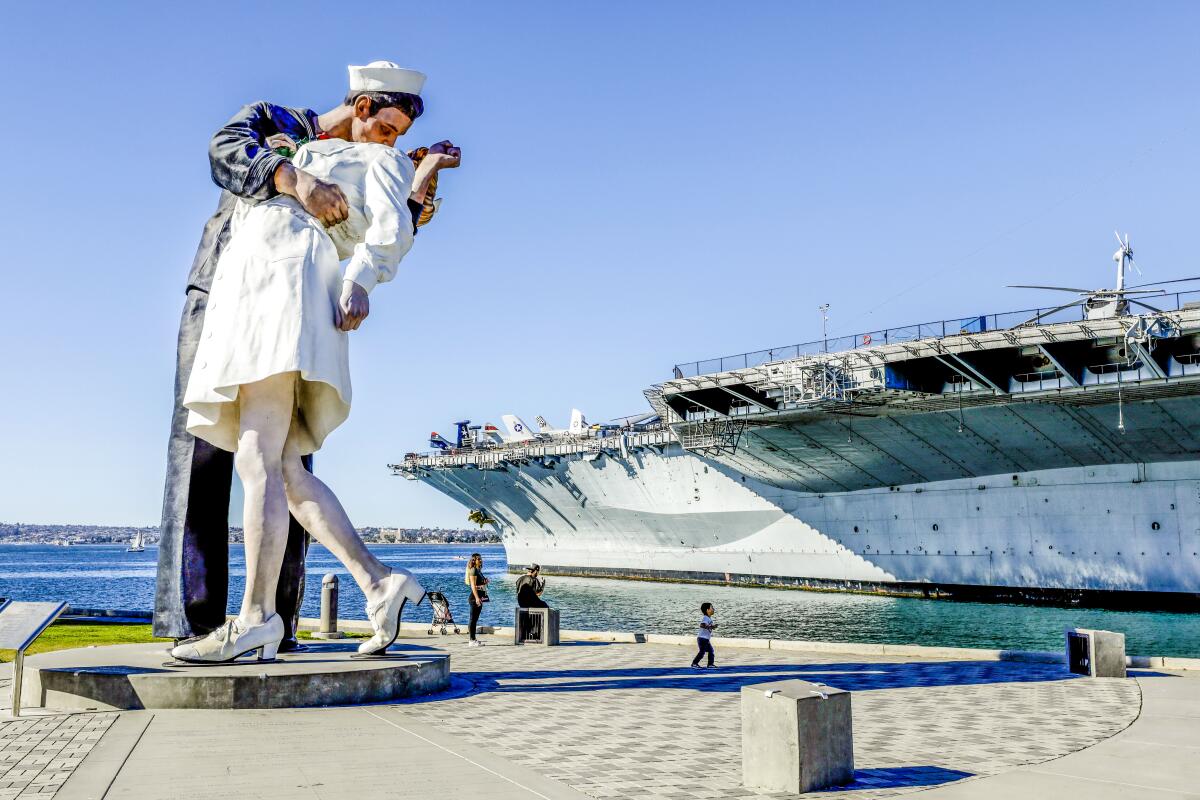
Bonus tip: Just a mile north of the Midway along the Embarcadero, the Maritime Museum of San Diego has gathered nine historic vessels for your inspection. The marquee attraction is the Star of India, an iron-sided windjammer built on the Isle of Man in 1863. In its lifetime, the ship has been trapped in Alaskan ice, run aground in Hawaii and been owned by the San Diego Zoo, and has circled the world 21 times. Adult admission is $20.
96. Stride or glide on the Venice Beach boardwalk

Take in the careening teens at the Venice Skate Park, the busy basketball courts, the fishing pier, Muscle Beach bodybuilders and the quirky Small World Books. Save time (or another day) for the canals just south of South Venice Boulevard and the upscale restaurants, galleries and shops along Abbot Kinney Boulevard. Depending on the block, and on the latest chapter in the city’s struggles to help house the homeless, you may find many tents or not.
Parking can be tough but there are three nearby county lots. Get there early.
Bonus tip: The Sidewalk Cafe (at Horizon Avenue) is a prime place along Ocean Front Walk to sit and watch people. The Venice Ale House (at Rose Avenue) is another.
97. Walk around and wonder at Watts Towers

Part of the towers’ mystique is the mystery of what Rodia was thinking. He handed the deed to a neighbor and walked away in 1954. He died in 1965. Since then his towers have survived recurring neglect and incompetence by public agencies, followed by more careful restoration in recent years. The towers have inspired many local children to pursue creative careers (including celebrated assemblage artist Betye Saar, jazz great Charles Mingus and rapper-philanthropist Nipsey Hussle). The site now is protected as a state historic park and neighbored by a community arts center. The area inside the triangular property’s walls is closed indefinitely for restoration work, but you can see plenty from outside the fence. If you can get there on a Thursday or Friday, there are free, guided half-hour tours from 11 a.m. to 12:30 p.m. and 1:30 p.m. to 3 p.m.
Bonus tip: To learn more about Black culture in South Los Angeles and beyond, head to the California African American Museum in Exposition Park (eight miles north of the towers).
98. Watch waves crash and coast crumble on West Cliff Drive
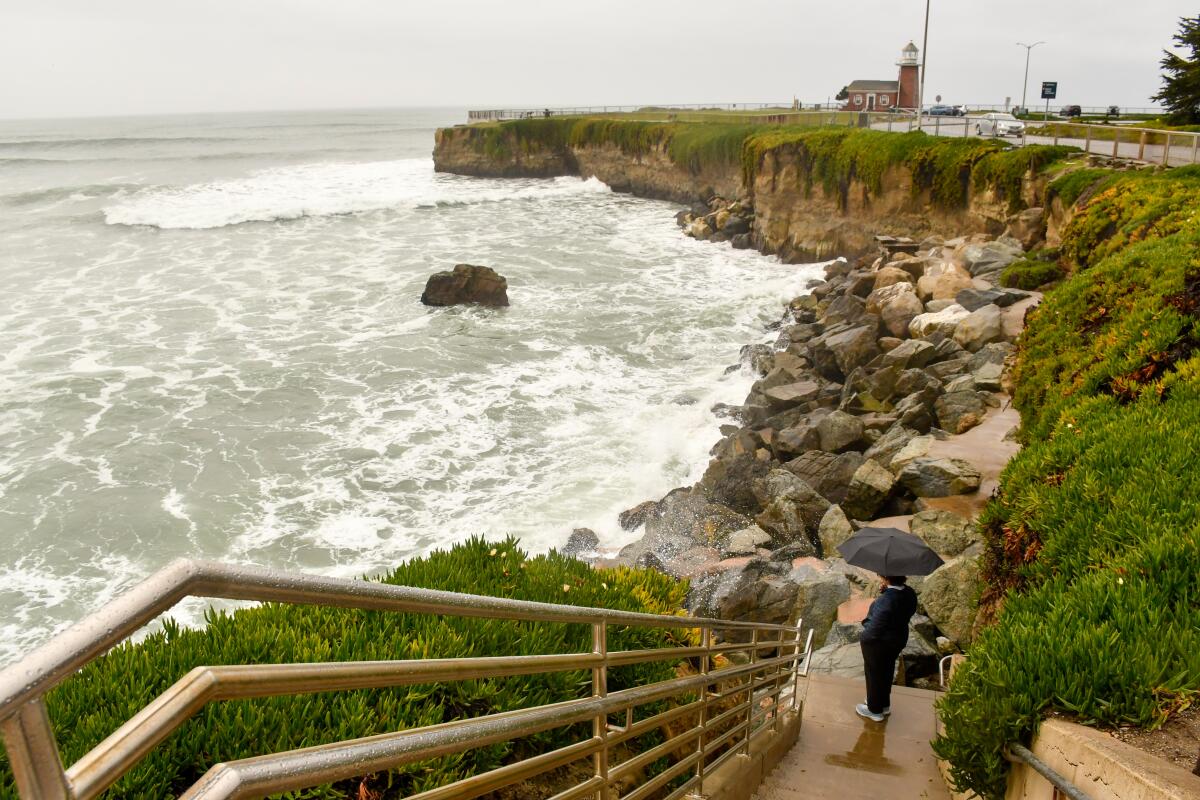
Begin at the Municipal Wharf and follow the road as it wriggles west along the coast. This blufftop route takes you past great old houses, bold new houses, the Steamer Lane surf break, a little redbrick lighthouse (which has a tiny surfing museum inside) and a tall bronze surfer at Pelton Avenue. (No, really bronze. It’s a statue, 18 feet tall.) After three miles you reach Natural Bridges State Beach, which is not big (a scant 65 acres) but is well-placed, with one beach, tide pools, shore birds, a eucalyptus grove where monarch butterflies gather in fall and winter and an emblematic natural rock bridge. Day-use fee: $10 per vehicle.
Bonus tip: The park is called “Natural Bridges” because there used to be another natural bridge. It fell into the sea in 1980.
99. Chase whales off San Diego
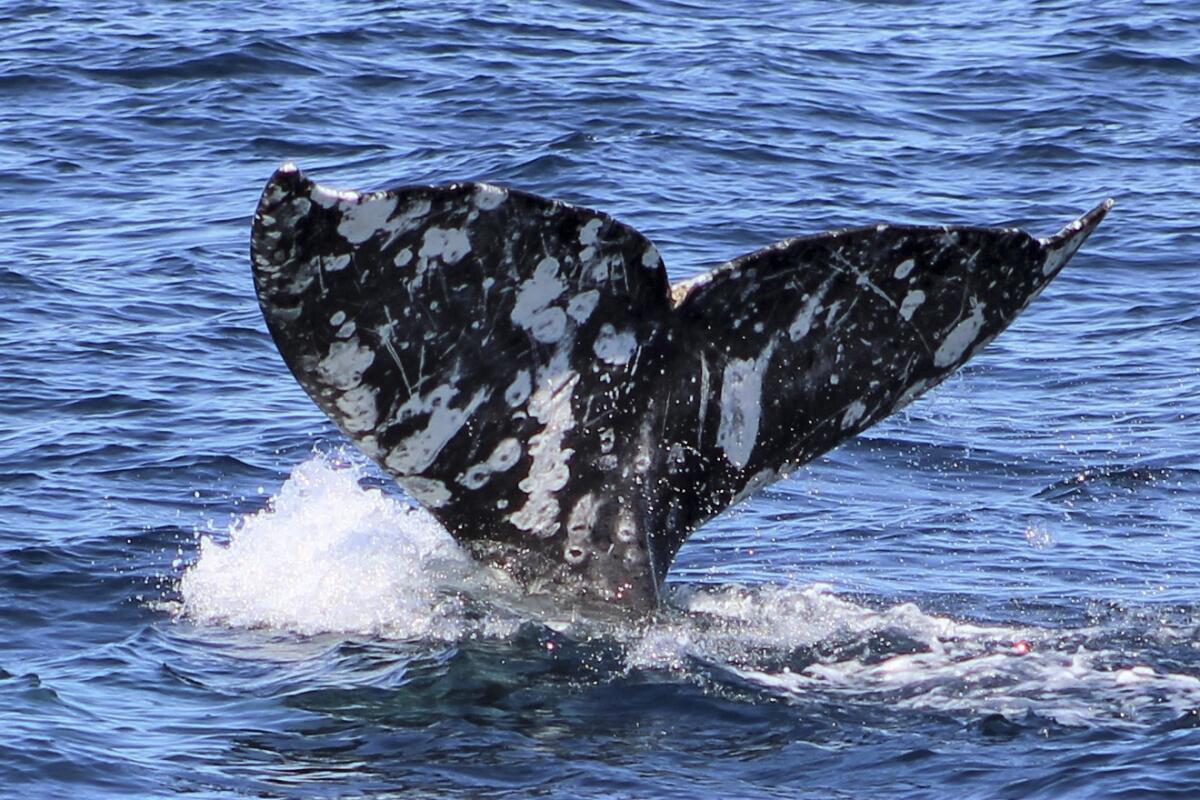
There are plenty of whale-watching excursions from Orange County and L.A. County too.
If you don’t want to wait until winter, blue whales swim through the same coastal waters May through November. Also, as San Diego Whale Watch likes to remind people, sightings of fin whales, humpback whales and minke whales are possible year-round. And whenever you go out, you may come across pods of dolphins, often leaping in the surf.
Winter whale excursions typically last two to four hours and cost $35 to $65 per adult. On any of those boats, you should hear plenty about the wonders of Eschrichtius robustus (the gray whale), which grows up to 50 feet long and weighs up to 36 tons. Often, the Oceanic Society points out, one whale’s barnacles and whale lice can add up to 400 pounds. (Is anybody else feeling itchy now?)
Bonus tip: You can also look out for whales from the shore. The best bet is high ground like Torrey Pines State Natural Reserve in La Jolla and Cabrillo National Monument on Point Loma.
100. Go museum-hopping on Wilshire Boulevard
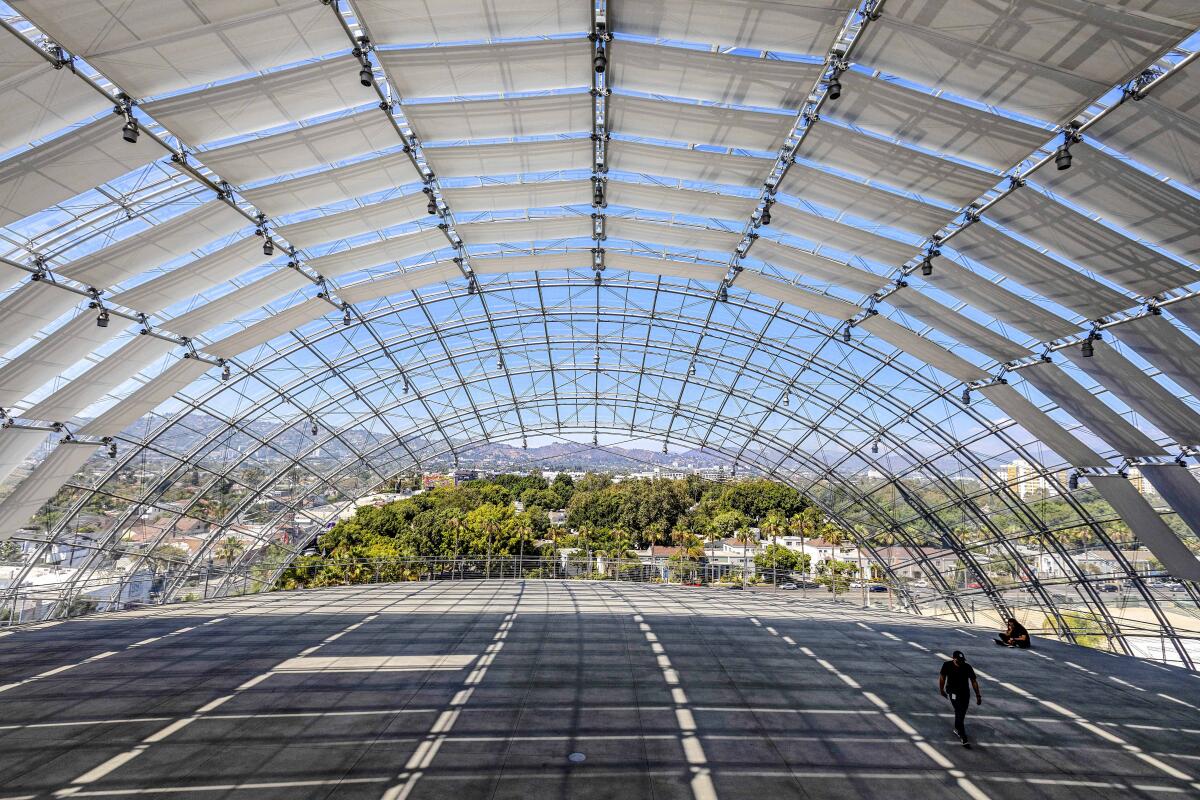
Bonus tip: Though LACMA’s new main building won’t be done until 2024, several parts of the museum remain open, including indoor exhibits and the outdoor lamppost constellation of Chris Burden’s installation “Urban Light,” one of the city’s most popular selfie spots. Meanwhile, a Metro subway station is due to open at Wilshire and Fairfax in 2024, boosting public transit options between the museums and downtown.
101. Hear Yosemite Valley roar

But listen to rangers and be careful. As of May 16, flood worries had closed the valley’s Housekeeping Camp and North Pines Campgrounds, along with the park’s western gateway, Highway 120, a.k.a. Big Oak Flat Road. The park’s southern entrance, Highway 41, was open.
Another factor: The valley may be crowded this summer, especially weekends. This is the first time in four years that the park hasn’t required advance booking for summertime day-tripper visits to the valley. Aim for a weekday. Start early. Get away from cars as fast as you can. Park admission is $35 per car.
Bonus tip: Remember, the valley is just six square miles in an 1,187-square-mile park. If you can, drive into the high country (especially Olmsted Point, Tuolumne Meadows and Tenaya Lake) via Tioga Road, which usually opens in May or June, but might not open until July this year. The spectacular Glacier Point Road, closed for repairs in 2022, is due to reopen “no earlier than July, probably later, due to heavy snow and construction,” rangers say.

